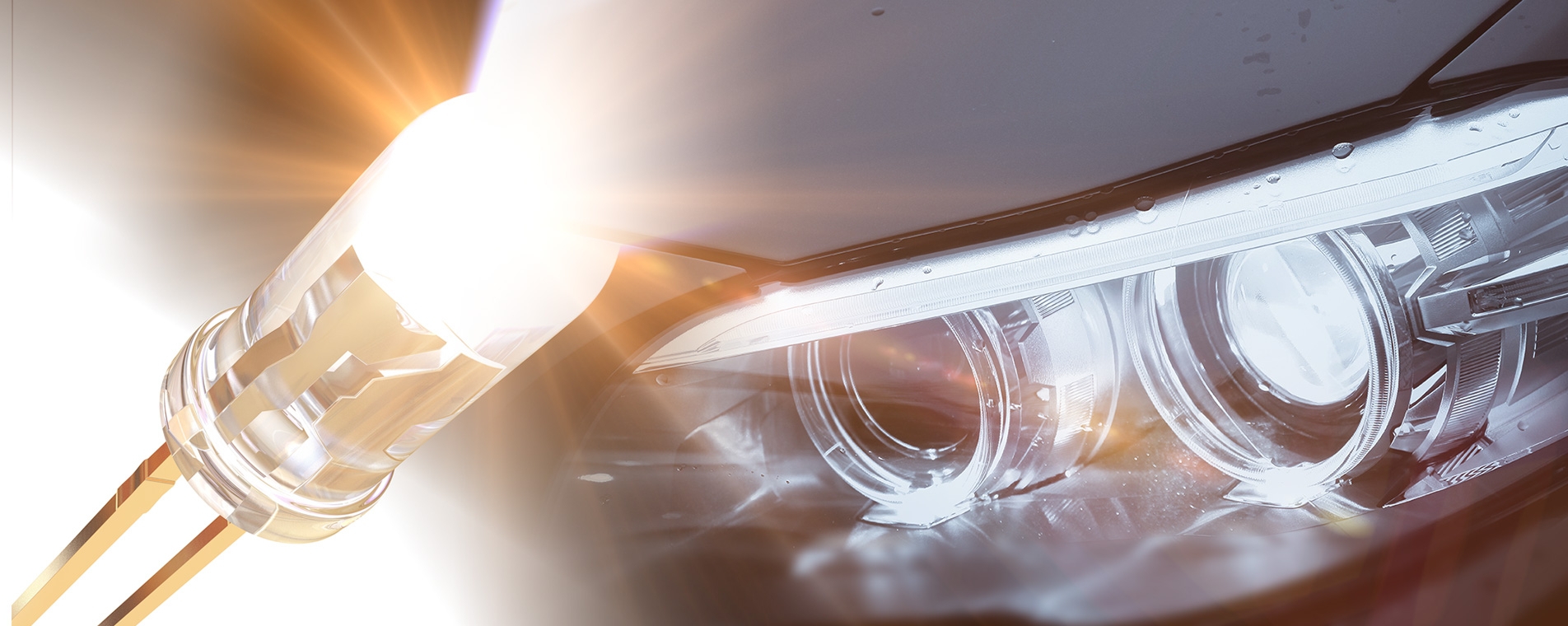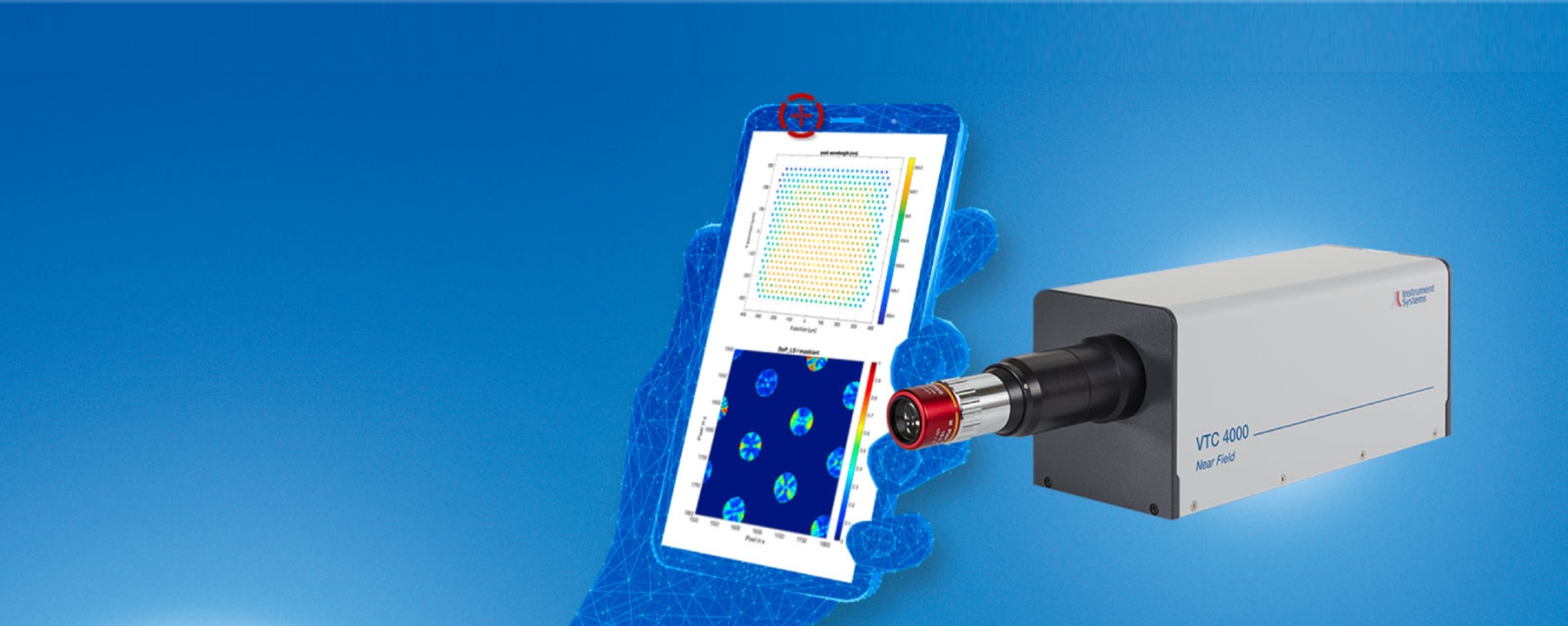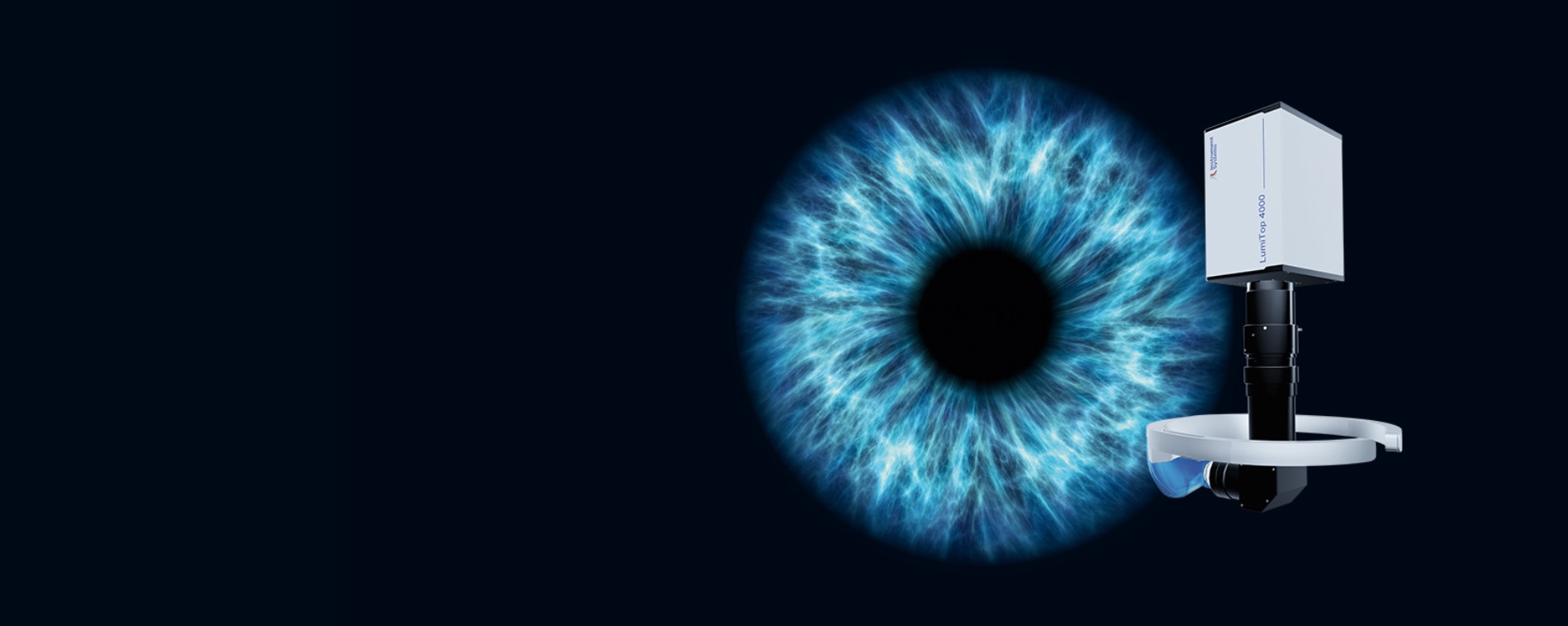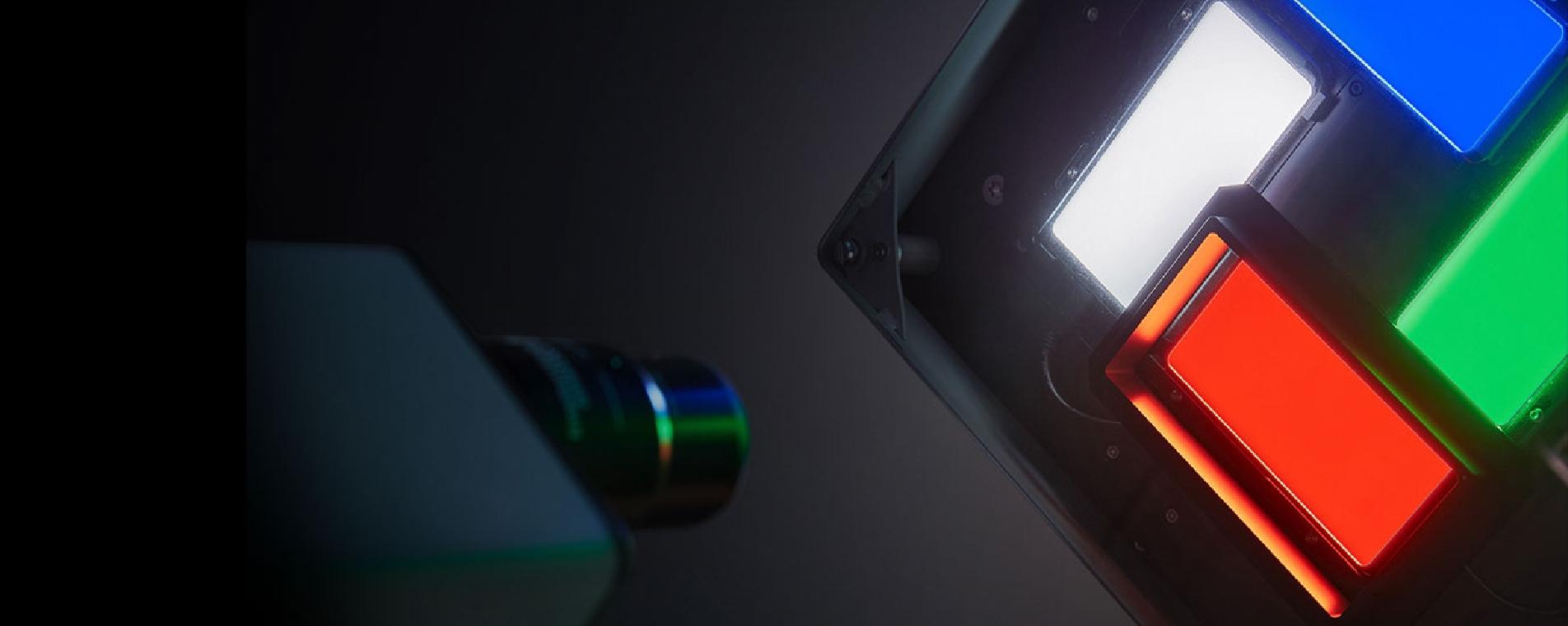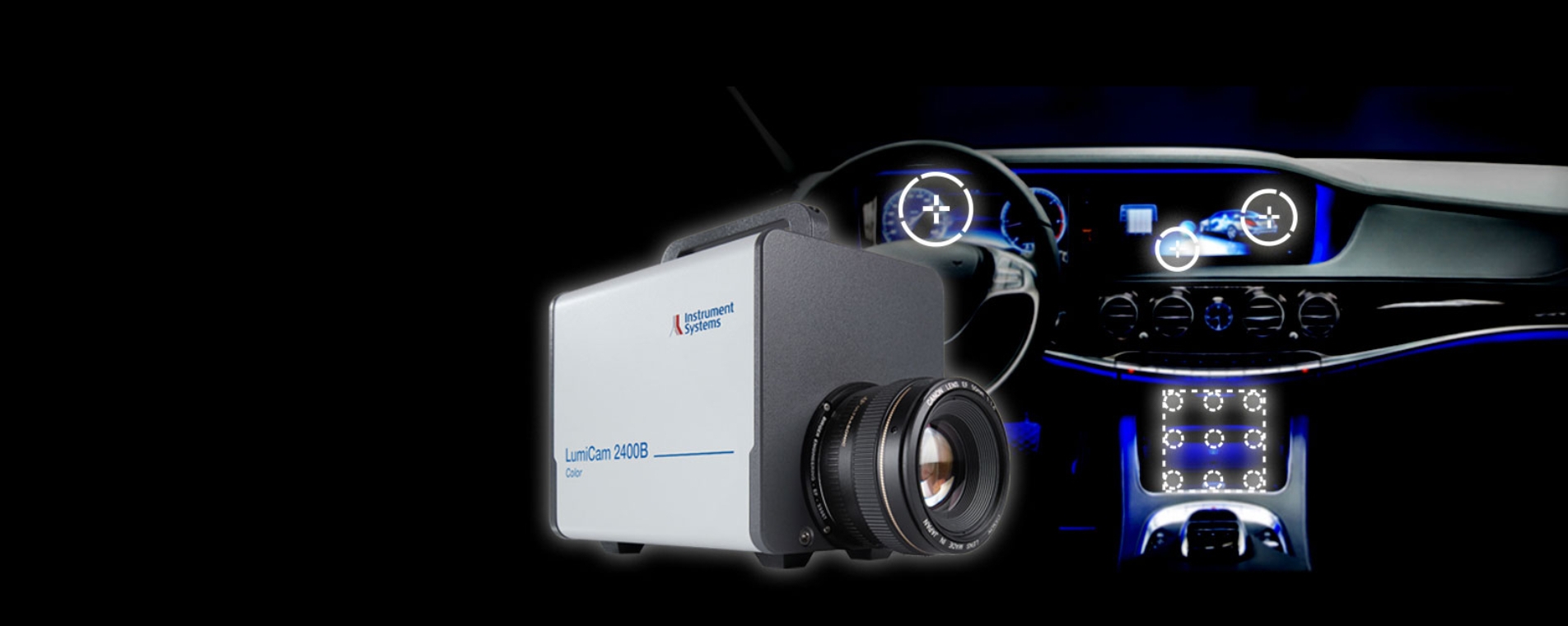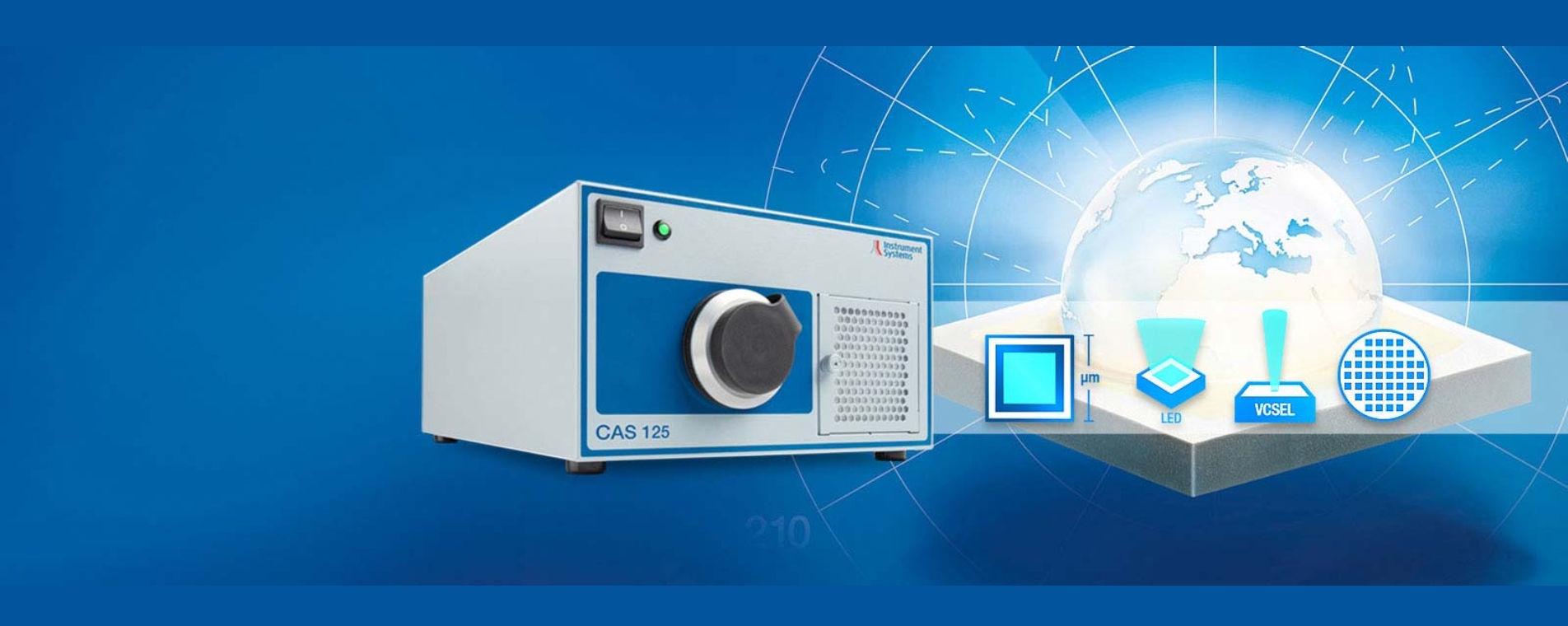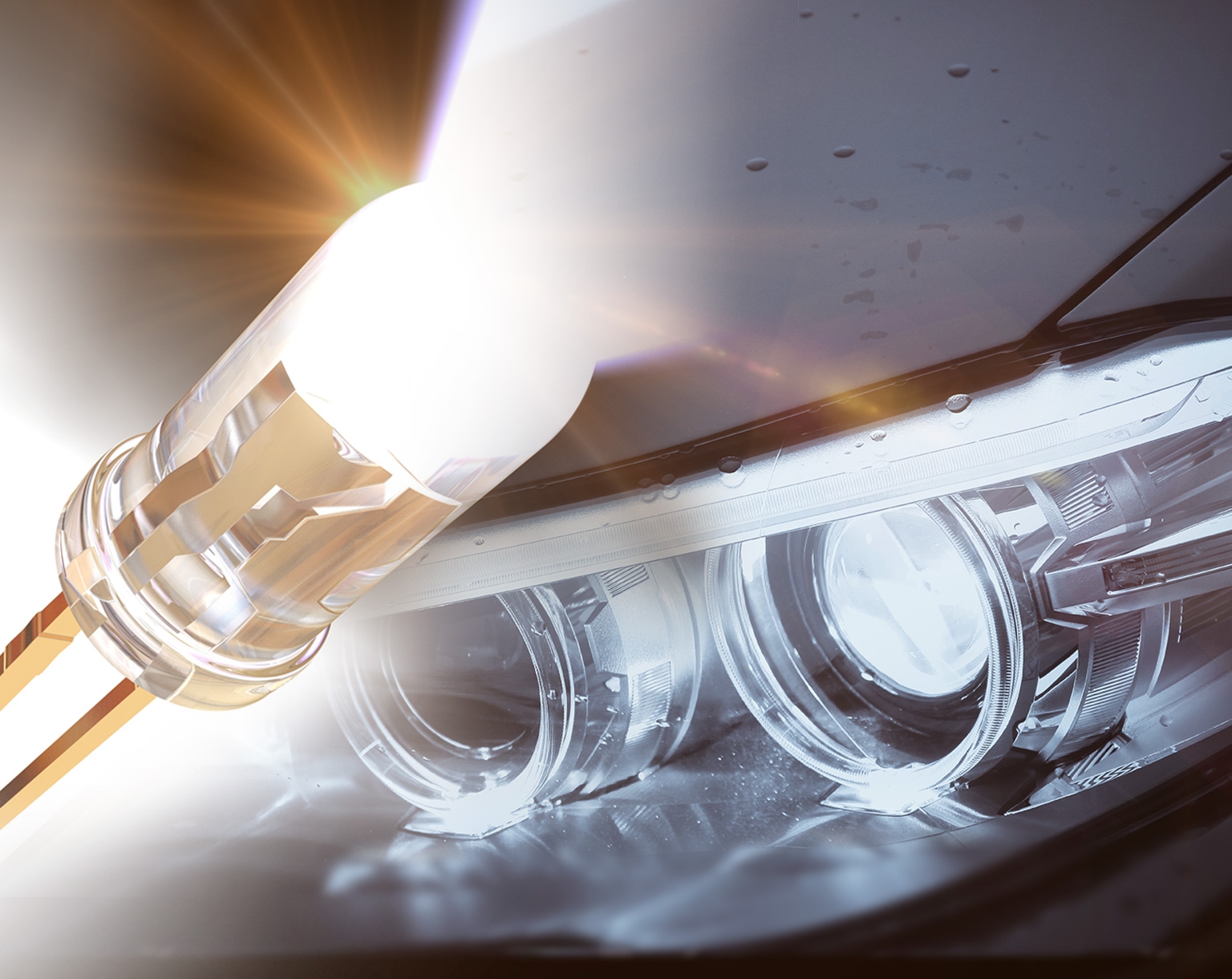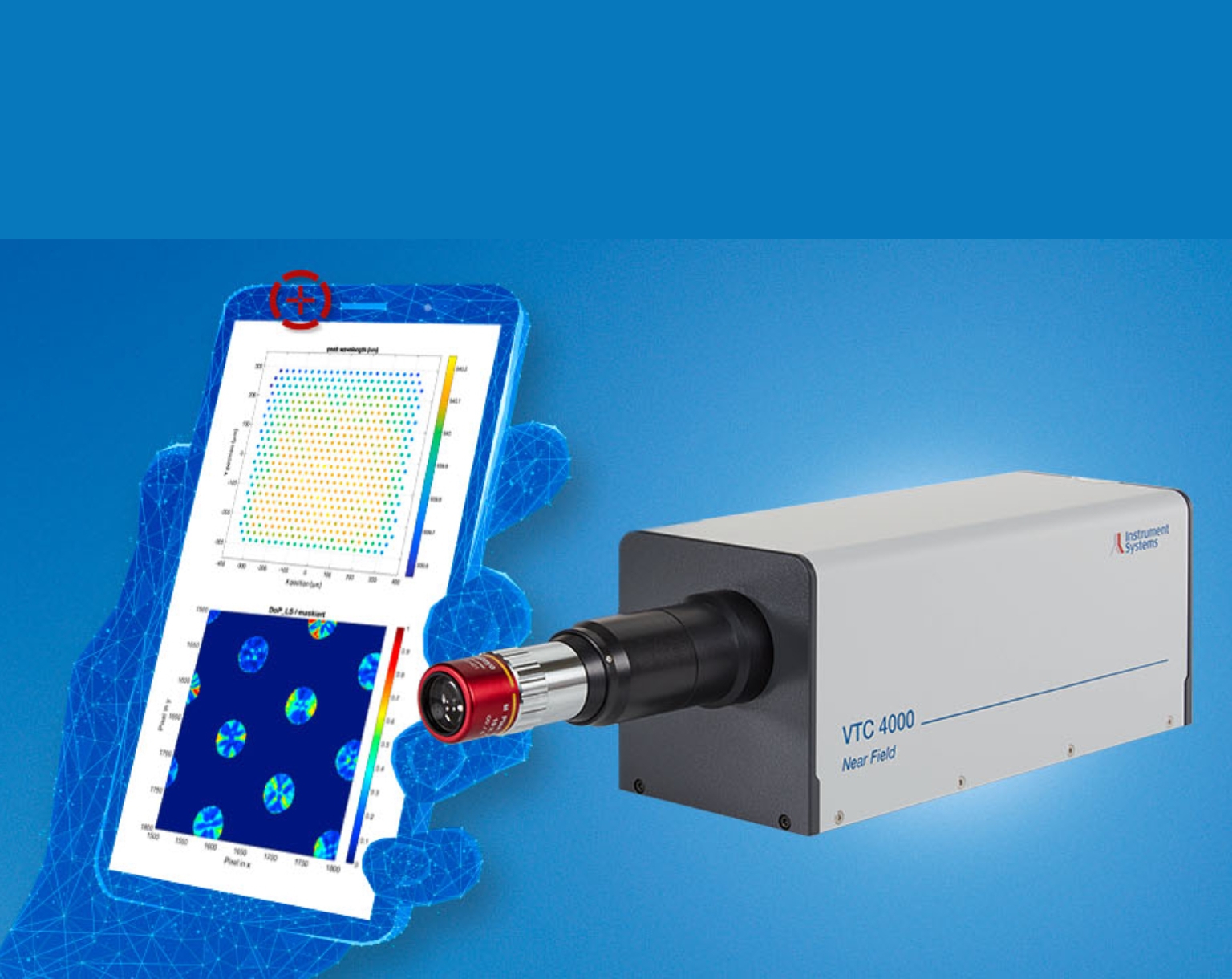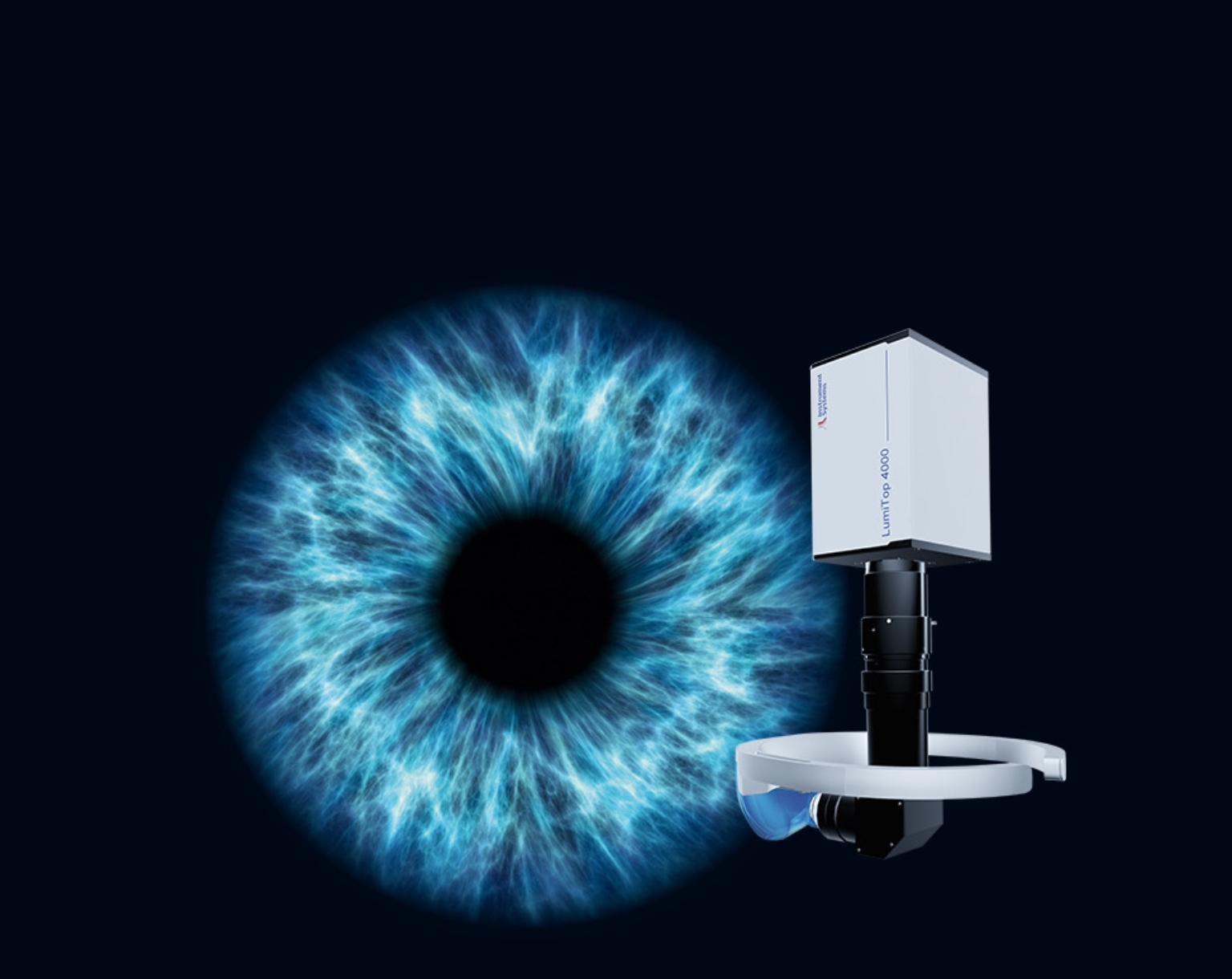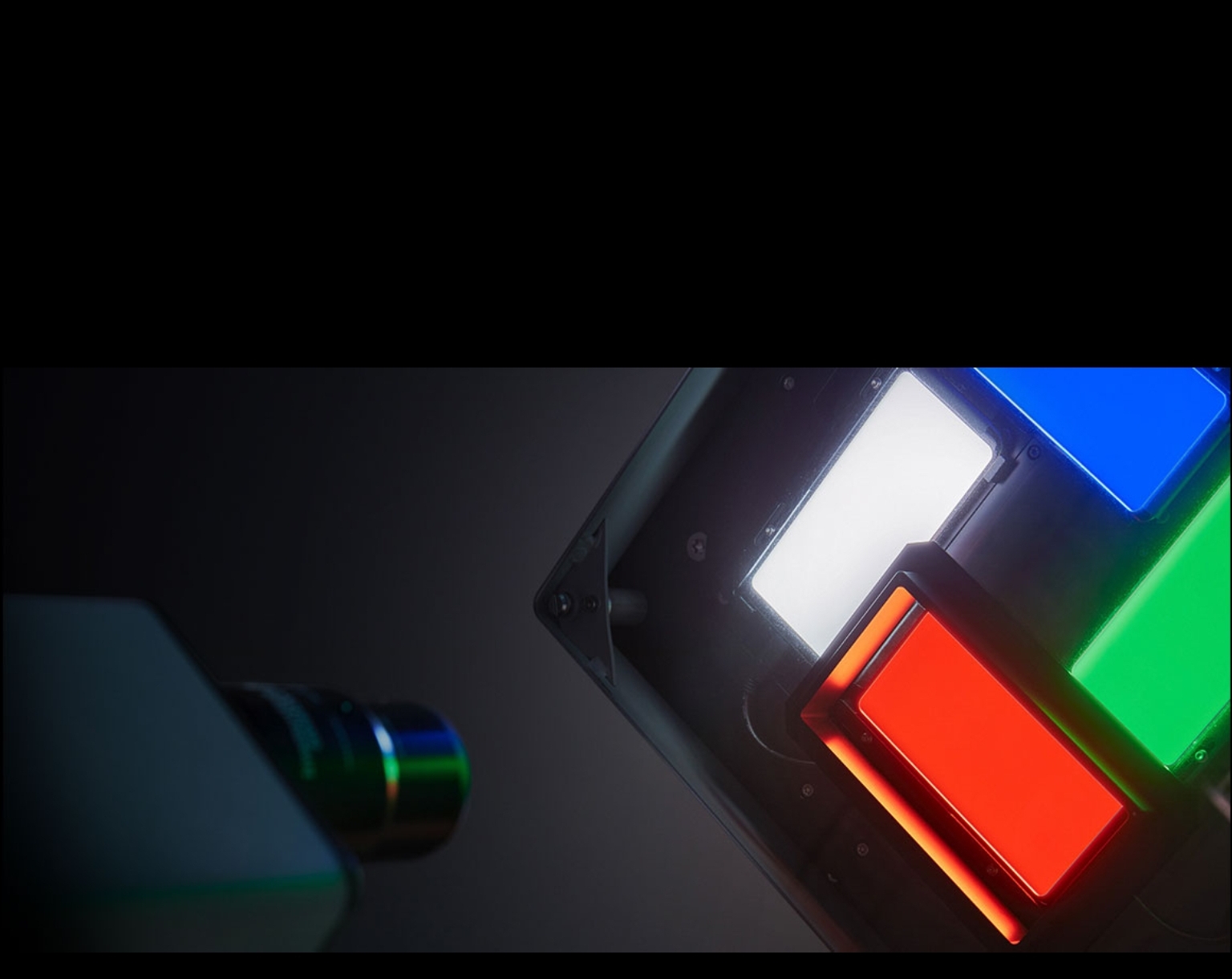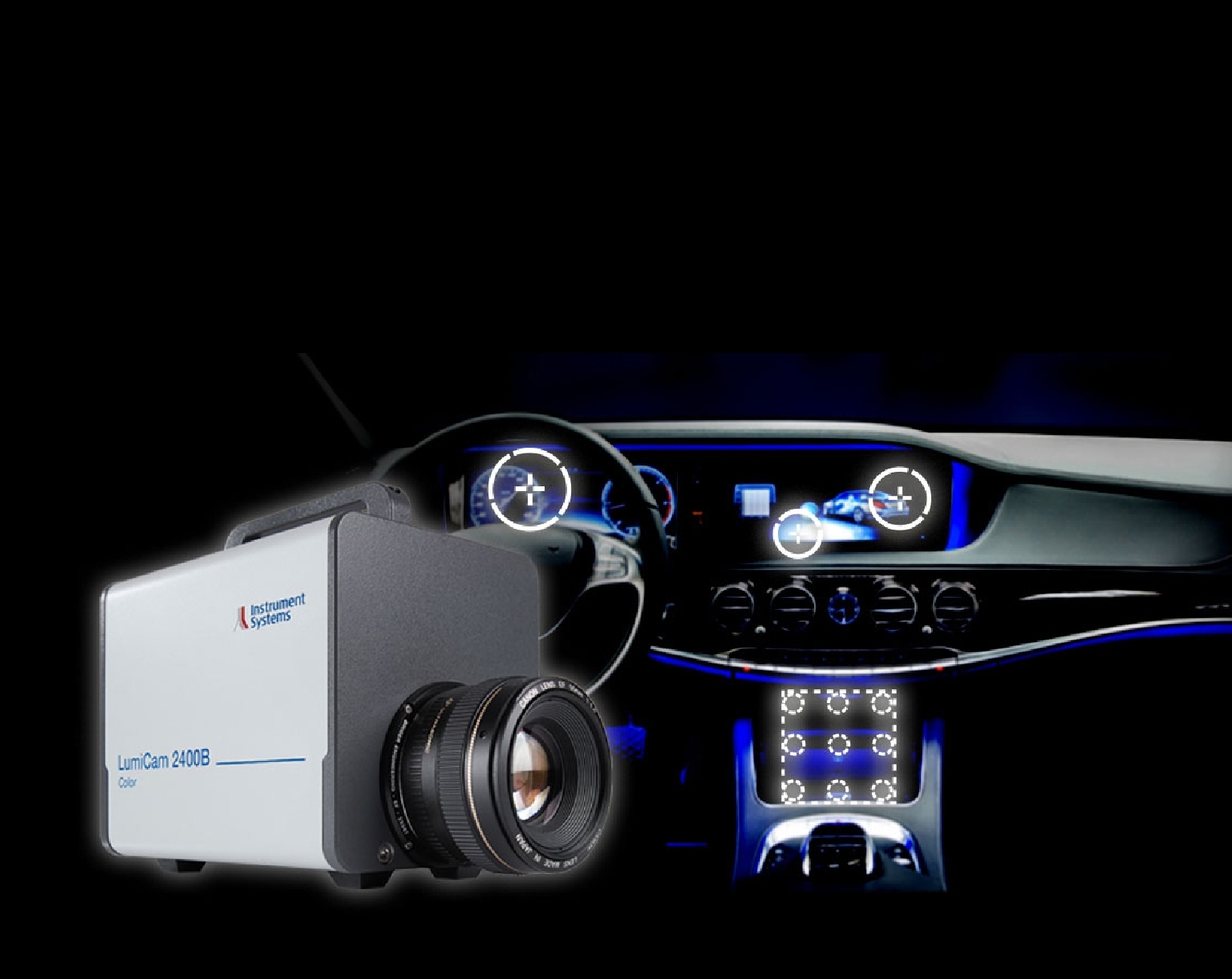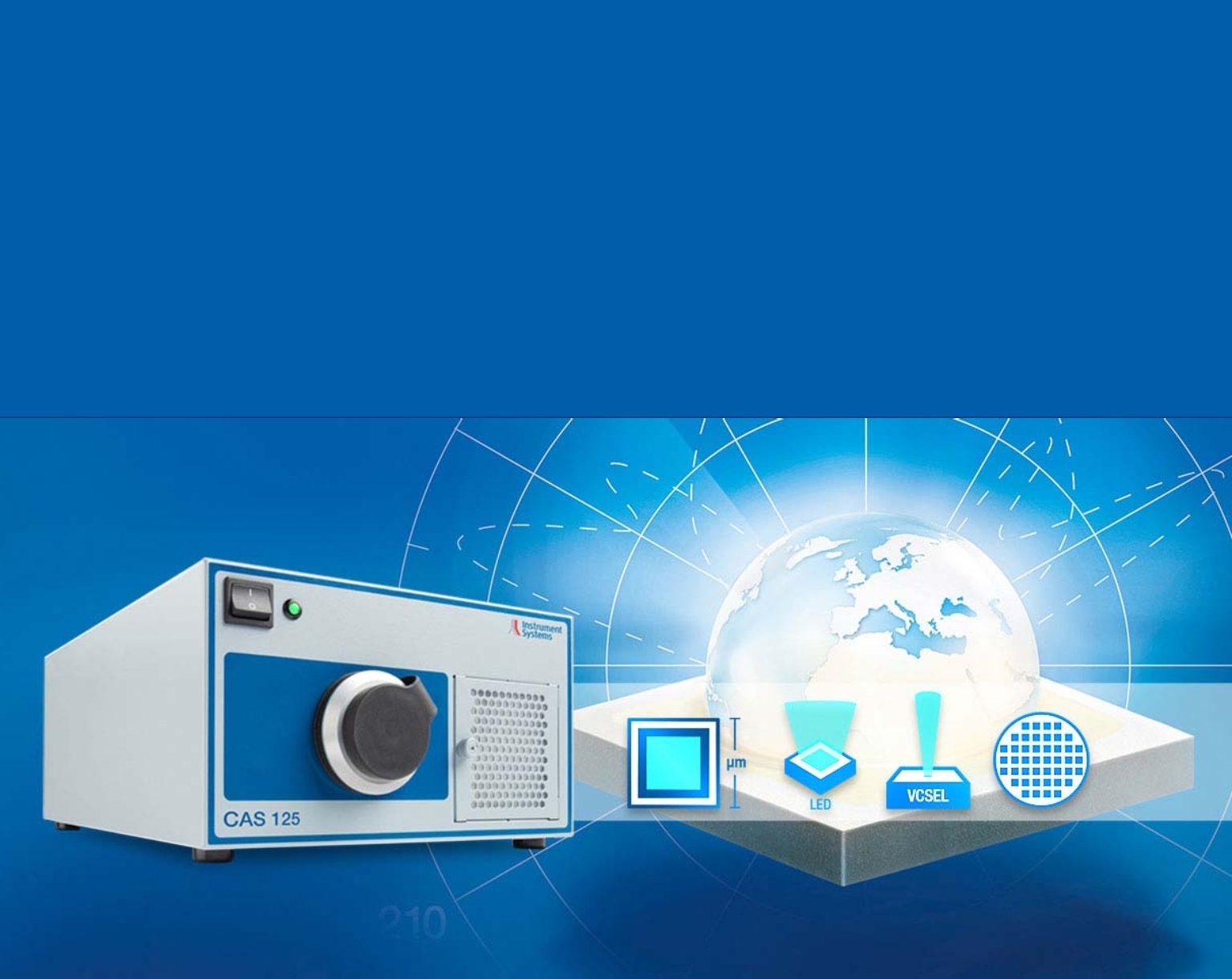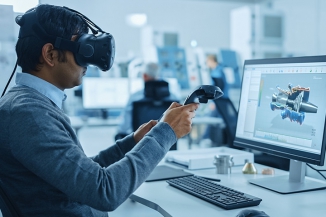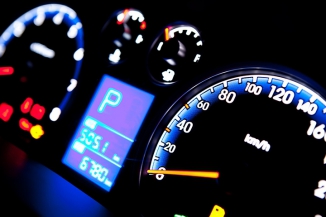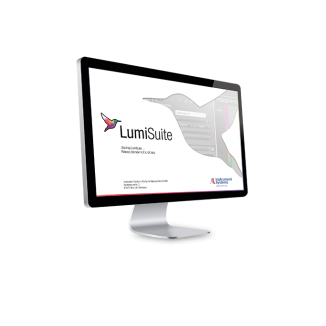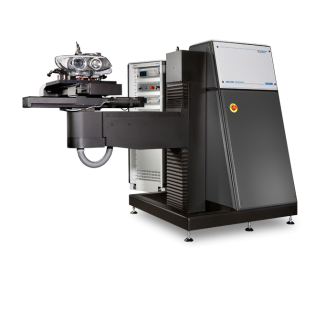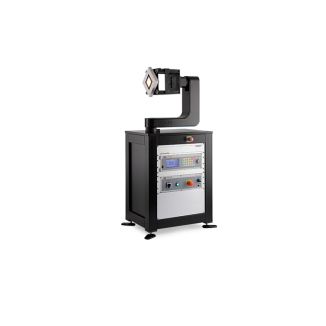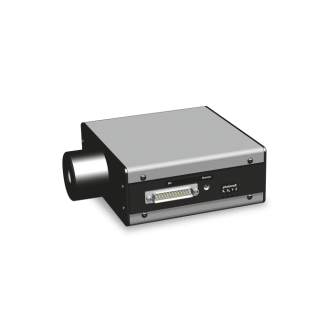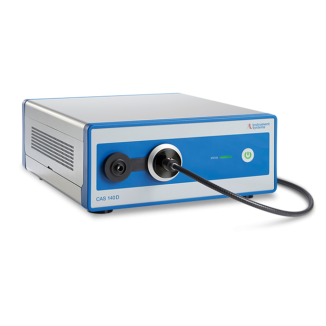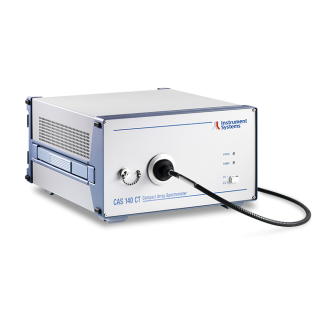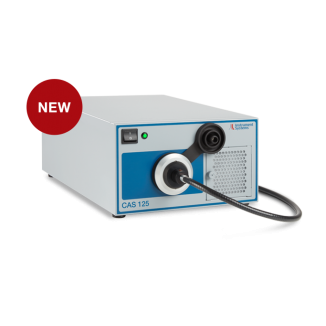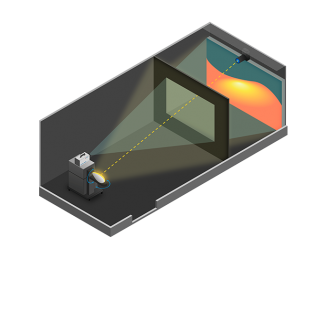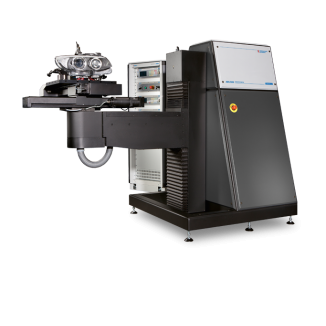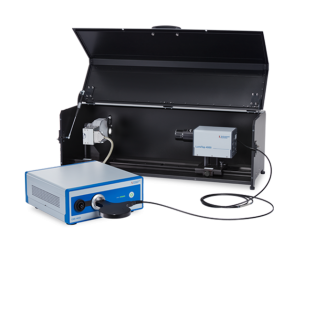德國光學計量工程技術
精恩光學的優勢方向
顯示屏、LED 和汽車標準
創新型光測量技術
以科學級精度和工業耐用性享譽全球
客戶專屬定制系統
應用
產品
系統
應用
產品
系統
最新消息
2023.9.25

精恩光學邀您10月相會深圳| C-TOUCH國際全觸與顯示展2023
德國IS光測與GIANT精恩光學將聯手展出各類顯示器、AR/VR 裝置、紅外線感應器及VCSEL 的測量解決方案。
國際全觸與顯示展(C-TOUCH & Display 2023) 將於2023年10月11-13日在深圳國際會展中心(寶安新館) 舉辦。同期將結合新型顯示技
術、Mini/Micro LED、AR/VR穿戴電子技術、智慧觸控技術、全像顯示器、智慧座艙及車載顯示器、智慧商顯、5G工業互聯等熱門話題,設置特色展區及50餘場主題高峰論壇與研討會,以及新品發表會集中展示前沿產業動態及發展趨勢。
光學測量儀器領導品牌Instrument Systems與GIANT精恩光學,將亮相2023國際全觸與顯示展,為您介紹最新的高品質顯示器量測技術。擁有豐富的解決方案、尖端技術及多年經驗,Instrument Systems 是您在新型顯示器生產測試、AR/VR 近眼顯示器、MicroLED 晶圓及VCSEL 測量等應用的首選合作夥伴。
歡迎蒞臨我們的攤位:8號展館8E11
多位經驗豐富的光學測量技術人員將在現場為您介紹光測技術,並為您的測量需求提供最合適的解決方案。我們熱切期待您的光臨!
您需要測量什麼產品?
顯示器生產測量
一站偵測顯示器的均勻度、偏色、閃爍、伽瑪值、缺陷偵測(Mura) 等特性
AR/VR 測量
近眼顯示器的均勻性、對比、角度依賴性及色彩保真度檢測及校正
MicroLED 測量
OLED 或MicroLED顯示器的亞像素分析及像素缺陷測試
車載顯示器測量
符合OEM 合規準則要求的車內顯示器及光學元件測量
VCSEL 測量
發射功率、VCSEL 陣列的均勻性、太空輻射特性,以及奈秒脈衝測量
IR/NIR 測量
光譜、功率、LIV 曲線、光學輸出的溫度相關性及角度分辨測量
我們將在現場展示LumiTop 顯示器生產測試系統,LumiTop AR/VR 近眼顯示器測量系統,DMS 測量系統等,產品覆蓋Mini/Micro LED、OLED、AR/VR穿戴式電子、智慧觸控、全像顯示器和車載顯示等領域。
歡迎蒞臨我們在C-Touch的展位,以獲得更多資訊!
閱讀更多
2023.9.25
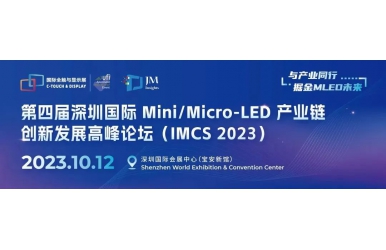
演講預告:《晶圓上µLEDs 和微型顯示器的快速測試》
第四屆深圳Mini/Micro-LED產業鏈創新發展高峰論壇邀請演講:
《晶圓上μLED 和微型顯示器的快速測試》
Mini/Micro LED產業發展如火如荼,隨著Mini/Micro LED 技術不斷突破,Mini LED應用市場正高速成長,Micro LED進入量產元年。第四屆深圳國際Mini/Micro LED產業鏈創新發展高峰論壇(IMCS 2023)將於10月12日於深圳全觸展同期舉辦。
Instrument Systems受主辦單位邀請,資深應用工程師朱天行先生將進行主題演講《晶圓上μLEDs 和微型顯示器的快速測試》,介紹透過軟體在晶圓或顯示器影像中尋找、定位和分析單一發射器的方法,重點是極快的分析演算法,為每一個單一的發射器提供精確的光學計量參數,敬請大家期待!
時間: 10月12日| 15:30-15:50
地點:深圳國際會展中心(寶安新館) 6/8號館(二層) 會議室
論壇主題:與產業鏈同行-掘金MLED未來
講者:朱天行先生
大會背景:
目前,隨著Micro LED量產元年的到來,MLED產業將迎來爆炸性成長。數據顯示,2022年Mini LED面板出貨超1800萬片,年增88%,到2026年將超3700萬片;2025年可穿戴品牌預計導入Micro LED,2027年Micro LED在可穿戴應用市場出貨可望突破1000萬片,Micro LED在VR/AR市場出貨將達670萬片。為了搶佔第三代顯示技術龐大的市場機遇,各Mini/Micro-LED產業鏈廠商湧入,透過協同創新打通Mini/Micro-LED產業鏈,完善Mini/Micro-LED產業生態,加速了Mini/Micro -LED產業化。
Mini LED背光可改善色域,提高HDR及降低耗能,助推液晶顯示升級,從2019年開始逐步導入電競筆電、高階電視等應用。2021年,蘋果iPad Pro、MacBook Pro引入Mini LED背光之後,Mini LED背光開始全面開花,進一步加速向車載顯示器、平板電腦、筆記型電腦、電視、顯示器以及VR等領域滲透,展現出巨大的發展潛力,是2023年一股強勁的成長力量。
Micro LED集低功耗、高亮度、超高解析度與色彩飽和度、反應速度快、超省電、壽命較長、效率較高等優點於一身,兼具OLED、LCD的顯示技術優勢,同時具有無縫拼接等特點,Micro LED在100吋以上尺寸顯示應用、可穿戴設備、AR等具有良好的發展前景。目前,Micro LED技術點不斷突破,已打通背板、驅動補償、LED晶片、轉移等關鍵技術,產業鏈加速融合,進入量產元年…
朱天行先生,擁有多年光學測試系統的設計與最佳化經驗。目前正專注於光學和AI的結合研究和應用。研究涉及深度學習演算法在光學檢測和影像處理領域的應用。如果您有任何Mini/Micro-LED技術或測量問題,歡迎隨時與我們聯絡~
-INVITATION-
Instrument Systems 聯合Giant精恩光學將亮相10月11-13日在深圳國際會展中心(寶安新館) 舉辦的2023年國際全觸與顯示展。經驗豐富的光學測量技術人員將在展位 8號館 8E11 為您介紹光測技術,我們熱切邀請您蒞臨參觀指導!
閱讀更多
2023.1.12
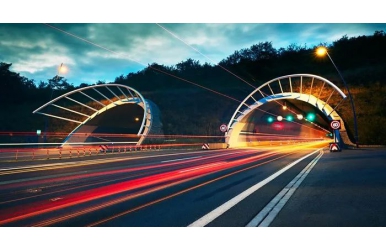
測量應用│ 汽車自適應前照燈系統(AFS) 中MicroLED 陣列的二維測量
汽車前照燈的良好性能,是確保道路及駕駛安全性的關鍵。道路行駛的環境複雜多變,氣候條件、道路照明、行人密度、前方車輛距離、公路或彎道等,都影響著駕駛者的視野。過去只分近光及遠光的照明模式,無法依據變化多端的行駛條件改變頭燈配光,容易產生照明死角或眩光。
為了提高行車安全與舒適度,近年來,各大汽車製造商紛紛裝備了能主動配合道路環境的自適應前照燈系統(AFS - automotive adaptive forward lighting system)。其中,使用MicroLED陣列的前照燈有發光效率高及配光靈活的優勢,是智能車燈發展的主流之一。
此篇測量應用將探討測量MicroLED車燈陣列的特點,並介紹IS光測系統的測量解決方案。
\\ 1. 待測物:MicroLED 汽車車燈陣列
自適應前照燈系統可以根據車輛行駛環境來動態調整光輸出模式。例如在光錐中偵測到對向來車時,自動調暗對其的燈光照射,防止駕駛被眩暈。近期的前照燈採用超過1000個像素的MicroLED陣列作為光源。由於每個像素都可以單獨控制,因此能實現更精細的光束控制(圖1)。這類"數位頭燈"甚至能在道路上實現投影(圖2)。
▲ 圖1 : 用於AFS 的MicroLED 陣列示意圖。
▲ 圖2 : 數位光源可在道路上投影。(圖像來源:Mercedes-Benz)
\\ 2. MicroLED 陣列車燈的測量要求和挑戰
為了精確控制車燈質量,必須能測量單個LED的均勻性、亮度及色彩,並定位陣列中的單顆LED缺陷。
挑戰1:溫度影響測量結果
測量高功率LED的主要難題,是LED通電時會自發熱,進而造成光輸出下降及顏色漂移(圖3)。
▲ 圖3 : 白光LED通電後亮度(紅色)和色溫(藍色)的典型漂移。
解決此問題,需從以下兩方面著手:
提高測量速度,排除過大的色溫漂移
測量程序與電源同步,在LED通電的瞬間便進行量測。
挑戰2:在高速測量下維持高精度
傳統的單顆LED 逐步測量法,對集成1000 多顆MicroLED 的矩陣來說過度耗時(方法A)。如使用基於攝像機的二維測量系統,則可以同時測量所有LED,測量速度提高許多(方法B)。但此方法需要高水平的測量系統,來達成測量MicroLED 所需的精度。
測量方法
A: 單一測量法,
每顆LED分開測量
B: 二維測量法,
LED陣列一次測量完成
系統
光譜儀與積分球,
一次點燃一顆量測
基於攝像機的系統,
通過拍攝一次測量所有LED
優點
高精度測量LED功率和光譜
非常快速地測量LED功率及顏色
缺點
費時
如何實現攝像機採集信息的
高精度是一大挑戰
\\ 3. 解決方案:LumiTop – 光譜增強的產品成像色度測量系統
LumiTop 系統解決方案結合上述單一測量法及二維測量法的優點,並克服了高功率LED 的發熱問題。
▲ 圖4 : LumiTop 2D 測量系統
LumiTop系統設計
LumiTop 2D 測量系統包含LumiTop 4000 成像色度儀及CAS 140D 高精度光譜儀,兩者通過光纖連接(圖4)。集成分光器的設計,使RGB 相機和光譜儀可以同步量測。如圖5所示,光譜儀從待測物的中心點採集高精度的光譜信息,成像色度儀則同時測量整個LED 陣列,再以光譜信息為參考基準調整參數,從而提高整個二維圖像的測量準確性。
根據修正後的二維測量數據,可有效評估整個LED 陣列的均勻度、亮度和單個LED 的顏色,並精準地找出LED 缺陷(圖6)。LumiTop 測量系統是根據亮度(cd/m2)校準,這也是測量二維發射器發光特性的標準。
▲ 圖5 : 光譜儀參考點光譜。
▲ 圖6 : 2D 測量結果:LED 均勻度圖。
避免 LED 發熱問題
傳統的二維攝像機基於彩色濾光片,需要至少三次的連續顏色測量(紅、綠、藍)。此測量方法通常費時數秒,而測量時因為LED 不停發熱,顏色、光強一直處於變化狀態,導致測量結果不准確。
我們研發的LumiTop 系統,可以通過一次拍攝所有的顏色通道,解決LED 的發熱問題。該系統使用RGB 攝像機,並搭載拜爾濾色鏡,能實現毫秒級速度的二維顏色測量。因此,LumiTop系統也適合用於生產製程的在線測試。通過硬件觸發源,LumiTop 可以在LED 通電的同時攝像,在LED發熱前就已完成量測。
高精度的測量結果
除了溫度上的挑戰,LumiTop系統還克服了測量精度上的挑戰。為了達到測量MicroLED陣列要求的精度,LumiTop與光譜輻射計相配合,將攝像機的測量結果校正至精確水平(圖4)。測量系統的校準(Absolute System Calibration)是此解決方案能確保高精度的關鍵:Instrument Systems的每套系統在發貨前,都經過我們ISO 17025 認證測試實驗室的精度驗證。
基於其儀器設計、精度、速度和分辨率,帶100mm鏡頭的LumiTop 4000適合用於實驗室的LED陣列測量或AFS應用的生產在線測試。
如果您需要更多關於MicroLED測量的信息,可隨時與我們聯繫。我們的測量團隊很樂意為您的特殊應用提供實用建議。請聯繫:[email protected]
閱讀更多
2023.3.22
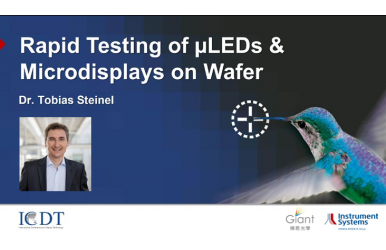
直播課預告:快速測試晶圓上µLED及微顯示器的方法
2023年起, 德國國家認可機構(DAkkS)擴大了Instrument Systems 的認可範圍,使我們能在客戶的LGS, DMS及AMS測角儀安裝場地為DSP系列光度計進行符合ISO 17025標準的測試及調整,並提供測試證書。
此外,3月和4月,我們分別將在德國電子顯示會議(EDC)和中國國際顯示技術會議(ICDT)上,分享關於顯示器檢測和µLED 及微顯示器檢測的最新技術報告。更多細節請參見下文。期待您的參加!
-INVITATION-
\\ 國際顯示技術會議ICDT邀請演講:
《快速測試晶圓上µLED及微顯示器的方法》
時間:4月2日| 17:10-17:30 (在線直播)
論壇24:Micro-LED 工藝和評估
講者:Dr. Tobias Steinel
精彩內容:
MicroLED顯示器具有對比度高、響應時間快速、色域廣泛、低功耗和使用壽命長等特點,因此是備受業界期待的新一代顯示技術。然而,MicroLED技術在光學質量控制方面很具挑戰性,尤其是窄帶MicroLED。在演講中,TobiasSteinel博士將說明如何通過軟件,在晶圓或顯示器圖像上查找、定位及分析單個發射器。以及如何通過高速演算法,為每個發射器提供準確的光學計量參數。
更多信息>>
-INVITATION-
\\ EDC 2023:
Global and RollingShutter Artifacts in DisplayMetrology
在2023年的EDC紐倫堡電子顯示會議上,Instrument Systems將就“全局和滾動快門圖像偽影的特徵及預防”這一主題發表演講。我們的產品經理Andreas Liebel將討論光度計相機的快門類型對圖像偽影的影響,並提出解決方法,以確保在高精度顯示器測試時避免這些偽影。現代的高端顯示器具有動態調節刷新率和脈衝寬度的特性,以節約能源並根據屏幕內容動態調整。這些特點為顯示測試系統提出了新的挑戰,並可能導致圖像偽影的產生。
更多信息>>
-INVITATION-
\\ 在客戶設備的安裝現場進行符合ISO 17025標準的測試服務
自2023年1月起,Instrument Systems提供其LGS和AMS大型測角儀設備在客戶現場的安裝位置進行ISO 17025合規光強度的測試服務。這樣,即使DSP 200和DSP 10光度計在運行地點進行測試和校準,客戶也可以獲得符合ISO 17025標準的測試證書。
以前,現場測試的認可僅適用於Instrument Systems的DMS顯示測量系統。德國IS光測的客戶現在可以在自己的運行場所對DSP 200和DSP 10光度計進行測試和調整,並獲得符合ISO 17025標準的測試證書。這意味著質量控制和COP測試可以持續進行,而不必中斷操作並將設備拆卸送回原廠。認證的具體範圍請見DAkkS證書。
更多信息>>
-INVITATION-
\\ Information Display 雜誌專訪企業故事
在過去的六十年裡,發光器件如發光二極管(LED)經歷了一個激動人心的演變。它們從指示燈和數碼顯示器中微弱的紅光開始,發展到點亮電視屏幕,並成為照明家庭和街道的白光。
從一開始,總部位於慕尼黑的InstrumentSystems便支持LED的發展及其蓬勃發展的應用領域。Instrument Systems成立於1986年,是由Richard Distl在贏得德國青年研究競賽后所創辦。現在則是高精度光譜儀、定制系統和用於光譜光測量的軟件解決方案的領先光學設備製造商......
採訪內容由Prachi Patel發表在InformationDisplay 1/23。
更多信息>>
我們的測量團隊很樂意就您的特定應用提供專業建議,請隨時向我們諮詢:[email protected]。
閱讀更多
2023.4.11
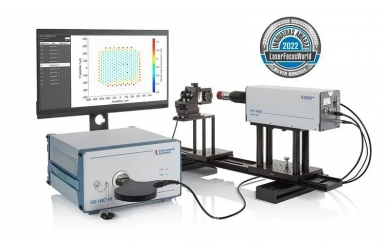
德國IS光測榮獲激光焦點世界創新獎
德國IS光測的VCSEL測量系統榮獲激光焦點世界創新獎
Instrument Systems(德國IS光測)專為測量VCSEL陣列設計的二維近場分析紅外相機VTC4000,榮獲了Laser Focus World的“激光焦點世界創新獎”。
該相機可以快速、準確地分析窄帶紅外發射器的近場特性,並提供降低偏振相關性所需的信息,減低測試系統誤差。其高精度的測量結果協助提高VCSEL的安全運行及功率效率。結合CAS高分辨率陣列光譜儀,VTC系統還可以測量紅外發射器的單發射器波長,並通過透射屏幕來測量其遠場發射特性。
除了VTC4000,IS光測也提供定制的解決方案,例如脈衝VCSEL測試儀PVT系統,用於在實驗室和生產線上中對VCSEL的光電特性進行表徵及質量控制。
圖:VCSEL陣列二維近場分析系統VTC4000
“VCSEL是具有固有單縱模的組件,通常表現出複雜的偏振特性,”Instrument Systems的關鍵客戶經理Stephanie Grabher表示。“它們發出的光通常沿兩個正交方向之一的線性極化。如果溫度或偏置電流發生變化,可能會觀察到突然的極化切換。由於VCSEL發射的是多種極化狀態,因此無法控制其極化角度。為了充分利用VCSEL 的性能潛力,同時保證安全運行,測量幅值和絕對功率時,也應考慮其極化依賴性。”
圖: 上:受不穩定偏振影響的VCSEL測量結果,下:偏振穩定的VCSEL測量結果
基於其一拍即得的單次成像測量法,VTC4000可以同時測量近場VCSEL陣列中各個發射器的空間偏振,並提供降低測量設置偏振相關性所需的信息。該程序能降低VCSEL測試系統的誤差預算,並為確保激光源的人眼安全性提供了高度準確的測量值。
VTC紅外相機能表徵單個發射器的缺陷、位置、功率和輻射信息。結合CAS光譜儀,還可以測量單發射器波長。而搭配透射屏幕,則可以測量紅外發射器的遠場發射特性。
除此之外,針對在實驗室及產線上對VCSEL光電特性進行表徵和質量控制需求,精恩光學也提供量身定制的解決方案。通過結合業界知名的CAS高分辨率陣列光譜,此系統提供高達0.12nm的光譜分辨率,且由於集成時間短,特別適用於高產量的生產線。脈衝VCSEL測試儀PVT,則是專為實驗室納秒脈衝的時間分辨測量而定制。
若您想了解更多關於VCSEL近場測試的解決方案,歡迎隨時聯繫我們( [email protected])。
閱讀更多
2023.7.3
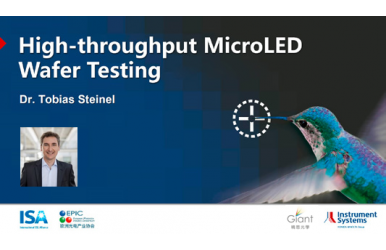
7月4日直播課預告:高通量µLED晶圓測試
\\ ISA-EPIC Mini/Micro-LED 技術及應用在線研討會邀請演講:
《高通量µLED晶圓測試》(High-throughput MicroLED Wafer Testing)
近年來,Mini/Micro LED不斷取得突破,已成為顯示產業的主要關注點。其“薄膜化,微小化,陣列化、高集成”的優勢,在虛擬現實、智慧車載、裸眼3D、元宇宙等領域的應用方興未艾,人們期待著這一顛覆性技術在泛微顯示、通信、醫療領域有著更多的高階應用。
ISA聯合歐洲光電產業協會(EPIC) 將於2023年7月4日(15:00-18:00 (北京時間) 9:00-12:00 (CEST) ) 召開“Mini/Micro-LED 技術及應用在線研討會”,將有來自全球Mini/Micro LED研究及應用領域的專家演講。
Instrument Systems受主辦方的邀請將在線直播演講《高通量µLED晶圓測試》(High-throughput MicroLED Wafer Testing)。
時間:7月4日| 17:30-17:50 (在線直播)
Zoom會議鏈接:https://us06web.zoom.us/j/82153605604?pwd=dHAzT2NPOGQzLzR6UkwwOHVXdDYvUT09
ID:821 5360 5604
Password:946165
講者:Dr. Tobias Steinel
精彩內容:
即將推出的µLEDs顯示技術具有高對比度、快速響應時間、寬色域、低功耗和長壽命等優點。但是,該技術在光學質量控制方面具有挑戰性,特別是對於窄帶寬µLEDs。
Dr. Tobias Steinel將介紹如何驗證一種軟件方法,以查找、定位和分析晶圓或顯示圖像上的單個發射器。重點是極快的分析算法,為每一個單一的發射器提供光學計量參數。
更多信息>>
-INVITATION-
Instrument Systems 聯合精恩光學將參加7月11日在上海國家會展中心舉辦的2023 年慕尼黑上海光博會。多位經驗豐富的光學測量技術人員,將在展位 7.1E301 為您介紹光測技術,我們熱切邀請您蒞臨參觀指導!
閱讀更多
2023.9.25

精恩光學邀您10月相會深圳| C-TOUCH國際全觸與顯示展2023
德國IS光測與GIANT精恩光學將聯手展出各類顯示器、AR/VR 裝置、紅外線感應器及VCSEL 的測量解決方案。
國際全觸與顯示展(C-TOUCH & Display 2023) 將於2023年10月11-13日在深圳國際會展中心(寶安新館) 舉辦。同期將結合新型顯示技
術、Mini/Micro LED、AR/VR穿戴電子技術、智慧觸控技術、全像顯示器、智慧座艙及車載顯示器、智慧商顯、5G工業互聯等熱門話題,設置特色展區及50餘場主題高峰論壇與研討會,以及新品發表會集中展示前沿產業動態及發展趨勢。
光學測量儀器領導品牌Instrument Systems與GIANT精恩光學,將亮相2023國際全觸與顯示展,為您介紹最新的高品質顯示器量測技術。擁有豐富的解決方案、尖端技術及多年經驗,Instrument Systems 是您在新型顯示器生產測試、AR/VR 近眼顯示器、MicroLED 晶圓及VCSEL 測量等應用的首選合作夥伴。
歡迎蒞臨我們的攤位:8號展館8E11
多位經驗豐富的光學測量技術人員將在現場為您介紹光測技術,並為您的測量需求提供最合適的解決方案。我們熱切期待您的光臨!
您需要測量什麼產品?
顯示器生產測量
一站偵測顯示器的均勻度、偏色、閃爍、伽瑪值、缺陷偵測(Mura) 等特性
AR/VR 測量
近眼顯示器的均勻性、對比、角度依賴性及色彩保真度檢測及校正
MicroLED 測量
OLED 或MicroLED顯示器的亞像素分析及像素缺陷測試
車載顯示器測量
符合OEM 合規準則要求的車內顯示器及光學元件測量
VCSEL 測量
發射功率、VCSEL 陣列的均勻性、太空輻射特性,以及奈秒脈衝測量
IR/NIR 測量
光譜、功率、LIV 曲線、光學輸出的溫度相關性及角度分辨測量
我們將在現場展示LumiTop 顯示器生產測試系統,LumiTop AR/VR 近眼顯示器測量系統,DMS 測量系統等,產品覆蓋Mini/Micro LED、OLED、AR/VR穿戴式電子、智慧觸控、全像顯示器和車載顯示等領域。
歡迎蒞臨我們在C-Touch的展位,以獲得更多資訊!
閱讀更多
2023.9.25

演講預告:《晶圓上µLEDs 和微型顯示器的快速測試》
第四屆深圳Mini/Micro-LED產業鏈創新發展高峰論壇邀請演講:
《晶圓上μLED 和微型顯示器的快速測試》
Mini/Micro LED產業發展如火如荼,隨著Mini/Micro LED 技術不斷突破,Mini LED應用市場正高速成長,Micro LED進入量產元年。第四屆深圳國際Mini/Micro LED產業鏈創新發展高峰論壇(IMCS 2023)將於10月12日於深圳全觸展同期舉辦。
Instrument Systems受主辦單位邀請,資深應用工程師朱天行先生將進行主題演講《晶圓上μLEDs 和微型顯示器的快速測試》,介紹透過軟體在晶圓或顯示器影像中尋找、定位和分析單一發射器的方法,重點是極快的分析演算法,為每一個單一的發射器提供精確的光學計量參數,敬請大家期待!
時間: 10月12日| 15:30-15:50
地點:深圳國際會展中心(寶安新館) 6/8號館(二層) 會議室
論壇主題:與產業鏈同行-掘金MLED未來
講者:朱天行先生
大會背景:
目前,隨著Micro LED量產元年的到來,MLED產業將迎來爆炸性成長。數據顯示,2022年Mini LED面板出貨超1800萬片,年增88%,到2026年將超3700萬片;2025年可穿戴品牌預計導入Micro LED,2027年Micro LED在可穿戴應用市場出貨可望突破1000萬片,Micro LED在VR/AR市場出貨將達670萬片。為了搶佔第三代顯示技術龐大的市場機遇,各Mini/Micro-LED產業鏈廠商湧入,透過協同創新打通Mini/Micro-LED產業鏈,完善Mini/Micro-LED產業生態,加速了Mini/Micro -LED產業化。
Mini LED背光可改善色域,提高HDR及降低耗能,助推液晶顯示升級,從2019年開始逐步導入電競筆電、高階電視等應用。2021年,蘋果iPad Pro、MacBook Pro引入Mini LED背光之後,Mini LED背光開始全面開花,進一步加速向車載顯示器、平板電腦、筆記型電腦、電視、顯示器以及VR等領域滲透,展現出巨大的發展潛力,是2023年一股強勁的成長力量。
Micro LED集低功耗、高亮度、超高解析度與色彩飽和度、反應速度快、超省電、壽命較長、效率較高等優點於一身,兼具OLED、LCD的顯示技術優勢,同時具有無縫拼接等特點,Micro LED在100吋以上尺寸顯示應用、可穿戴設備、AR等具有良好的發展前景。目前,Micro LED技術點不斷突破,已打通背板、驅動補償、LED晶片、轉移等關鍵技術,產業鏈加速融合,進入量產元年…
朱天行先生,擁有多年光學測試系統的設計與最佳化經驗。目前正專注於光學和AI的結合研究和應用。研究涉及深度學習演算法在光學檢測和影像處理領域的應用。如果您有任何Mini/Micro-LED技術或測量問題,歡迎隨時與我們聯絡~
-INVITATION-
Instrument Systems 聯合Giant精恩光學將亮相10月11-13日在深圳國際會展中心(寶安新館) 舉辦的2023年國際全觸與顯示展。經驗豐富的光學測量技術人員將在展位 8號館 8E11 為您介紹光測技術,我們熱切邀請您蒞臨參觀指導!
閱讀更多
2023.1.12

測量應用│ 汽車自適應前照燈系統(AFS) 中MicroLED 陣列的二維測量
汽車前照燈的良好性能,是確保道路及駕駛安全性的關鍵。道路行駛的環境複雜多變,氣候條件、道路照明、行人密度、前方車輛距離、公路或彎道等,都影響著駕駛者的視野。過去只分近光及遠光的照明模式,無法依據變化多端的行駛條件改變頭燈配光,容易產生照明死角或眩光。
為了提高行車安全與舒適度,近年來,各大汽車製造商紛紛裝備了能主動配合道路環境的自適應前照燈系統(AFS - automotive adaptive forward lighting system)。其中,使用MicroLED陣列的前照燈有發光效率高及配光靈活的優勢,是智能車燈發展的主流之一。
此篇測量應用將探討測量MicroLED車燈陣列的特點,並介紹IS光測系統的測量解決方案。
\\ 1. 待測物:MicroLED 汽車車燈陣列
自適應前照燈系統可以根據車輛行駛環境來動態調整光輸出模式。例如在光錐中偵測到對向來車時,自動調暗對其的燈光照射,防止駕駛被眩暈。近期的前照燈採用超過1000個像素的MicroLED陣列作為光源。由於每個像素都可以單獨控制,因此能實現更精細的光束控制(圖1)。這類"數位頭燈"甚至能在道路上實現投影(圖2)。
▲ 圖1 : 用於AFS 的MicroLED 陣列示意圖。
▲ 圖2 : 數位光源可在道路上投影。(圖像來源:Mercedes-Benz)
\\ 2. MicroLED 陣列車燈的測量要求和挑戰
為了精確控制車燈質量,必須能測量單個LED的均勻性、亮度及色彩,並定位陣列中的單顆LED缺陷。
挑戰1:溫度影響測量結果
測量高功率LED的主要難題,是LED通電時會自發熱,進而造成光輸出下降及顏色漂移(圖3)。
▲ 圖3 : 白光LED通電後亮度(紅色)和色溫(藍色)的典型漂移。
解決此問題,需從以下兩方面著手:
提高測量速度,排除過大的色溫漂移
測量程序與電源同步,在LED通電的瞬間便進行量測。
挑戰2:在高速測量下維持高精度
傳統的單顆LED 逐步測量法,對集成1000 多顆MicroLED 的矩陣來說過度耗時(方法A)。如使用基於攝像機的二維測量系統,則可以同時測量所有LED,測量速度提高許多(方法B)。但此方法需要高水平的測量系統,來達成測量MicroLED 所需的精度。
測量方法
A: 單一測量法,
每顆LED分開測量
B: 二維測量法,
LED陣列一次測量完成
系統
光譜儀與積分球,
一次點燃一顆量測
基於攝像機的系統,
通過拍攝一次測量所有LED
優點
高精度測量LED功率和光譜
非常快速地測量LED功率及顏色
缺點
費時
如何實現攝像機採集信息的
高精度是一大挑戰
\\ 3. 解決方案:LumiTop – 光譜增強的產品成像色度測量系統
LumiTop 系統解決方案結合上述單一測量法及二維測量法的優點,並克服了高功率LED 的發熱問題。
▲ 圖4 : LumiTop 2D 測量系統
LumiTop系統設計
LumiTop 2D 測量系統包含LumiTop 4000 成像色度儀及CAS 140D 高精度光譜儀,兩者通過光纖連接(圖4)。集成分光器的設計,使RGB 相機和光譜儀可以同步量測。如圖5所示,光譜儀從待測物的中心點採集高精度的光譜信息,成像色度儀則同時測量整個LED 陣列,再以光譜信息為參考基準調整參數,從而提高整個二維圖像的測量準確性。
根據修正後的二維測量數據,可有效評估整個LED 陣列的均勻度、亮度和單個LED 的顏色,並精準地找出LED 缺陷(圖6)。LumiTop 測量系統是根據亮度(cd/m2)校準,這也是測量二維發射器發光特性的標準。
▲ 圖5 : 光譜儀參考點光譜。
▲ 圖6 : 2D 測量結果:LED 均勻度圖。
避免 LED 發熱問題
傳統的二維攝像機基於彩色濾光片,需要至少三次的連續顏色測量(紅、綠、藍)。此測量方法通常費時數秒,而測量時因為LED 不停發熱,顏色、光強一直處於變化狀態,導致測量結果不准確。
我們研發的LumiTop 系統,可以通過一次拍攝所有的顏色通道,解決LED 的發熱問題。該系統使用RGB 攝像機,並搭載拜爾濾色鏡,能實現毫秒級速度的二維顏色測量。因此,LumiTop系統也適合用於生產製程的在線測試。通過硬件觸發源,LumiTop 可以在LED 通電的同時攝像,在LED發熱前就已完成量測。
高精度的測量結果
除了溫度上的挑戰,LumiTop系統還克服了測量精度上的挑戰。為了達到測量MicroLED陣列要求的精度,LumiTop與光譜輻射計相配合,將攝像機的測量結果校正至精確水平(圖4)。測量系統的校準(Absolute System Calibration)是此解決方案能確保高精度的關鍵:Instrument Systems的每套系統在發貨前,都經過我們ISO 17025 認證測試實驗室的精度驗證。
基於其儀器設計、精度、速度和分辨率,帶100mm鏡頭的LumiTop 4000適合用於實驗室的LED陣列測量或AFS應用的生產在線測試。
如果您需要更多關於MicroLED測量的信息,可隨時與我們聯繫。我們的測量團隊很樂意為您的特殊應用提供實用建議。請聯繫:[email protected]
閱讀更多
2023.3.22

直播課預告:快速測試晶圓上µLED及微顯示器的方法
2023年起, 德國國家認可機構(DAkkS)擴大了Instrument Systems 的認可範圍,使我們能在客戶的LGS, DMS及AMS測角儀安裝場地為DSP系列光度計進行符合ISO 17025標準的測試及調整,並提供測試證書。
此外,3月和4月,我們分別將在德國電子顯示會議(EDC)和中國國際顯示技術會議(ICDT)上,分享關於顯示器檢測和µLED 及微顯示器檢測的最新技術報告。更多細節請參見下文。期待您的參加!
-INVITATION-
\\ 國際顯示技術會議ICDT邀請演講:
《快速測試晶圓上µLED及微顯示器的方法》
時間:4月2日| 17:10-17:30 (在線直播)
論壇24:Micro-LED 工藝和評估
講者:Dr. Tobias Steinel
精彩內容:
MicroLED顯示器具有對比度高、響應時間快速、色域廣泛、低功耗和使用壽命長等特點,因此是備受業界期待的新一代顯示技術。然而,MicroLED技術在光學質量控制方面很具挑戰性,尤其是窄帶MicroLED。在演講中,TobiasSteinel博士將說明如何通過軟件,在晶圓或顯示器圖像上查找、定位及分析單個發射器。以及如何通過高速演算法,為每個發射器提供準確的光學計量參數。
更多信息>>
-INVITATION-
\\ EDC 2023:
Global and RollingShutter Artifacts in DisplayMetrology
在2023年的EDC紐倫堡電子顯示會議上,Instrument Systems將就“全局和滾動快門圖像偽影的特徵及預防”這一主題發表演講。我們的產品經理Andreas Liebel將討論光度計相機的快門類型對圖像偽影的影響,並提出解決方法,以確保在高精度顯示器測試時避免這些偽影。現代的高端顯示器具有動態調節刷新率和脈衝寬度的特性,以節約能源並根據屏幕內容動態調整。這些特點為顯示測試系統提出了新的挑戰,並可能導致圖像偽影的產生。
更多信息>>
-INVITATION-
\\ 在客戶設備的安裝現場進行符合ISO 17025標準的測試服務
自2023年1月起,Instrument Systems提供其LGS和AMS大型測角儀設備在客戶現場的安裝位置進行ISO 17025合規光強度的測試服務。這樣,即使DSP 200和DSP 10光度計在運行地點進行測試和校準,客戶也可以獲得符合ISO 17025標準的測試證書。
以前,現場測試的認可僅適用於Instrument Systems的DMS顯示測量系統。德國IS光測的客戶現在可以在自己的運行場所對DSP 200和DSP 10光度計進行測試和調整,並獲得符合ISO 17025標準的測試證書。這意味著質量控制和COP測試可以持續進行,而不必中斷操作並將設備拆卸送回原廠。認證的具體範圍請見DAkkS證書。
更多信息>>
-INVITATION-
\\ Information Display 雜誌專訪企業故事
在過去的六十年裡,發光器件如發光二極管(LED)經歷了一個激動人心的演變。它們從指示燈和數碼顯示器中微弱的紅光開始,發展到點亮電視屏幕,並成為照明家庭和街道的白光。
從一開始,總部位於慕尼黑的InstrumentSystems便支持LED的發展及其蓬勃發展的應用領域。Instrument Systems成立於1986年,是由Richard Distl在贏得德國青年研究競賽后所創辦。現在則是高精度光譜儀、定制系統和用於光譜光測量的軟件解決方案的領先光學設備製造商......
採訪內容由Prachi Patel發表在InformationDisplay 1/23。
更多信息>>
我們的測量團隊很樂意就您的特定應用提供專業建議,請隨時向我們諮詢:[email protected]。
閱讀更多
2023.4.11

德國IS光測榮獲激光焦點世界創新獎
德國IS光測的VCSEL測量系統榮獲激光焦點世界創新獎
Instrument Systems(德國IS光測)專為測量VCSEL陣列設計的二維近場分析紅外相機VTC4000,榮獲了Laser Focus World的“激光焦點世界創新獎”。
該相機可以快速、準確地分析窄帶紅外發射器的近場特性,並提供降低偏振相關性所需的信息,減低測試系統誤差。其高精度的測量結果協助提高VCSEL的安全運行及功率效率。結合CAS高分辨率陣列光譜儀,VTC系統還可以測量紅外發射器的單發射器波長,並通過透射屏幕來測量其遠場發射特性。
除了VTC4000,IS光測也提供定制的解決方案,例如脈衝VCSEL測試儀PVT系統,用於在實驗室和生產線上中對VCSEL的光電特性進行表徵及質量控制。
圖:VCSEL陣列二維近場分析系統VTC4000
“VCSEL是具有固有單縱模的組件,通常表現出複雜的偏振特性,”Instrument Systems的關鍵客戶經理Stephanie Grabher表示。“它們發出的光通常沿兩個正交方向之一的線性極化。如果溫度或偏置電流發生變化,可能會觀察到突然的極化切換。由於VCSEL發射的是多種極化狀態,因此無法控制其極化角度。為了充分利用VCSEL 的性能潛力,同時保證安全運行,測量幅值和絕對功率時,也應考慮其極化依賴性。”
圖: 上:受不穩定偏振影響的VCSEL測量結果,下:偏振穩定的VCSEL測量結果
基於其一拍即得的單次成像測量法,VTC4000可以同時測量近場VCSEL陣列中各個發射器的空間偏振,並提供降低測量設置偏振相關性所需的信息。該程序能降低VCSEL測試系統的誤差預算,並為確保激光源的人眼安全性提供了高度準確的測量值。
VTC紅外相機能表徵單個發射器的缺陷、位置、功率和輻射信息。結合CAS光譜儀,還可以測量單發射器波長。而搭配透射屏幕,則可以測量紅外發射器的遠場發射特性。
除此之外,針對在實驗室及產線上對VCSEL光電特性進行表徵和質量控制需求,精恩光學也提供量身定制的解決方案。通過結合業界知名的CAS高分辨率陣列光譜,此系統提供高達0.12nm的光譜分辨率,且由於集成時間短,特別適用於高產量的生產線。脈衝VCSEL測試儀PVT,則是專為實驗室納秒脈衝的時間分辨測量而定制。
若您想了解更多關於VCSEL近場測試的解決方案,歡迎隨時聯繫我們( [email protected])。
閱讀更多
2023.7.3

7月4日直播課預告:高通量µLED晶圓測試
\\ ISA-EPIC Mini/Micro-LED 技術及應用在線研討會邀請演講:
《高通量µLED晶圓測試》(High-throughput MicroLED Wafer Testing)
近年來,Mini/Micro LED不斷取得突破,已成為顯示產業的主要關注點。其“薄膜化,微小化,陣列化、高集成”的優勢,在虛擬現實、智慧車載、裸眼3D、元宇宙等領域的應用方興未艾,人們期待著這一顛覆性技術在泛微顯示、通信、醫療領域有著更多的高階應用。
ISA聯合歐洲光電產業協會(EPIC) 將於2023年7月4日(15:00-18:00 (北京時間) 9:00-12:00 (CEST) ) 召開“Mini/Micro-LED 技術及應用在線研討會”,將有來自全球Mini/Micro LED研究及應用領域的專家演講。
Instrument Systems受主辦方的邀請將在線直播演講《高通量µLED晶圓測試》(High-throughput MicroLED Wafer Testing)。
時間:7月4日| 17:30-17:50 (在線直播)
Zoom會議鏈接:https://us06web.zoom.us/j/82153605604?pwd=dHAzT2NPOGQzLzR6UkwwOHVXdDYvUT09
ID:821 5360 5604
Password:946165
講者:Dr. Tobias Steinel
精彩內容:
即將推出的µLEDs顯示技術具有高對比度、快速響應時間、寬色域、低功耗和長壽命等優點。但是,該技術在光學質量控制方面具有挑戰性,特別是對於窄帶寬µLEDs。
Dr. Tobias Steinel將介紹如何驗證一種軟件方法,以查找、定位和分析晶圓或顯示圖像上的單個發射器。重點是極快的分析算法,為每一個單一的發射器提供光學計量參數。
更多信息>>
-INVITATION-
Instrument Systems 聯合精恩光學將參加7月11日在上海國家會展中心舉辦的2023 年慕尼黑上海光博會。多位經驗豐富的光學測量技術人員,將在展位 7.1E301 為您介紹光測技術,我們熱切邀請您蒞臨參觀指導!
閱讀更多
2023.9.25

精恩光學邀您10月相會深圳| C-TOUCH國際全觸與顯示展2023
德國IS光測與GIANT精恩光學將聯手展出各類顯示器、AR/VR 裝置、紅外線感應器及VCSEL 的測量解決方案。
國際全觸與顯示展(C-TOUCH & Display 2023) 將於2023年10月11-13日在深圳國際會展中心(寶安新館) 舉辦。同期將結合新型顯示技
術、Mini/Micro LED、AR/VR穿戴電子技術、智慧觸控技術、全像顯示器、智慧座艙及車載顯示器、智慧商顯、5G工業互聯等熱門話題,設置特色展區及50餘場主題高峰論壇與研討會,以及新品發表會集中展示前沿產業動態及發展趨勢。
光學測量儀器領導品牌Instrument Systems與GIANT精恩光學,將亮相2023國際全觸與顯示展,為您介紹最新的高品質顯示器量測技術。擁有豐富的解決方案、尖端技術及多年經驗,Instrument Systems 是您在新型顯示器生產測試、AR/VR 近眼顯示器、MicroLED 晶圓及VCSEL 測量等應用的首選合作夥伴。
歡迎蒞臨我們的攤位:8號展館8E11
多位經驗豐富的光學測量技術人員將在現場為您介紹光測技術,並為您的測量需求提供最合適的解決方案。我們熱切期待您的光臨!
您需要測量什麼產品?
顯示器生產測量
一站偵測顯示器的均勻度、偏色、閃爍、伽瑪值、缺陷偵測(Mura) 等特性
AR/VR 測量
近眼顯示器的均勻性、對比、角度依賴性及色彩保真度檢測及校正
MicroLED 測量
OLED 或MicroLED顯示器的亞像素分析及像素缺陷測試
車載顯示器測量
符合OEM 合規準則要求的車內顯示器及光學元件測量
VCSEL 測量
發射功率、VCSEL 陣列的均勻性、太空輻射特性,以及奈秒脈衝測量
IR/NIR 測量
光譜、功率、LIV 曲線、光學輸出的溫度相關性及角度分辨測量
我們將在現場展示LumiTop 顯示器生產測試系統,LumiTop AR/VR 近眼顯示器測量系統,DMS 測量系統等,產品覆蓋Mini/Micro LED、OLED、AR/VR穿戴式電子、智慧觸控、全像顯示器和車載顯示等領域。
歡迎蒞臨我們在C-Touch的展位,以獲得更多資訊!
閱讀更多
2023.9.25

演講預告:《晶圓上µLEDs 和微型顯示器的快速測試》
第四屆深圳Mini/Micro-LED產業鏈創新發展高峰論壇邀請演講:
《晶圓上μLED 和微型顯示器的快速測試》
Mini/Micro LED產業發展如火如荼,隨著Mini/Micro LED 技術不斷突破,Mini LED應用市場正高速成長,Micro LED進入量產元年。第四屆深圳國際Mini/Micro LED產業鏈創新發展高峰論壇(IMCS 2023)將於10月12日於深圳全觸展同期舉辦。
Instrument Systems受主辦單位邀請,資深應用工程師朱天行先生將進行主題演講《晶圓上μLEDs 和微型顯示器的快速測試》,介紹透過軟體在晶圓或顯示器影像中尋找、定位和分析單一發射器的方法,重點是極快的分析演算法,為每一個單一的發射器提供精確的光學計量參數,敬請大家期待!
時間: 10月12日| 15:30-15:50
地點:深圳國際會展中心(寶安新館) 6/8號館(二層) 會議室
論壇主題:與產業鏈同行-掘金MLED未來
講者:朱天行先生
大會背景:
目前,隨著Micro LED量產元年的到來,MLED產業將迎來爆炸性成長。數據顯示,2022年Mini LED面板出貨超1800萬片,年增88%,到2026年將超3700萬片;2025年可穿戴品牌預計導入Micro LED,2027年Micro LED在可穿戴應用市場出貨可望突破1000萬片,Micro LED在VR/AR市場出貨將達670萬片。為了搶佔第三代顯示技術龐大的市場機遇,各Mini/Micro-LED產業鏈廠商湧入,透過協同創新打通Mini/Micro-LED產業鏈,完善Mini/Micro-LED產業生態,加速了Mini/Micro -LED產業化。
Mini LED背光可改善色域,提高HDR及降低耗能,助推液晶顯示升級,從2019年開始逐步導入電競筆電、高階電視等應用。2021年,蘋果iPad Pro、MacBook Pro引入Mini LED背光之後,Mini LED背光開始全面開花,進一步加速向車載顯示器、平板電腦、筆記型電腦、電視、顯示器以及VR等領域滲透,展現出巨大的發展潛力,是2023年一股強勁的成長力量。
Micro LED集低功耗、高亮度、超高解析度與色彩飽和度、反應速度快、超省電、壽命較長、效率較高等優點於一身,兼具OLED、LCD的顯示技術優勢,同時具有無縫拼接等特點,Micro LED在100吋以上尺寸顯示應用、可穿戴設備、AR等具有良好的發展前景。目前,Micro LED技術點不斷突破,已打通背板、驅動補償、LED晶片、轉移等關鍵技術,產業鏈加速融合,進入量產元年…
朱天行先生,擁有多年光學測試系統的設計與最佳化經驗。目前正專注於光學和AI的結合研究和應用。研究涉及深度學習演算法在光學檢測和影像處理領域的應用。如果您有任何Mini/Micro-LED技術或測量問題,歡迎隨時與我們聯絡~
-INVITATION-
Instrument Systems 聯合Giant精恩光學將亮相10月11-13日在深圳國際會展中心(寶安新館) 舉辦的2023年國際全觸與顯示展。經驗豐富的光學測量技術人員將在展位 8號館 8E11 為您介紹光測技術,我們熱切邀請您蒞臨參觀指導!
閱讀更多
2023.1.12

測量應用│ 汽車自適應前照燈系統(AFS) 中MicroLED 陣列的二維測量
汽車前照燈的良好性能,是確保道路及駕駛安全性的關鍵。道路行駛的環境複雜多變,氣候條件、道路照明、行人密度、前方車輛距離、公路或彎道等,都影響著駕駛者的視野。過去只分近光及遠光的照明模式,無法依據變化多端的行駛條件改變頭燈配光,容易產生照明死角或眩光。
為了提高行車安全與舒適度,近年來,各大汽車製造商紛紛裝備了能主動配合道路環境的自適應前照燈系統(AFS - automotive adaptive forward lighting system)。其中,使用MicroLED陣列的前照燈有發光效率高及配光靈活的優勢,是智能車燈發展的主流之一。
此篇測量應用將探討測量MicroLED車燈陣列的特點,並介紹IS光測系統的測量解決方案。
\\ 1. 待測物:MicroLED 汽車車燈陣列
自適應前照燈系統可以根據車輛行駛環境來動態調整光輸出模式。例如在光錐中偵測到對向來車時,自動調暗對其的燈光照射,防止駕駛被眩暈。近期的前照燈採用超過1000個像素的MicroLED陣列作為光源。由於每個像素都可以單獨控制,因此能實現更精細的光束控制(圖1)。這類"數位頭燈"甚至能在道路上實現投影(圖2)。
▲ 圖1 : 用於AFS 的MicroLED 陣列示意圖。
▲ 圖2 : 數位光源可在道路上投影。(圖像來源:Mercedes-Benz)
\\ 2. MicroLED 陣列車燈的測量要求和挑戰
為了精確控制車燈質量,必須能測量單個LED的均勻性、亮度及色彩,並定位陣列中的單顆LED缺陷。
挑戰1:溫度影響測量結果
測量高功率LED的主要難題,是LED通電時會自發熱,進而造成光輸出下降及顏色漂移(圖3)。
▲ 圖3 : 白光LED通電後亮度(紅色)和色溫(藍色)的典型漂移。
解決此問題,需從以下兩方面著手:
提高測量速度,排除過大的色溫漂移
測量程序與電源同步,在LED通電的瞬間便進行量測。
挑戰2:在高速測量下維持高精度
傳統的單顆LED 逐步測量法,對集成1000 多顆MicroLED 的矩陣來說過度耗時(方法A)。如使用基於攝像機的二維測量系統,則可以同時測量所有LED,測量速度提高許多(方法B)。但此方法需要高水平的測量系統,來達成測量MicroLED 所需的精度。
測量方法
A: 單一測量法,
每顆LED分開測量
B: 二維測量法,
LED陣列一次測量完成
系統
光譜儀與積分球,
一次點燃一顆量測
基於攝像機的系統,
通過拍攝一次測量所有LED
優點
高精度測量LED功率和光譜
非常快速地測量LED功率及顏色
缺點
費時
如何實現攝像機採集信息的
高精度是一大挑戰
\\ 3. 解決方案:LumiTop – 光譜增強的產品成像色度測量系統
LumiTop 系統解決方案結合上述單一測量法及二維測量法的優點,並克服了高功率LED 的發熱問題。
▲ 圖4 : LumiTop 2D 測量系統
LumiTop系統設計
LumiTop 2D 測量系統包含LumiTop 4000 成像色度儀及CAS 140D 高精度光譜儀,兩者通過光纖連接(圖4)。集成分光器的設計,使RGB 相機和光譜儀可以同步量測。如圖5所示,光譜儀從待測物的中心點採集高精度的光譜信息,成像色度儀則同時測量整個LED 陣列,再以光譜信息為參考基準調整參數,從而提高整個二維圖像的測量準確性。
根據修正後的二維測量數據,可有效評估整個LED 陣列的均勻度、亮度和單個LED 的顏色,並精準地找出LED 缺陷(圖6)。LumiTop 測量系統是根據亮度(cd/m2)校準,這也是測量二維發射器發光特性的標準。
▲ 圖5 : 光譜儀參考點光譜。
▲ 圖6 : 2D 測量結果:LED 均勻度圖。
避免 LED 發熱問題
傳統的二維攝像機基於彩色濾光片,需要至少三次的連續顏色測量(紅、綠、藍)。此測量方法通常費時數秒,而測量時因為LED 不停發熱,顏色、光強一直處於變化狀態,導致測量結果不准確。
我們研發的LumiTop 系統,可以通過一次拍攝所有的顏色通道,解決LED 的發熱問題。該系統使用RGB 攝像機,並搭載拜爾濾色鏡,能實現毫秒級速度的二維顏色測量。因此,LumiTop系統也適合用於生產製程的在線測試。通過硬件觸發源,LumiTop 可以在LED 通電的同時攝像,在LED發熱前就已完成量測。
高精度的測量結果
除了溫度上的挑戰,LumiTop系統還克服了測量精度上的挑戰。為了達到測量MicroLED陣列要求的精度,LumiTop與光譜輻射計相配合,將攝像機的測量結果校正至精確水平(圖4)。測量系統的校準(Absolute System Calibration)是此解決方案能確保高精度的關鍵:Instrument Systems的每套系統在發貨前,都經過我們ISO 17025 認證測試實驗室的精度驗證。
基於其儀器設計、精度、速度和分辨率,帶100mm鏡頭的LumiTop 4000適合用於實驗室的LED陣列測量或AFS應用的生產在線測試。
如果您需要更多關於MicroLED測量的信息,可隨時與我們聯繫。我們的測量團隊很樂意為您的特殊應用提供實用建議。請聯繫:[email protected]
閱讀更多
2023.3.22

直播課預告:快速測試晶圓上µLED及微顯示器的方法
2023年起, 德國國家認可機構(DAkkS)擴大了Instrument Systems 的認可範圍,使我們能在客戶的LGS, DMS及AMS測角儀安裝場地為DSP系列光度計進行符合ISO 17025標準的測試及調整,並提供測試證書。
此外,3月和4月,我們分別將在德國電子顯示會議(EDC)和中國國際顯示技術會議(ICDT)上,分享關於顯示器檢測和µLED 及微顯示器檢測的最新技術報告。更多細節請參見下文。期待您的參加!
-INVITATION-
\\ 國際顯示技術會議ICDT邀請演講:
《快速測試晶圓上µLED及微顯示器的方法》
時間:4月2日| 17:10-17:30 (在線直播)
論壇24:Micro-LED 工藝和評估
講者:Dr. Tobias Steinel
精彩內容:
MicroLED顯示器具有對比度高、響應時間快速、色域廣泛、低功耗和使用壽命長等特點,因此是備受業界期待的新一代顯示技術。然而,MicroLED技術在光學質量控制方面很具挑戰性,尤其是窄帶MicroLED。在演講中,TobiasSteinel博士將說明如何通過軟件,在晶圓或顯示器圖像上查找、定位及分析單個發射器。以及如何通過高速演算法,為每個發射器提供準確的光學計量參數。
更多信息>>
-INVITATION-
\\ EDC 2023:
Global and RollingShutter Artifacts in DisplayMetrology
在2023年的EDC紐倫堡電子顯示會議上,Instrument Systems將就“全局和滾動快門圖像偽影的特徵及預防”這一主題發表演講。我們的產品經理Andreas Liebel將討論光度計相機的快門類型對圖像偽影的影響,並提出解決方法,以確保在高精度顯示器測試時避免這些偽影。現代的高端顯示器具有動態調節刷新率和脈衝寬度的特性,以節約能源並根據屏幕內容動態調整。這些特點為顯示測試系統提出了新的挑戰,並可能導致圖像偽影的產生。
更多信息>>
-INVITATION-
\\ 在客戶設備的安裝現場進行符合ISO 17025標準的測試服務
自2023年1月起,Instrument Systems提供其LGS和AMS大型測角儀設備在客戶現場的安裝位置進行ISO 17025合規光強度的測試服務。這樣,即使DSP 200和DSP 10光度計在運行地點進行測試和校準,客戶也可以獲得符合ISO 17025標準的測試證書。
以前,現場測試的認可僅適用於Instrument Systems的DMS顯示測量系統。德國IS光測的客戶現在可以在自己的運行場所對DSP 200和DSP 10光度計進行測試和調整,並獲得符合ISO 17025標準的測試證書。這意味著質量控制和COP測試可以持續進行,而不必中斷操作並將設備拆卸送回原廠。認證的具體範圍請見DAkkS證書。
更多信息>>
-INVITATION-
\\ Information Display 雜誌專訪企業故事
在過去的六十年裡,發光器件如發光二極管(LED)經歷了一個激動人心的演變。它們從指示燈和數碼顯示器中微弱的紅光開始,發展到點亮電視屏幕,並成為照明家庭和街道的白光。
從一開始,總部位於慕尼黑的InstrumentSystems便支持LED的發展及其蓬勃發展的應用領域。Instrument Systems成立於1986年,是由Richard Distl在贏得德國青年研究競賽后所創辦。現在則是高精度光譜儀、定制系統和用於光譜光測量的軟件解決方案的領先光學設備製造商......
採訪內容由Prachi Patel發表在InformationDisplay 1/23。
更多信息>>
我們的測量團隊很樂意就您的特定應用提供專業建議,請隨時向我們諮詢:[email protected]。
閱讀更多
2023.4.11

德國IS光測榮獲激光焦點世界創新獎
德國IS光測的VCSEL測量系統榮獲激光焦點世界創新獎
Instrument Systems(德國IS光測)專為測量VCSEL陣列設計的二維近場分析紅外相機VTC4000,榮獲了Laser Focus World的“激光焦點世界創新獎”。
該相機可以快速、準確地分析窄帶紅外發射器的近場特性,並提供降低偏振相關性所需的信息,減低測試系統誤差。其高精度的測量結果協助提高VCSEL的安全運行及功率效率。結合CAS高分辨率陣列光譜儀,VTC系統還可以測量紅外發射器的單發射器波長,並通過透射屏幕來測量其遠場發射特性。
除了VTC4000,IS光測也提供定制的解決方案,例如脈衝VCSEL測試儀PVT系統,用於在實驗室和生產線上中對VCSEL的光電特性進行表徵及質量控制。
圖:VCSEL陣列二維近場分析系統VTC4000
“VCSEL是具有固有單縱模的組件,通常表現出複雜的偏振特性,”Instrument Systems的關鍵客戶經理Stephanie Grabher表示。“它們發出的光通常沿兩個正交方向之一的線性極化。如果溫度或偏置電流發生變化,可能會觀察到突然的極化切換。由於VCSEL發射的是多種極化狀態,因此無法控制其極化角度。為了充分利用VCSEL 的性能潛力,同時保證安全運行,測量幅值和絕對功率時,也應考慮其極化依賴性。”
圖: 上:受不穩定偏振影響的VCSEL測量結果,下:偏振穩定的VCSEL測量結果
基於其一拍即得的單次成像測量法,VTC4000可以同時測量近場VCSEL陣列中各個發射器的空間偏振,並提供降低測量設置偏振相關性所需的信息。該程序能降低VCSEL測試系統的誤差預算,並為確保激光源的人眼安全性提供了高度準確的測量值。
VTC紅外相機能表徵單個發射器的缺陷、位置、功率和輻射信息。結合CAS光譜儀,還可以測量單發射器波長。而搭配透射屏幕,則可以測量紅外發射器的遠場發射特性。
除此之外,針對在實驗室及產線上對VCSEL光電特性進行表徵和質量控制需求,精恩光學也提供量身定制的解決方案。通過結合業界知名的CAS高分辨率陣列光譜,此系統提供高達0.12nm的光譜分辨率,且由於集成時間短,特別適用於高產量的生產線。脈衝VCSEL測試儀PVT,則是專為實驗室納秒脈衝的時間分辨測量而定制。
若您想了解更多關於VCSEL近場測試的解決方案,歡迎隨時聯繫我們( [email protected])。
閱讀更多
2023.7.3

7月4日直播課預告:高通量µLED晶圓測試
\\ ISA-EPIC Mini/Micro-LED 技術及應用在線研討會邀請演講:
《高通量µLED晶圓測試》(High-throughput MicroLED Wafer Testing)
近年來,Mini/Micro LED不斷取得突破,已成為顯示產業的主要關注點。其“薄膜化,微小化,陣列化、高集成”的優勢,在虛擬現實、智慧車載、裸眼3D、元宇宙等領域的應用方興未艾,人們期待著這一顛覆性技術在泛微顯示、通信、醫療領域有著更多的高階應用。
ISA聯合歐洲光電產業協會(EPIC) 將於2023年7月4日(15:00-18:00 (北京時間) 9:00-12:00 (CEST) ) 召開“Mini/Micro-LED 技術及應用在線研討會”,將有來自全球Mini/Micro LED研究及應用領域的專家演講。
Instrument Systems受主辦方的邀請將在線直播演講《高通量µLED晶圓測試》(High-throughput MicroLED Wafer Testing)。
時間:7月4日| 17:30-17:50 (在線直播)
Zoom會議鏈接:https://us06web.zoom.us/j/82153605604?pwd=dHAzT2NPOGQzLzR6UkwwOHVXdDYvUT09
ID:821 5360 5604
Password:946165
講者:Dr. Tobias Steinel
精彩內容:
即將推出的µLEDs顯示技術具有高對比度、快速響應時間、寬色域、低功耗和長壽命等優點。但是,該技術在光學質量控制方面具有挑戰性,特別是對於窄帶寬µLEDs。
Dr. Tobias Steinel將介紹如何驗證一種軟件方法,以查找、定位和分析晶圓或顯示圖像上的單個發射器。重點是極快的分析算法,為每一個單一的發射器提供光學計量參數。
更多信息>>
-INVITATION-
Instrument Systems 聯合精恩光學將參加7月11日在上海國家會展中心舉辦的2023 年慕尼黑上海光博會。多位經驗豐富的光學測量技術人員,將在展位 7.1E301 為您介紹光測技術,我們熱切邀請您蒞臨參觀指導!
閱讀更多
2023.9.25

精恩光學邀您10月相會深圳| C-TOUCH國際全觸與顯示展2023
德國IS光測與GIANT精恩光學將聯手展出各類顯示器、AR/VR 裝置、紅外線感應器及VCSEL 的測量解決方案。
國際全觸與顯示展(C-TOUCH & Display 2023) 將於2023年10月11-13日在深圳國際會展中心(寶安新館) 舉辦。同期將結合新型顯示技
術、Mini/Micro LED、AR/VR穿戴電子技術、智慧觸控技術、全像顯示器、智慧座艙及車載顯示器、智慧商顯、5G工業互聯等熱門話題,設置特色展區及50餘場主題高峰論壇與研討會,以及新品發表會集中展示前沿產業動態及發展趨勢。
光學測量儀器領導品牌Instrument Systems與GIANT精恩光學,將亮相2023國際全觸與顯示展,為您介紹最新的高品質顯示器量測技術。擁有豐富的解決方案、尖端技術及多年經驗,Instrument Systems 是您在新型顯示器生產測試、AR/VR 近眼顯示器、MicroLED 晶圓及VCSEL 測量等應用的首選合作夥伴。
歡迎蒞臨我們的攤位:8號展館8E11
多位經驗豐富的光學測量技術人員將在現場為您介紹光測技術,並為您的測量需求提供最合適的解決方案。我們熱切期待您的光臨!
您需要測量什麼產品?
顯示器生產測量
一站偵測顯示器的均勻度、偏色、閃爍、伽瑪值、缺陷偵測(Mura) 等特性
AR/VR 測量
近眼顯示器的均勻性、對比、角度依賴性及色彩保真度檢測及校正
MicroLED 測量
OLED 或MicroLED顯示器的亞像素分析及像素缺陷測試
車載顯示器測量
符合OEM 合規準則要求的車內顯示器及光學元件測量
VCSEL 測量
發射功率、VCSEL 陣列的均勻性、太空輻射特性,以及奈秒脈衝測量
IR/NIR 測量
光譜、功率、LIV 曲線、光學輸出的溫度相關性及角度分辨測量
我們將在現場展示LumiTop 顯示器生產測試系統,LumiTop AR/VR 近眼顯示器測量系統,DMS 測量系統等,產品覆蓋Mini/Micro LED、OLED、AR/VR穿戴式電子、智慧觸控、全像顯示器和車載顯示等領域。
歡迎蒞臨我們在C-Touch的展位,以獲得更多資訊!
閱讀更多
2023.9.25

演講預告:《晶圓上µLEDs 和微型顯示器的快速測試》
第四屆深圳Mini/Micro-LED產業鏈創新發展高峰論壇邀請演講:
《晶圓上μLED 和微型顯示器的快速測試》
Mini/Micro LED產業發展如火如荼,隨著Mini/Micro LED 技術不斷突破,Mini LED應用市場正高速成長,Micro LED進入量產元年。第四屆深圳國際Mini/Micro LED產業鏈創新發展高峰論壇(IMCS 2023)將於10月12日於深圳全觸展同期舉辦。
Instrument Systems受主辦單位邀請,資深應用工程師朱天行先生將進行主題演講《晶圓上μLEDs 和微型顯示器的快速測試》,介紹透過軟體在晶圓或顯示器影像中尋找、定位和分析單一發射器的方法,重點是極快的分析演算法,為每一個單一的發射器提供精確的光學計量參數,敬請大家期待!
時間: 10月12日| 15:30-15:50
地點:深圳國際會展中心(寶安新館) 6/8號館(二層) 會議室
論壇主題:與產業鏈同行-掘金MLED未來
講者:朱天行先生
大會背景:
目前,隨著Micro LED量產元年的到來,MLED產業將迎來爆炸性成長。數據顯示,2022年Mini LED面板出貨超1800萬片,年增88%,到2026年將超3700萬片;2025年可穿戴品牌預計導入Micro LED,2027年Micro LED在可穿戴應用市場出貨可望突破1000萬片,Micro LED在VR/AR市場出貨將達670萬片。為了搶佔第三代顯示技術龐大的市場機遇,各Mini/Micro-LED產業鏈廠商湧入,透過協同創新打通Mini/Micro-LED產業鏈,完善Mini/Micro-LED產業生態,加速了Mini/Micro -LED產業化。
Mini LED背光可改善色域,提高HDR及降低耗能,助推液晶顯示升級,從2019年開始逐步導入電競筆電、高階電視等應用。2021年,蘋果iPad Pro、MacBook Pro引入Mini LED背光之後,Mini LED背光開始全面開花,進一步加速向車載顯示器、平板電腦、筆記型電腦、電視、顯示器以及VR等領域滲透,展現出巨大的發展潛力,是2023年一股強勁的成長力量。
Micro LED集低功耗、高亮度、超高解析度與色彩飽和度、反應速度快、超省電、壽命較長、效率較高等優點於一身,兼具OLED、LCD的顯示技術優勢,同時具有無縫拼接等特點,Micro LED在100吋以上尺寸顯示應用、可穿戴設備、AR等具有良好的發展前景。目前,Micro LED技術點不斷突破,已打通背板、驅動補償、LED晶片、轉移等關鍵技術,產業鏈加速融合,進入量產元年…
朱天行先生,擁有多年光學測試系統的設計與最佳化經驗。目前正專注於光學和AI的結合研究和應用。研究涉及深度學習演算法在光學檢測和影像處理領域的應用。如果您有任何Mini/Micro-LED技術或測量問題,歡迎隨時與我們聯絡~
-INVITATION-
Instrument Systems 聯合Giant精恩光學將亮相10月11-13日在深圳國際會展中心(寶安新館) 舉辦的2023年國際全觸與顯示展。經驗豐富的光學測量技術人員將在展位 8號館 8E11 為您介紹光測技術,我們熱切邀請您蒞臨參觀指導!
閱讀更多
2023.1.12

測量應用│ 汽車自適應前照燈系統(AFS) 中MicroLED 陣列的二維測量
汽車前照燈的良好性能,是確保道路及駕駛安全性的關鍵。道路行駛的環境複雜多變,氣候條件、道路照明、行人密度、前方車輛距離、公路或彎道等,都影響著駕駛者的視野。過去只分近光及遠光的照明模式,無法依據變化多端的行駛條件改變頭燈配光,容易產生照明死角或眩光。
為了提高行車安全與舒適度,近年來,各大汽車製造商紛紛裝備了能主動配合道路環境的自適應前照燈系統(AFS - automotive adaptive forward lighting system)。其中,使用MicroLED陣列的前照燈有發光效率高及配光靈活的優勢,是智能車燈發展的主流之一。
此篇測量應用將探討測量MicroLED車燈陣列的特點,並介紹IS光測系統的測量解決方案。
\\ 1. 待測物:MicroLED 汽車車燈陣列
自適應前照燈系統可以根據車輛行駛環境來動態調整光輸出模式。例如在光錐中偵測到對向來車時,自動調暗對其的燈光照射,防止駕駛被眩暈。近期的前照燈採用超過1000個像素的MicroLED陣列作為光源。由於每個像素都可以單獨控制,因此能實現更精細的光束控制(圖1)。這類"數位頭燈"甚至能在道路上實現投影(圖2)。
▲ 圖1 : 用於AFS 的MicroLED 陣列示意圖。
▲ 圖2 : 數位光源可在道路上投影。(圖像來源:Mercedes-Benz)
\\ 2. MicroLED 陣列車燈的測量要求和挑戰
為了精確控制車燈質量,必須能測量單個LED的均勻性、亮度及色彩,並定位陣列中的單顆LED缺陷。
挑戰1:溫度影響測量結果
測量高功率LED的主要難題,是LED通電時會自發熱,進而造成光輸出下降及顏色漂移(圖3)。
▲ 圖3 : 白光LED通電後亮度(紅色)和色溫(藍色)的典型漂移。
解決此問題,需從以下兩方面著手:
提高測量速度,排除過大的色溫漂移
測量程序與電源同步,在LED通電的瞬間便進行量測。
挑戰2:在高速測量下維持高精度
傳統的單顆LED 逐步測量法,對集成1000 多顆MicroLED 的矩陣來說過度耗時(方法A)。如使用基於攝像機的二維測量系統,則可以同時測量所有LED,測量速度提高許多(方法B)。但此方法需要高水平的測量系統,來達成測量MicroLED 所需的精度。
測量方法
A: 單一測量法,
每顆LED分開測量
B: 二維測量法,
LED陣列一次測量完成
系統
光譜儀與積分球,
一次點燃一顆量測
基於攝像機的系統,
通過拍攝一次測量所有LED
優點
高精度測量LED功率和光譜
非常快速地測量LED功率及顏色
缺點
費時
如何實現攝像機採集信息的
高精度是一大挑戰
\\ 3. 解決方案:LumiTop – 光譜增強的產品成像色度測量系統
LumiTop 系統解決方案結合上述單一測量法及二維測量法的優點,並克服了高功率LED 的發熱問題。
▲ 圖4 : LumiTop 2D 測量系統
LumiTop系統設計
LumiTop 2D 測量系統包含LumiTop 4000 成像色度儀及CAS 140D 高精度光譜儀,兩者通過光纖連接(圖4)。集成分光器的設計,使RGB 相機和光譜儀可以同步量測。如圖5所示,光譜儀從待測物的中心點採集高精度的光譜信息,成像色度儀則同時測量整個LED 陣列,再以光譜信息為參考基準調整參數,從而提高整個二維圖像的測量準確性。
根據修正後的二維測量數據,可有效評估整個LED 陣列的均勻度、亮度和單個LED 的顏色,並精準地找出LED 缺陷(圖6)。LumiTop 測量系統是根據亮度(cd/m2)校準,這也是測量二維發射器發光特性的標準。
▲ 圖5 : 光譜儀參考點光譜。
▲ 圖6 : 2D 測量結果:LED 均勻度圖。
避免 LED 發熱問題
傳統的二維攝像機基於彩色濾光片,需要至少三次的連續顏色測量(紅、綠、藍)。此測量方法通常費時數秒,而測量時因為LED 不停發熱,顏色、光強一直處於變化狀態,導致測量結果不准確。
我們研發的LumiTop 系統,可以通過一次拍攝所有的顏色通道,解決LED 的發熱問題。該系統使用RGB 攝像機,並搭載拜爾濾色鏡,能實現毫秒級速度的二維顏色測量。因此,LumiTop系統也適合用於生產製程的在線測試。通過硬件觸發源,LumiTop 可以在LED 通電的同時攝像,在LED發熱前就已完成量測。
高精度的測量結果
除了溫度上的挑戰,LumiTop系統還克服了測量精度上的挑戰。為了達到測量MicroLED陣列要求的精度,LumiTop與光譜輻射計相配合,將攝像機的測量結果校正至精確水平(圖4)。測量系統的校準(Absolute System Calibration)是此解決方案能確保高精度的關鍵:Instrument Systems的每套系統在發貨前,都經過我們ISO 17025 認證測試實驗室的精度驗證。
基於其儀器設計、精度、速度和分辨率,帶100mm鏡頭的LumiTop 4000適合用於實驗室的LED陣列測量或AFS應用的生產在線測試。
如果您需要更多關於MicroLED測量的信息,可隨時與我們聯繫。我們的測量團隊很樂意為您的特殊應用提供實用建議。請聯繫:[email protected]
閱讀更多
2023.3.22

直播課預告:快速測試晶圓上µLED及微顯示器的方法
2023年起, 德國國家認可機構(DAkkS)擴大了Instrument Systems 的認可範圍,使我們能在客戶的LGS, DMS及AMS測角儀安裝場地為DSP系列光度計進行符合ISO 17025標準的測試及調整,並提供測試證書。
此外,3月和4月,我們分別將在德國電子顯示會議(EDC)和中國國際顯示技術會議(ICDT)上,分享關於顯示器檢測和µLED 及微顯示器檢測的最新技術報告。更多細節請參見下文。期待您的參加!
-INVITATION-
\\ 國際顯示技術會議ICDT邀請演講:
《快速測試晶圓上µLED及微顯示器的方法》
時間:4月2日| 17:10-17:30 (在線直播)
論壇24:Micro-LED 工藝和評估
講者:Dr. Tobias Steinel
精彩內容:
MicroLED顯示器具有對比度高、響應時間快速、色域廣泛、低功耗和使用壽命長等特點,因此是備受業界期待的新一代顯示技術。然而,MicroLED技術在光學質量控制方面很具挑戰性,尤其是窄帶MicroLED。在演講中,TobiasSteinel博士將說明如何通過軟件,在晶圓或顯示器圖像上查找、定位及分析單個發射器。以及如何通過高速演算法,為每個發射器提供準確的光學計量參數。
更多信息>>
-INVITATION-
\\ EDC 2023:
Global and RollingShutter Artifacts in DisplayMetrology
在2023年的EDC紐倫堡電子顯示會議上,Instrument Systems將就“全局和滾動快門圖像偽影的特徵及預防”這一主題發表演講。我們的產品經理Andreas Liebel將討論光度計相機的快門類型對圖像偽影的影響,並提出解決方法,以確保在高精度顯示器測試時避免這些偽影。現代的高端顯示器具有動態調節刷新率和脈衝寬度的特性,以節約能源並根據屏幕內容動態調整。這些特點為顯示測試系統提出了新的挑戰,並可能導致圖像偽影的產生。
更多信息>>
-INVITATION-
\\ 在客戶設備的安裝現場進行符合ISO 17025標準的測試服務
自2023年1月起,Instrument Systems提供其LGS和AMS大型測角儀設備在客戶現場的安裝位置進行ISO 17025合規光強度的測試服務。這樣,即使DSP 200和DSP 10光度計在運行地點進行測試和校準,客戶也可以獲得符合ISO 17025標準的測試證書。
以前,現場測試的認可僅適用於Instrument Systems的DMS顯示測量系統。德國IS光測的客戶現在可以在自己的運行場所對DSP 200和DSP 10光度計進行測試和調整,並獲得符合ISO 17025標準的測試證書。這意味著質量控制和COP測試可以持續進行,而不必中斷操作並將設備拆卸送回原廠。認證的具體範圍請見DAkkS證書。
更多信息>>
-INVITATION-
\\ Information Display 雜誌專訪企業故事
在過去的六十年裡,發光器件如發光二極管(LED)經歷了一個激動人心的演變。它們從指示燈和數碼顯示器中微弱的紅光開始,發展到點亮電視屏幕,並成為照明家庭和街道的白光。
從一開始,總部位於慕尼黑的InstrumentSystems便支持LED的發展及其蓬勃發展的應用領域。Instrument Systems成立於1986年,是由Richard Distl在贏得德國青年研究競賽后所創辦。現在則是高精度光譜儀、定制系統和用於光譜光測量的軟件解決方案的領先光學設備製造商......
採訪內容由Prachi Patel發表在InformationDisplay 1/23。
更多信息>>
我們的測量團隊很樂意就您的特定應用提供專業建議,請隨時向我們諮詢:[email protected]。
閱讀更多
2023.4.11

德國IS光測榮獲激光焦點世界創新獎
德國IS光測的VCSEL測量系統榮獲激光焦點世界創新獎
Instrument Systems(德國IS光測)專為測量VCSEL陣列設計的二維近場分析紅外相機VTC4000,榮獲了Laser Focus World的“激光焦點世界創新獎”。
該相機可以快速、準確地分析窄帶紅外發射器的近場特性,並提供降低偏振相關性所需的信息,減低測試系統誤差。其高精度的測量結果協助提高VCSEL的安全運行及功率效率。結合CAS高分辨率陣列光譜儀,VTC系統還可以測量紅外發射器的單發射器波長,並通過透射屏幕來測量其遠場發射特性。
除了VTC4000,IS光測也提供定制的解決方案,例如脈衝VCSEL測試儀PVT系統,用於在實驗室和生產線上中對VCSEL的光電特性進行表徵及質量控制。
圖:VCSEL陣列二維近場分析系統VTC4000
“VCSEL是具有固有單縱模的組件,通常表現出複雜的偏振特性,”Instrument Systems的關鍵客戶經理Stephanie Grabher表示。“它們發出的光通常沿兩個正交方向之一的線性極化。如果溫度或偏置電流發生變化,可能會觀察到突然的極化切換。由於VCSEL發射的是多種極化狀態,因此無法控制其極化角度。為了充分利用VCSEL 的性能潛力,同時保證安全運行,測量幅值和絕對功率時,也應考慮其極化依賴性。”
圖: 上:受不穩定偏振影響的VCSEL測量結果,下:偏振穩定的VCSEL測量結果
基於其一拍即得的單次成像測量法,VTC4000可以同時測量近場VCSEL陣列中各個發射器的空間偏振,並提供降低測量設置偏振相關性所需的信息。該程序能降低VCSEL測試系統的誤差預算,並為確保激光源的人眼安全性提供了高度準確的測量值。
VTC紅外相機能表徵單個發射器的缺陷、位置、功率和輻射信息。結合CAS光譜儀,還可以測量單發射器波長。而搭配透射屏幕,則可以測量紅外發射器的遠場發射特性。
除此之外,針對在實驗室及產線上對VCSEL光電特性進行表徵和質量控制需求,精恩光學也提供量身定制的解決方案。通過結合業界知名的CAS高分辨率陣列光譜,此系統提供高達0.12nm的光譜分辨率,且由於集成時間短,特別適用於高產量的生產線。脈衝VCSEL測試儀PVT,則是專為實驗室納秒脈衝的時間分辨測量而定制。
若您想了解更多關於VCSEL近場測試的解決方案,歡迎隨時聯繫我們( [email protected])。
閱讀更多
2023.7.3

7月4日直播課預告:高通量µLED晶圓測試
\\ ISA-EPIC Mini/Micro-LED 技術及應用在線研討會邀請演講:
《高通量µLED晶圓測試》(High-throughput MicroLED Wafer Testing)
近年來,Mini/Micro LED不斷取得突破,已成為顯示產業的主要關注點。其“薄膜化,微小化,陣列化、高集成”的優勢,在虛擬現實、智慧車載、裸眼3D、元宇宙等領域的應用方興未艾,人們期待著這一顛覆性技術在泛微顯示、通信、醫療領域有著更多的高階應用。
ISA聯合歐洲光電產業協會(EPIC) 將於2023年7月4日(15:00-18:00 (北京時間) 9:00-12:00 (CEST) ) 召開“Mini/Micro-LED 技術及應用在線研討會”,將有來自全球Mini/Micro LED研究及應用領域的專家演講。
Instrument Systems受主辦方的邀請將在線直播演講《高通量µLED晶圓測試》(High-throughput MicroLED Wafer Testing)。
時間:7月4日| 17:30-17:50 (在線直播)
Zoom會議鏈接:https://us06web.zoom.us/j/82153605604?pwd=dHAzT2NPOGQzLzR6UkwwOHVXdDYvUT09
ID:821 5360 5604
Password:946165
講者:Dr. Tobias Steinel
精彩內容:
即將推出的µLEDs顯示技術具有高對比度、快速響應時間、寬色域、低功耗和長壽命等優點。但是,該技術在光學質量控制方面具有挑戰性,特別是對於窄帶寬µLEDs。
Dr. Tobias Steinel將介紹如何驗證一種軟件方法,以查找、定位和分析晶圓或顯示圖像上的單個發射器。重點是極快的分析算法,為每一個單一的發射器提供光學計量參數。
更多信息>>
-INVITATION-
Instrument Systems 聯合精恩光學將參加7月11日在上海國家會展中心舉辦的2023 年慕尼黑上海光博會。多位經驗豐富的光學測量技術人員,將在展位 7.1E301 為您介紹光測技術,我們熱切邀請您蒞臨參觀指導!
閱讀更多
2023.9.25

精恩光學邀您10月相會深圳| C-TOUCH國際全觸與顯示展2023
德國IS光測與GIANT精恩光學將聯手展出各類顯示器、AR/VR 裝置、紅外線感應器及VCSEL 的測量解決方案。
國際全觸與顯示展(C-TOUCH & Display 2023) 將於2023年10月11-13日在深圳國際會展中心(寶安新館) 舉辦。同期將結合新型顯示技
術、Mini/Micro LED、AR/VR穿戴電子技術、智慧觸控技術、全像顯示器、智慧座艙及車載顯示器、智慧商顯、5G工業互聯等熱門話題,設置特色展區及50餘場主題高峰論壇與研討會,以及新品發表會集中展示前沿產業動態及發展趨勢。
光學測量儀器領導品牌Instrument Systems與GIANT精恩光學,將亮相2023國際全觸與顯示展,為您介紹最新的高品質顯示器量測技術。擁有豐富的解決方案、尖端技術及多年經驗,Instrument Systems 是您在新型顯示器生產測試、AR/VR 近眼顯示器、MicroLED 晶圓及VCSEL 測量等應用的首選合作夥伴。
歡迎蒞臨我們的攤位:8號展館8E11
多位經驗豐富的光學測量技術人員將在現場為您介紹光測技術,並為您的測量需求提供最合適的解決方案。我們熱切期待您的光臨!
您需要測量什麼產品?
顯示器生產測量
一站偵測顯示器的均勻度、偏色、閃爍、伽瑪值、缺陷偵測(Mura) 等特性
AR/VR 測量
近眼顯示器的均勻性、對比、角度依賴性及色彩保真度檢測及校正
MicroLED 測量
OLED 或MicroLED顯示器的亞像素分析及像素缺陷測試
車載顯示器測量
符合OEM 合規準則要求的車內顯示器及光學元件測量
VCSEL 測量
發射功率、VCSEL 陣列的均勻性、太空輻射特性,以及奈秒脈衝測量
IR/NIR 測量
光譜、功率、LIV 曲線、光學輸出的溫度相關性及角度分辨測量
我們將在現場展示LumiTop 顯示器生產測試系統,LumiTop AR/VR 近眼顯示器測量系統,DMS 測量系統等,產品覆蓋Mini/Micro LED、OLED、AR/VR穿戴式電子、智慧觸控、全像顯示器和車載顯示等領域。
歡迎蒞臨我們在C-Touch的展位,以獲得更多資訊!
閱讀更多
2023.9.25

演講預告:《晶圓上µLEDs 和微型顯示器的快速測試》
第四屆深圳Mini/Micro-LED產業鏈創新發展高峰論壇邀請演講:
《晶圓上μLED 和微型顯示器的快速測試》
Mini/Micro LED產業發展如火如荼,隨著Mini/Micro LED 技術不斷突破,Mini LED應用市場正高速成長,Micro LED進入量產元年。第四屆深圳國際Mini/Micro LED產業鏈創新發展高峰論壇(IMCS 2023)將於10月12日於深圳全觸展同期舉辦。
Instrument Systems受主辦單位邀請,資深應用工程師朱天行先生將進行主題演講《晶圓上μLEDs 和微型顯示器的快速測試》,介紹透過軟體在晶圓或顯示器影像中尋找、定位和分析單一發射器的方法,重點是極快的分析演算法,為每一個單一的發射器提供精確的光學計量參數,敬請大家期待!
時間: 10月12日| 15:30-15:50
地點:深圳國際會展中心(寶安新館) 6/8號館(二層) 會議室
論壇主題:與產業鏈同行-掘金MLED未來
講者:朱天行先生
大會背景:
目前,隨著Micro LED量產元年的到來,MLED產業將迎來爆炸性成長。數據顯示,2022年Mini LED面板出貨超1800萬片,年增88%,到2026年將超3700萬片;2025年可穿戴品牌預計導入Micro LED,2027年Micro LED在可穿戴應用市場出貨可望突破1000萬片,Micro LED在VR/AR市場出貨將達670萬片。為了搶佔第三代顯示技術龐大的市場機遇,各Mini/Micro-LED產業鏈廠商湧入,透過協同創新打通Mini/Micro-LED產業鏈,完善Mini/Micro-LED產業生態,加速了Mini/Micro -LED產業化。
Mini LED背光可改善色域,提高HDR及降低耗能,助推液晶顯示升級,從2019年開始逐步導入電競筆電、高階電視等應用。2021年,蘋果iPad Pro、MacBook Pro引入Mini LED背光之後,Mini LED背光開始全面開花,進一步加速向車載顯示器、平板電腦、筆記型電腦、電視、顯示器以及VR等領域滲透,展現出巨大的發展潛力,是2023年一股強勁的成長力量。
Micro LED集低功耗、高亮度、超高解析度與色彩飽和度、反應速度快、超省電、壽命較長、效率較高等優點於一身,兼具OLED、LCD的顯示技術優勢,同時具有無縫拼接等特點,Micro LED在100吋以上尺寸顯示應用、可穿戴設備、AR等具有良好的發展前景。目前,Micro LED技術點不斷突破,已打通背板、驅動補償、LED晶片、轉移等關鍵技術,產業鏈加速融合,進入量產元年…
朱天行先生,擁有多年光學測試系統的設計與最佳化經驗。目前正專注於光學和AI的結合研究和應用。研究涉及深度學習演算法在光學檢測和影像處理領域的應用。如果您有任何Mini/Micro-LED技術或測量問題,歡迎隨時與我們聯絡~
-INVITATION-
Instrument Systems 聯合Giant精恩光學將亮相10月11-13日在深圳國際會展中心(寶安新館) 舉辦的2023年國際全觸與顯示展。經驗豐富的光學測量技術人員將在展位 8號館 8E11 為您介紹光測技術,我們熱切邀請您蒞臨參觀指導!
閱讀更多
2023.1.12

測量應用│ 汽車自適應前照燈系統(AFS) 中MicroLED 陣列的二維測量
汽車前照燈的良好性能,是確保道路及駕駛安全性的關鍵。道路行駛的環境複雜多變,氣候條件、道路照明、行人密度、前方車輛距離、公路或彎道等,都影響著駕駛者的視野。過去只分近光及遠光的照明模式,無法依據變化多端的行駛條件改變頭燈配光,容易產生照明死角或眩光。
為了提高行車安全與舒適度,近年來,各大汽車製造商紛紛裝備了能主動配合道路環境的自適應前照燈系統(AFS - automotive adaptive forward lighting system)。其中,使用MicroLED陣列的前照燈有發光效率高及配光靈活的優勢,是智能車燈發展的主流之一。
此篇測量應用將探討測量MicroLED車燈陣列的特點,並介紹IS光測系統的測量解決方案。
\\ 1. 待測物:MicroLED 汽車車燈陣列
自適應前照燈系統可以根據車輛行駛環境來動態調整光輸出模式。例如在光錐中偵測到對向來車時,自動調暗對其的燈光照射,防止駕駛被眩暈。近期的前照燈採用超過1000個像素的MicroLED陣列作為光源。由於每個像素都可以單獨控制,因此能實現更精細的光束控制(圖1)。這類"數位頭燈"甚至能在道路上實現投影(圖2)。
▲ 圖1 : 用於AFS 的MicroLED 陣列示意圖。
▲ 圖2 : 數位光源可在道路上投影。(圖像來源:Mercedes-Benz)
\\ 2. MicroLED 陣列車燈的測量要求和挑戰
為了精確控制車燈質量,必須能測量單個LED的均勻性、亮度及色彩,並定位陣列中的單顆LED缺陷。
挑戰1:溫度影響測量結果
測量高功率LED的主要難題,是LED通電時會自發熱,進而造成光輸出下降及顏色漂移(圖3)。
▲ 圖3 : 白光LED通電後亮度(紅色)和色溫(藍色)的典型漂移。
解決此問題,需從以下兩方面著手:
提高測量速度,排除過大的色溫漂移
測量程序與電源同步,在LED通電的瞬間便進行量測。
挑戰2:在高速測量下維持高精度
傳統的單顆LED 逐步測量法,對集成1000 多顆MicroLED 的矩陣來說過度耗時(方法A)。如使用基於攝像機的二維測量系統,則可以同時測量所有LED,測量速度提高許多(方法B)。但此方法需要高水平的測量系統,來達成測量MicroLED 所需的精度。
測量方法
A: 單一測量法,
每顆LED分開測量
B: 二維測量法,
LED陣列一次測量完成
系統
光譜儀與積分球,
一次點燃一顆量測
基於攝像機的系統,
通過拍攝一次測量所有LED
優點
高精度測量LED功率和光譜
非常快速地測量LED功率及顏色
缺點
費時
如何實現攝像機採集信息的
高精度是一大挑戰
\\ 3. 解決方案:LumiTop – 光譜增強的產品成像色度測量系統
LumiTop 系統解決方案結合上述單一測量法及二維測量法的優點,並克服了高功率LED 的發熱問題。
▲ 圖4 : LumiTop 2D 測量系統
LumiTop系統設計
LumiTop 2D 測量系統包含LumiTop 4000 成像色度儀及CAS 140D 高精度光譜儀,兩者通過光纖連接(圖4)。集成分光器的設計,使RGB 相機和光譜儀可以同步量測。如圖5所示,光譜儀從待測物的中心點採集高精度的光譜信息,成像色度儀則同時測量整個LED 陣列,再以光譜信息為參考基準調整參數,從而提高整個二維圖像的測量準確性。
根據修正後的二維測量數據,可有效評估整個LED 陣列的均勻度、亮度和單個LED 的顏色,並精準地找出LED 缺陷(圖6)。LumiTop 測量系統是根據亮度(cd/m2)校準,這也是測量二維發射器發光特性的標準。
▲ 圖5 : 光譜儀參考點光譜。
▲ 圖6 : 2D 測量結果:LED 均勻度圖。
避免 LED 發熱問題
傳統的二維攝像機基於彩色濾光片,需要至少三次的連續顏色測量(紅、綠、藍)。此測量方法通常費時數秒,而測量時因為LED 不停發熱,顏色、光強一直處於變化狀態,導致測量結果不准確。
我們研發的LumiTop 系統,可以通過一次拍攝所有的顏色通道,解決LED 的發熱問題。該系統使用RGB 攝像機,並搭載拜爾濾色鏡,能實現毫秒級速度的二維顏色測量。因此,LumiTop系統也適合用於生產製程的在線測試。通過硬件觸發源,LumiTop 可以在LED 通電的同時攝像,在LED發熱前就已完成量測。
高精度的測量結果
除了溫度上的挑戰,LumiTop系統還克服了測量精度上的挑戰。為了達到測量MicroLED陣列要求的精度,LumiTop與光譜輻射計相配合,將攝像機的測量結果校正至精確水平(圖4)。測量系統的校準(Absolute System Calibration)是此解決方案能確保高精度的關鍵:Instrument Systems的每套系統在發貨前,都經過我們ISO 17025 認證測試實驗室的精度驗證。
基於其儀器設計、精度、速度和分辨率,帶100mm鏡頭的LumiTop 4000適合用於實驗室的LED陣列測量或AFS應用的生產在線測試。
如果您需要更多關於MicroLED測量的信息,可隨時與我們聯繫。我們的測量團隊很樂意為您的特殊應用提供實用建議。請聯繫:[email protected]
閱讀更多
2023.3.22

直播課預告:快速測試晶圓上µLED及微顯示器的方法
2023年起, 德國國家認可機構(DAkkS)擴大了Instrument Systems 的認可範圍,使我們能在客戶的LGS, DMS及AMS測角儀安裝場地為DSP系列光度計進行符合ISO 17025標準的測試及調整,並提供測試證書。
此外,3月和4月,我們分別將在德國電子顯示會議(EDC)和中國國際顯示技術會議(ICDT)上,分享關於顯示器檢測和µLED 及微顯示器檢測的最新技術報告。更多細節請參見下文。期待您的參加!
-INVITATION-
\\ 國際顯示技術會議ICDT邀請演講:
《快速測試晶圓上µLED及微顯示器的方法》
時間:4月2日| 17:10-17:30 (在線直播)
論壇24:Micro-LED 工藝和評估
講者:Dr. Tobias Steinel
精彩內容:
MicroLED顯示器具有對比度高、響應時間快速、色域廣泛、低功耗和使用壽命長等特點,因此是備受業界期待的新一代顯示技術。然而,MicroLED技術在光學質量控制方面很具挑戰性,尤其是窄帶MicroLED。在演講中,TobiasSteinel博士將說明如何通過軟件,在晶圓或顯示器圖像上查找、定位及分析單個發射器。以及如何通過高速演算法,為每個發射器提供準確的光學計量參數。
更多信息>>
-INVITATION-
\\ EDC 2023:
Global and RollingShutter Artifacts in DisplayMetrology
在2023年的EDC紐倫堡電子顯示會議上,Instrument Systems將就“全局和滾動快門圖像偽影的特徵及預防”這一主題發表演講。我們的產品經理Andreas Liebel將討論光度計相機的快門類型對圖像偽影的影響,並提出解決方法,以確保在高精度顯示器測試時避免這些偽影。現代的高端顯示器具有動態調節刷新率和脈衝寬度的特性,以節約能源並根據屏幕內容動態調整。這些特點為顯示測試系統提出了新的挑戰,並可能導致圖像偽影的產生。
更多信息>>
-INVITATION-
\\ 在客戶設備的安裝現場進行符合ISO 17025標準的測試服務
自2023年1月起,Instrument Systems提供其LGS和AMS大型測角儀設備在客戶現場的安裝位置進行ISO 17025合規光強度的測試服務。這樣,即使DSP 200和DSP 10光度計在運行地點進行測試和校準,客戶也可以獲得符合ISO 17025標準的測試證書。
以前,現場測試的認可僅適用於Instrument Systems的DMS顯示測量系統。德國IS光測的客戶現在可以在自己的運行場所對DSP 200和DSP 10光度計進行測試和調整,並獲得符合ISO 17025標準的測試證書。這意味著質量控制和COP測試可以持續進行,而不必中斷操作並將設備拆卸送回原廠。認證的具體範圍請見DAkkS證書。
更多信息>>
-INVITATION-
\\ Information Display 雜誌專訪企業故事
在過去的六十年裡,發光器件如發光二極管(LED)經歷了一個激動人心的演變。它們從指示燈和數碼顯示器中微弱的紅光開始,發展到點亮電視屏幕,並成為照明家庭和街道的白光。
從一開始,總部位於慕尼黑的InstrumentSystems便支持LED的發展及其蓬勃發展的應用領域。Instrument Systems成立於1986年,是由Richard Distl在贏得德國青年研究競賽后所創辦。現在則是高精度光譜儀、定制系統和用於光譜光測量的軟件解決方案的領先光學設備製造商......
採訪內容由Prachi Patel發表在InformationDisplay 1/23。
更多信息>>
我們的測量團隊很樂意就您的特定應用提供專業建議,請隨時向我們諮詢:[email protected]。
閱讀更多
2023.4.11

德國IS光測榮獲激光焦點世界創新獎
德國IS光測的VCSEL測量系統榮獲激光焦點世界創新獎
Instrument Systems(德國IS光測)專為測量VCSEL陣列設計的二維近場分析紅外相機VTC4000,榮獲了Laser Focus World的“激光焦點世界創新獎”。
該相機可以快速、準確地分析窄帶紅外發射器的近場特性,並提供降低偏振相關性所需的信息,減低測試系統誤差。其高精度的測量結果協助提高VCSEL的安全運行及功率效率。結合CAS高分辨率陣列光譜儀,VTC系統還可以測量紅外發射器的單發射器波長,並通過透射屏幕來測量其遠場發射特性。
除了VTC4000,IS光測也提供定制的解決方案,例如脈衝VCSEL測試儀PVT系統,用於在實驗室和生產線上中對VCSEL的光電特性進行表徵及質量控制。
圖:VCSEL陣列二維近場分析系統VTC4000
“VCSEL是具有固有單縱模的組件,通常表現出複雜的偏振特性,”Instrument Systems的關鍵客戶經理Stephanie Grabher表示。“它們發出的光通常沿兩個正交方向之一的線性極化。如果溫度或偏置電流發生變化,可能會觀察到突然的極化切換。由於VCSEL發射的是多種極化狀態,因此無法控制其極化角度。為了充分利用VCSEL 的性能潛力,同時保證安全運行,測量幅值和絕對功率時,也應考慮其極化依賴性。”
圖: 上:受不穩定偏振影響的VCSEL測量結果,下:偏振穩定的VCSEL測量結果
基於其一拍即得的單次成像測量法,VTC4000可以同時測量近場VCSEL陣列中各個發射器的空間偏振,並提供降低測量設置偏振相關性所需的信息。該程序能降低VCSEL測試系統的誤差預算,並為確保激光源的人眼安全性提供了高度準確的測量值。
VTC紅外相機能表徵單個發射器的缺陷、位置、功率和輻射信息。結合CAS光譜儀,還可以測量單發射器波長。而搭配透射屏幕,則可以測量紅外發射器的遠場發射特性。
除此之外,針對在實驗室及產線上對VCSEL光電特性進行表徵和質量控制需求,精恩光學也提供量身定制的解決方案。通過結合業界知名的CAS高分辨率陣列光譜,此系統提供高達0.12nm的光譜分辨率,且由於集成時間短,特別適用於高產量的生產線。脈衝VCSEL測試儀PVT,則是專為實驗室納秒脈衝的時間分辨測量而定制。
若您想了解更多關於VCSEL近場測試的解決方案,歡迎隨時聯繫我們( [email protected])。
閱讀更多
2023.7.3

7月4日直播課預告:高通量µLED晶圓測試
\\ ISA-EPIC Mini/Micro-LED 技術及應用在線研討會邀請演講:
《高通量µLED晶圓測試》(High-throughput MicroLED Wafer Testing)
近年來,Mini/Micro LED不斷取得突破,已成為顯示產業的主要關注點。其“薄膜化,微小化,陣列化、高集成”的優勢,在虛擬現實、智慧車載、裸眼3D、元宇宙等領域的應用方興未艾,人們期待著這一顛覆性技術在泛微顯示、通信、醫療領域有著更多的高階應用。
ISA聯合歐洲光電產業協會(EPIC) 將於2023年7月4日(15:00-18:00 (北京時間) 9:00-12:00 (CEST) ) 召開“Mini/Micro-LED 技術及應用在線研討會”,將有來自全球Mini/Micro LED研究及應用領域的專家演講。
Instrument Systems受主辦方的邀請將在線直播演講《高通量µLED晶圓測試》(High-throughput MicroLED Wafer Testing)。
時間:7月4日| 17:30-17:50 (在線直播)
Zoom會議鏈接:https://us06web.zoom.us/j/82153605604?pwd=dHAzT2NPOGQzLzR6UkwwOHVXdDYvUT09
ID:821 5360 5604
Password:946165
講者:Dr. Tobias Steinel
精彩內容:
即將推出的µLEDs顯示技術具有高對比度、快速響應時間、寬色域、低功耗和長壽命等優點。但是,該技術在光學質量控制方面具有挑戰性,特別是對於窄帶寬µLEDs。
Dr. Tobias Steinel將介紹如何驗證一種軟件方法,以查找、定位和分析晶圓或顯示圖像上的單個發射器。重點是極快的分析算法,為每一個單一的發射器提供光學計量參數。
更多信息>>
-INVITATION-
Instrument Systems 聯合精恩光學將參加7月11日在上海國家會展中心舉辦的2023 年慕尼黑上海光博會。多位經驗豐富的光學測量技術人員,將在展位 7.1E301 為您介紹光測技術,我們熱切邀請您蒞臨參觀指導!
閱讀更多
2023.9.25

精恩光學邀您10月相會深圳| C-TOUCH國際全觸與顯示展2023
德國IS光測與GIANT精恩光學將聯手展出各類顯示器、AR/VR 裝置、紅外線感應器及VCSEL 的測量解決方案。
國際全觸與顯示展(C-TOUCH & Display 2023) 將於2023年10月11-13日在深圳國際會展中心(寶安新館) 舉辦。同期將結合新型顯示技
術、Mini/Micro LED、AR/VR穿戴電子技術、智慧觸控技術、全像顯示器、智慧座艙及車載顯示器、智慧商顯、5G工業互聯等熱門話題,設置特色展區及50餘場主題高峰論壇與研討會,以及新品發表會集中展示前沿產業動態及發展趨勢。
光學測量儀器領導品牌Instrument Systems與GIANT精恩光學,將亮相2023國際全觸與顯示展,為您介紹最新的高品質顯示器量測技術。擁有豐富的解決方案、尖端技術及多年經驗,Instrument Systems 是您在新型顯示器生產測試、AR/VR 近眼顯示器、MicroLED 晶圓及VCSEL 測量等應用的首選合作夥伴。
歡迎蒞臨我們的攤位:8號展館8E11
多位經驗豐富的光學測量技術人員將在現場為您介紹光測技術,並為您的測量需求提供最合適的解決方案。我們熱切期待您的光臨!
您需要測量什麼產品?
顯示器生產測量
一站偵測顯示器的均勻度、偏色、閃爍、伽瑪值、缺陷偵測(Mura) 等特性
AR/VR 測量
近眼顯示器的均勻性、對比、角度依賴性及色彩保真度檢測及校正
MicroLED 測量
OLED 或MicroLED顯示器的亞像素分析及像素缺陷測試
車載顯示器測量
符合OEM 合規準則要求的車內顯示器及光學元件測量
VCSEL 測量
發射功率、VCSEL 陣列的均勻性、太空輻射特性,以及奈秒脈衝測量
IR/NIR 測量
光譜、功率、LIV 曲線、光學輸出的溫度相關性及角度分辨測量
我們將在現場展示LumiTop 顯示器生產測試系統,LumiTop AR/VR 近眼顯示器測量系統,DMS 測量系統等,產品覆蓋Mini/Micro LED、OLED、AR/VR穿戴式電子、智慧觸控、全像顯示器和車載顯示等領域。
歡迎蒞臨我們在C-Touch的展位,以獲得更多資訊!
閱讀更多
2023.9.25

演講預告:《晶圓上µLEDs 和微型顯示器的快速測試》
第四屆深圳Mini/Micro-LED產業鏈創新發展高峰論壇邀請演講:
《晶圓上μLED 和微型顯示器的快速測試》
Mini/Micro LED產業發展如火如荼,隨著Mini/Micro LED 技術不斷突破,Mini LED應用市場正高速成長,Micro LED進入量產元年。第四屆深圳國際Mini/Micro LED產業鏈創新發展高峰論壇(IMCS 2023)將於10月12日於深圳全觸展同期舉辦。
Instrument Systems受主辦單位邀請,資深應用工程師朱天行先生將進行主題演講《晶圓上μLEDs 和微型顯示器的快速測試》,介紹透過軟體在晶圓或顯示器影像中尋找、定位和分析單一發射器的方法,重點是極快的分析演算法,為每一個單一的發射器提供精確的光學計量參數,敬請大家期待!
時間: 10月12日| 15:30-15:50
地點:深圳國際會展中心(寶安新館) 6/8號館(二層) 會議室
論壇主題:與產業鏈同行-掘金MLED未來
講者:朱天行先生
大會背景:
目前,隨著Micro LED量產元年的到來,MLED產業將迎來爆炸性成長。數據顯示,2022年Mini LED面板出貨超1800萬片,年增88%,到2026年將超3700萬片;2025年可穿戴品牌預計導入Micro LED,2027年Micro LED在可穿戴應用市場出貨可望突破1000萬片,Micro LED在VR/AR市場出貨將達670萬片。為了搶佔第三代顯示技術龐大的市場機遇,各Mini/Micro-LED產業鏈廠商湧入,透過協同創新打通Mini/Micro-LED產業鏈,完善Mini/Micro-LED產業生態,加速了Mini/Micro -LED產業化。
Mini LED背光可改善色域,提高HDR及降低耗能,助推液晶顯示升級,從2019年開始逐步導入電競筆電、高階電視等應用。2021年,蘋果iPad Pro、MacBook Pro引入Mini LED背光之後,Mini LED背光開始全面開花,進一步加速向車載顯示器、平板電腦、筆記型電腦、電視、顯示器以及VR等領域滲透,展現出巨大的發展潛力,是2023年一股強勁的成長力量。
Micro LED集低功耗、高亮度、超高解析度與色彩飽和度、反應速度快、超省電、壽命較長、效率較高等優點於一身,兼具OLED、LCD的顯示技術優勢,同時具有無縫拼接等特點,Micro LED在100吋以上尺寸顯示應用、可穿戴設備、AR等具有良好的發展前景。目前,Micro LED技術點不斷突破,已打通背板、驅動補償、LED晶片、轉移等關鍵技術,產業鏈加速融合,進入量產元年…
朱天行先生,擁有多年光學測試系統的設計與最佳化經驗。目前正專注於光學和AI的結合研究和應用。研究涉及深度學習演算法在光學檢測和影像處理領域的應用。如果您有任何Mini/Micro-LED技術或測量問題,歡迎隨時與我們聯絡~
-INVITATION-
Instrument Systems 聯合Giant精恩光學將亮相10月11-13日在深圳國際會展中心(寶安新館) 舉辦的2023年國際全觸與顯示展。經驗豐富的光學測量技術人員將在展位 8號館 8E11 為您介紹光測技術,我們熱切邀請您蒞臨參觀指導!
閱讀更多
2023.1.12

測量應用│ 汽車自適應前照燈系統(AFS) 中MicroLED 陣列的二維測量
汽車前照燈的良好性能,是確保道路及駕駛安全性的關鍵。道路行駛的環境複雜多變,氣候條件、道路照明、行人密度、前方車輛距離、公路或彎道等,都影響著駕駛者的視野。過去只分近光及遠光的照明模式,無法依據變化多端的行駛條件改變頭燈配光,容易產生照明死角或眩光。
為了提高行車安全與舒適度,近年來,各大汽車製造商紛紛裝備了能主動配合道路環境的自適應前照燈系統(AFS - automotive adaptive forward lighting system)。其中,使用MicroLED陣列的前照燈有發光效率高及配光靈活的優勢,是智能車燈發展的主流之一。
此篇測量應用將探討測量MicroLED車燈陣列的特點,並介紹IS光測系統的測量解決方案。
\\ 1. 待測物:MicroLED 汽車車燈陣列
自適應前照燈系統可以根據車輛行駛環境來動態調整光輸出模式。例如在光錐中偵測到對向來車時,自動調暗對其的燈光照射,防止駕駛被眩暈。近期的前照燈採用超過1000個像素的MicroLED陣列作為光源。由於每個像素都可以單獨控制,因此能實現更精細的光束控制(圖1)。這類"數位頭燈"甚至能在道路上實現投影(圖2)。
▲ 圖1 : 用於AFS 的MicroLED 陣列示意圖。
▲ 圖2 : 數位光源可在道路上投影。(圖像來源:Mercedes-Benz)
\\ 2. MicroLED 陣列車燈的測量要求和挑戰
為了精確控制車燈質量,必須能測量單個LED的均勻性、亮度及色彩,並定位陣列中的單顆LED缺陷。
挑戰1:溫度影響測量結果
測量高功率LED的主要難題,是LED通電時會自發熱,進而造成光輸出下降及顏色漂移(圖3)。
▲ 圖3 : 白光LED通電後亮度(紅色)和色溫(藍色)的典型漂移。
解決此問題,需從以下兩方面著手:
提高測量速度,排除過大的色溫漂移
測量程序與電源同步,在LED通電的瞬間便進行量測。
挑戰2:在高速測量下維持高精度
傳統的單顆LED 逐步測量法,對集成1000 多顆MicroLED 的矩陣來說過度耗時(方法A)。如使用基於攝像機的二維測量系統,則可以同時測量所有LED,測量速度提高許多(方法B)。但此方法需要高水平的測量系統,來達成測量MicroLED 所需的精度。
測量方法
A: 單一測量法,
每顆LED分開測量
B: 二維測量法,
LED陣列一次測量完成
系統
光譜儀與積分球,
一次點燃一顆量測
基於攝像機的系統,
通過拍攝一次測量所有LED
優點
高精度測量LED功率和光譜
非常快速地測量LED功率及顏色
缺點
費時
如何實現攝像機採集信息的
高精度是一大挑戰
\\ 3. 解決方案:LumiTop – 光譜增強的產品成像色度測量系統
LumiTop 系統解決方案結合上述單一測量法及二維測量法的優點,並克服了高功率LED 的發熱問題。
▲ 圖4 : LumiTop 2D 測量系統
LumiTop系統設計
LumiTop 2D 測量系統包含LumiTop 4000 成像色度儀及CAS 140D 高精度光譜儀,兩者通過光纖連接(圖4)。集成分光器的設計,使RGB 相機和光譜儀可以同步量測。如圖5所示,光譜儀從待測物的中心點採集高精度的光譜信息,成像色度儀則同時測量整個LED 陣列,再以光譜信息為參考基準調整參數,從而提高整個二維圖像的測量準確性。
根據修正後的二維測量數據,可有效評估整個LED 陣列的均勻度、亮度和單個LED 的顏色,並精準地找出LED 缺陷(圖6)。LumiTop 測量系統是根據亮度(cd/m2)校準,這也是測量二維發射器發光特性的標準。
▲ 圖5 : 光譜儀參考點光譜。
▲ 圖6 : 2D 測量結果:LED 均勻度圖。
避免 LED 發熱問題
傳統的二維攝像機基於彩色濾光片,需要至少三次的連續顏色測量(紅、綠、藍)。此測量方法通常費時數秒,而測量時因為LED 不停發熱,顏色、光強一直處於變化狀態,導致測量結果不准確。
我們研發的LumiTop 系統,可以通過一次拍攝所有的顏色通道,解決LED 的發熱問題。該系統使用RGB 攝像機,並搭載拜爾濾色鏡,能實現毫秒級速度的二維顏色測量。因此,LumiTop系統也適合用於生產製程的在線測試。通過硬件觸發源,LumiTop 可以在LED 通電的同時攝像,在LED發熱前就已完成量測。
高精度的測量結果
除了溫度上的挑戰,LumiTop系統還克服了測量精度上的挑戰。為了達到測量MicroLED陣列要求的精度,LumiTop與光譜輻射計相配合,將攝像機的測量結果校正至精確水平(圖4)。測量系統的校準(Absolute System Calibration)是此解決方案能確保高精度的關鍵:Instrument Systems的每套系統在發貨前,都經過我們ISO 17025 認證測試實驗室的精度驗證。
基於其儀器設計、精度、速度和分辨率,帶100mm鏡頭的LumiTop 4000適合用於實驗室的LED陣列測量或AFS應用的生產在線測試。
如果您需要更多關於MicroLED測量的信息,可隨時與我們聯繫。我們的測量團隊很樂意為您的特殊應用提供實用建議。請聯繫:[email protected]
閱讀更多
2023.3.22

直播課預告:快速測試晶圓上µLED及微顯示器的方法
2023年起, 德國國家認可機構(DAkkS)擴大了Instrument Systems 的認可範圍,使我們能在客戶的LGS, DMS及AMS測角儀安裝場地為DSP系列光度計進行符合ISO 17025標準的測試及調整,並提供測試證書。
此外,3月和4月,我們分別將在德國電子顯示會議(EDC)和中國國際顯示技術會議(ICDT)上,分享關於顯示器檢測和µLED 及微顯示器檢測的最新技術報告。更多細節請參見下文。期待您的參加!
-INVITATION-
\\ 國際顯示技術會議ICDT邀請演講:
《快速測試晶圓上µLED及微顯示器的方法》
時間:4月2日| 17:10-17:30 (在線直播)
論壇24:Micro-LED 工藝和評估
講者:Dr. Tobias Steinel
精彩內容:
MicroLED顯示器具有對比度高、響應時間快速、色域廣泛、低功耗和使用壽命長等特點,因此是備受業界期待的新一代顯示技術。然而,MicroLED技術在光學質量控制方面很具挑戰性,尤其是窄帶MicroLED。在演講中,TobiasSteinel博士將說明如何通過軟件,在晶圓或顯示器圖像上查找、定位及分析單個發射器。以及如何通過高速演算法,為每個發射器提供準確的光學計量參數。
更多信息>>
-INVITATION-
\\ EDC 2023:
Global and RollingShutter Artifacts in DisplayMetrology
在2023年的EDC紐倫堡電子顯示會議上,Instrument Systems將就“全局和滾動快門圖像偽影的特徵及預防”這一主題發表演講。我們的產品經理Andreas Liebel將討論光度計相機的快門類型對圖像偽影的影響,並提出解決方法,以確保在高精度顯示器測試時避免這些偽影。現代的高端顯示器具有動態調節刷新率和脈衝寬度的特性,以節約能源並根據屏幕內容動態調整。這些特點為顯示測試系統提出了新的挑戰,並可能導致圖像偽影的產生。
更多信息>>
-INVITATION-
\\ 在客戶設備的安裝現場進行符合ISO 17025標準的測試服務
自2023年1月起,Instrument Systems提供其LGS和AMS大型測角儀設備在客戶現場的安裝位置進行ISO 17025合規光強度的測試服務。這樣,即使DSP 200和DSP 10光度計在運行地點進行測試和校準,客戶也可以獲得符合ISO 17025標準的測試證書。
以前,現場測試的認可僅適用於Instrument Systems的DMS顯示測量系統。德國IS光測的客戶現在可以在自己的運行場所對DSP 200和DSP 10光度計進行測試和調整,並獲得符合ISO 17025標準的測試證書。這意味著質量控制和COP測試可以持續進行,而不必中斷操作並將設備拆卸送回原廠。認證的具體範圍請見DAkkS證書。
更多信息>>
-INVITATION-
\\ Information Display 雜誌專訪企業故事
在過去的六十年裡,發光器件如發光二極管(LED)經歷了一個激動人心的演變。它們從指示燈和數碼顯示器中微弱的紅光開始,發展到點亮電視屏幕,並成為照明家庭和街道的白光。
從一開始,總部位於慕尼黑的InstrumentSystems便支持LED的發展及其蓬勃發展的應用領域。Instrument Systems成立於1986年,是由Richard Distl在贏得德國青年研究競賽后所創辦。現在則是高精度光譜儀、定制系統和用於光譜光測量的軟件解決方案的領先光學設備製造商......
採訪內容由Prachi Patel發表在InformationDisplay 1/23。
更多信息>>
我們的測量團隊很樂意就您的特定應用提供專業建議,請隨時向我們諮詢:[email protected]。
閱讀更多
2023.4.11

德國IS光測榮獲激光焦點世界創新獎
德國IS光測的VCSEL測量系統榮獲激光焦點世界創新獎
Instrument Systems(德國IS光測)專為測量VCSEL陣列設計的二維近場分析紅外相機VTC4000,榮獲了Laser Focus World的“激光焦點世界創新獎”。
該相機可以快速、準確地分析窄帶紅外發射器的近場特性,並提供降低偏振相關性所需的信息,減低測試系統誤差。其高精度的測量結果協助提高VCSEL的安全運行及功率效率。結合CAS高分辨率陣列光譜儀,VTC系統還可以測量紅外發射器的單發射器波長,並通過透射屏幕來測量其遠場發射特性。
除了VTC4000,IS光測也提供定制的解決方案,例如脈衝VCSEL測試儀PVT系統,用於在實驗室和生產線上中對VCSEL的光電特性進行表徵及質量控制。
圖:VCSEL陣列二維近場分析系統VTC4000
“VCSEL是具有固有單縱模的組件,通常表現出複雜的偏振特性,”Instrument Systems的關鍵客戶經理Stephanie Grabher表示。“它們發出的光通常沿兩個正交方向之一的線性極化。如果溫度或偏置電流發生變化,可能會觀察到突然的極化切換。由於VCSEL發射的是多種極化狀態,因此無法控制其極化角度。為了充分利用VCSEL 的性能潛力,同時保證安全運行,測量幅值和絕對功率時,也應考慮其極化依賴性。”
圖: 上:受不穩定偏振影響的VCSEL測量結果,下:偏振穩定的VCSEL測量結果
基於其一拍即得的單次成像測量法,VTC4000可以同時測量近場VCSEL陣列中各個發射器的空間偏振,並提供降低測量設置偏振相關性所需的信息。該程序能降低VCSEL測試系統的誤差預算,並為確保激光源的人眼安全性提供了高度準確的測量值。
VTC紅外相機能表徵單個發射器的缺陷、位置、功率和輻射信息。結合CAS光譜儀,還可以測量單發射器波長。而搭配透射屏幕,則可以測量紅外發射器的遠場發射特性。
除此之外,針對在實驗室及產線上對VCSEL光電特性進行表徵和質量控制需求,精恩光學也提供量身定制的解決方案。通過結合業界知名的CAS高分辨率陣列光譜,此系統提供高達0.12nm的光譜分辨率,且由於集成時間短,特別適用於高產量的生產線。脈衝VCSEL測試儀PVT,則是專為實驗室納秒脈衝的時間分辨測量而定制。
若您想了解更多關於VCSEL近場測試的解決方案,歡迎隨時聯繫我們( [email protected])。
閱讀更多
2023.7.3

7月4日直播課預告:高通量µLED晶圓測試
\\ ISA-EPIC Mini/Micro-LED 技術及應用在線研討會邀請演講:
《高通量µLED晶圓測試》(High-throughput MicroLED Wafer Testing)
近年來,Mini/Micro LED不斷取得突破,已成為顯示產業的主要關注點。其“薄膜化,微小化,陣列化、高集成”的優勢,在虛擬現實、智慧車載、裸眼3D、元宇宙等領域的應用方興未艾,人們期待著這一顛覆性技術在泛微顯示、通信、醫療領域有著更多的高階應用。
ISA聯合歐洲光電產業協會(EPIC) 將於2023年7月4日(15:00-18:00 (北京時間) 9:00-12:00 (CEST) ) 召開“Mini/Micro-LED 技術及應用在線研討會”,將有來自全球Mini/Micro LED研究及應用領域的專家演講。
Instrument Systems受主辦方的邀請將在線直播演講《高通量µLED晶圓測試》(High-throughput MicroLED Wafer Testing)。
時間:7月4日| 17:30-17:50 (在線直播)
Zoom會議鏈接:https://us06web.zoom.us/j/82153605604?pwd=dHAzT2NPOGQzLzR6UkwwOHVXdDYvUT09
ID:821 5360 5604
Password:946165
講者:Dr. Tobias Steinel
精彩內容:
即將推出的µLEDs顯示技術具有高對比度、快速響應時間、寬色域、低功耗和長壽命等優點。但是,該技術在光學質量控制方面具有挑戰性,特別是對於窄帶寬µLEDs。
Dr. Tobias Steinel將介紹如何驗證一種軟件方法,以查找、定位和分析晶圓或顯示圖像上的單個發射器。重點是極快的分析算法,為每一個單一的發射器提供光學計量參數。
更多信息>>
-INVITATION-
Instrument Systems 聯合精恩光學將參加7月11日在上海國家會展中心舉辦的2023 年慕尼黑上海光博會。多位經驗豐富的光學測量技術人員,將在展位 7.1E301 為您介紹光測技術,我們熱切邀請您蒞臨參觀指導!
閱讀更多
2023.9.25

精恩光學邀您10月相會深圳| C-TOUCH國際全觸與顯示展2023
德國IS光測與GIANT精恩光學將聯手展出各類顯示器、AR/VR 裝置、紅外線感應器及VCSEL 的測量解決方案。
國際全觸與顯示展(C-TOUCH & Display 2023) 將於2023年10月11-13日在深圳國際會展中心(寶安新館) 舉辦。同期將結合新型顯示技
術、Mini/Micro LED、AR/VR穿戴電子技術、智慧觸控技術、全像顯示器、智慧座艙及車載顯示器、智慧商顯、5G工業互聯等熱門話題,設置特色展區及50餘場主題高峰論壇與研討會,以及新品發表會集中展示前沿產業動態及發展趨勢。
光學測量儀器領導品牌Instrument Systems與GIANT精恩光學,將亮相2023國際全觸與顯示展,為您介紹最新的高品質顯示器量測技術。擁有豐富的解決方案、尖端技術及多年經驗,Instrument Systems 是您在新型顯示器生產測試、AR/VR 近眼顯示器、MicroLED 晶圓及VCSEL 測量等應用的首選合作夥伴。
歡迎蒞臨我們的攤位:8號展館8E11
多位經驗豐富的光學測量技術人員將在現場為您介紹光測技術,並為您的測量需求提供最合適的解決方案。我們熱切期待您的光臨!
您需要測量什麼產品?
顯示器生產測量
一站偵測顯示器的均勻度、偏色、閃爍、伽瑪值、缺陷偵測(Mura) 等特性
AR/VR 測量
近眼顯示器的均勻性、對比、角度依賴性及色彩保真度檢測及校正
MicroLED 測量
OLED 或MicroLED顯示器的亞像素分析及像素缺陷測試
車載顯示器測量
符合OEM 合規準則要求的車內顯示器及光學元件測量
VCSEL 測量
發射功率、VCSEL 陣列的均勻性、太空輻射特性,以及奈秒脈衝測量
IR/NIR 測量
光譜、功率、LIV 曲線、光學輸出的溫度相關性及角度分辨測量
我們將在現場展示LumiTop 顯示器生產測試系統,LumiTop AR/VR 近眼顯示器測量系統,DMS 測量系統等,產品覆蓋Mini/Micro LED、OLED、AR/VR穿戴式電子、智慧觸控、全像顯示器和車載顯示等領域。
歡迎蒞臨我們在C-Touch的展位,以獲得更多資訊!
閱讀更多
2023.9.25

演講預告:《晶圓上µLEDs 和微型顯示器的快速測試》
第四屆深圳Mini/Micro-LED產業鏈創新發展高峰論壇邀請演講:
《晶圓上μLED 和微型顯示器的快速測試》
Mini/Micro LED產業發展如火如荼,隨著Mini/Micro LED 技術不斷突破,Mini LED應用市場正高速成長,Micro LED進入量產元年。第四屆深圳國際Mini/Micro LED產業鏈創新發展高峰論壇(IMCS 2023)將於10月12日於深圳全觸展同期舉辦。
Instrument Systems受主辦單位邀請,資深應用工程師朱天行先生將進行主題演講《晶圓上μLEDs 和微型顯示器的快速測試》,介紹透過軟體在晶圓或顯示器影像中尋找、定位和分析單一發射器的方法,重點是極快的分析演算法,為每一個單一的發射器提供精確的光學計量參數,敬請大家期待!
時間: 10月12日| 15:30-15:50
地點:深圳國際會展中心(寶安新館) 6/8號館(二層) 會議室
論壇主題:與產業鏈同行-掘金MLED未來
講者:朱天行先生
大會背景:
目前,隨著Micro LED量產元年的到來,MLED產業將迎來爆炸性成長。數據顯示,2022年Mini LED面板出貨超1800萬片,年增88%,到2026年將超3700萬片;2025年可穿戴品牌預計導入Micro LED,2027年Micro LED在可穿戴應用市場出貨可望突破1000萬片,Micro LED在VR/AR市場出貨將達670萬片。為了搶佔第三代顯示技術龐大的市場機遇,各Mini/Micro-LED產業鏈廠商湧入,透過協同創新打通Mini/Micro-LED產業鏈,完善Mini/Micro-LED產業生態,加速了Mini/Micro -LED產業化。
Mini LED背光可改善色域,提高HDR及降低耗能,助推液晶顯示升級,從2019年開始逐步導入電競筆電、高階電視等應用。2021年,蘋果iPad Pro、MacBook Pro引入Mini LED背光之後,Mini LED背光開始全面開花,進一步加速向車載顯示器、平板電腦、筆記型電腦、電視、顯示器以及VR等領域滲透,展現出巨大的發展潛力,是2023年一股強勁的成長力量。
Micro LED集低功耗、高亮度、超高解析度與色彩飽和度、反應速度快、超省電、壽命較長、效率較高等優點於一身,兼具OLED、LCD的顯示技術優勢,同時具有無縫拼接等特點,Micro LED在100吋以上尺寸顯示應用、可穿戴設備、AR等具有良好的發展前景。目前,Micro LED技術點不斷突破,已打通背板、驅動補償、LED晶片、轉移等關鍵技術,產業鏈加速融合,進入量產元年…
朱天行先生,擁有多年光學測試系統的設計與最佳化經驗。目前正專注於光學和AI的結合研究和應用。研究涉及深度學習演算法在光學檢測和影像處理領域的應用。如果您有任何Mini/Micro-LED技術或測量問題,歡迎隨時與我們聯絡~
-INVITATION-
Instrument Systems 聯合Giant精恩光學將亮相10月11-13日在深圳國際會展中心(寶安新館) 舉辦的2023年國際全觸與顯示展。經驗豐富的光學測量技術人員將在展位 8號館 8E11 為您介紹光測技術,我們熱切邀請您蒞臨參觀指導!
閱讀更多
2023.1.12

測量應用│ 汽車自適應前照燈系統(AFS) 中MicroLED 陣列的二維測量
汽車前照燈的良好性能,是確保道路及駕駛安全性的關鍵。道路行駛的環境複雜多變,氣候條件、道路照明、行人密度、前方車輛距離、公路或彎道等,都影響著駕駛者的視野。過去只分近光及遠光的照明模式,無法依據變化多端的行駛條件改變頭燈配光,容易產生照明死角或眩光。
為了提高行車安全與舒適度,近年來,各大汽車製造商紛紛裝備了能主動配合道路環境的自適應前照燈系統(AFS - automotive adaptive forward lighting system)。其中,使用MicroLED陣列的前照燈有發光效率高及配光靈活的優勢,是智能車燈發展的主流之一。
此篇測量應用將探討測量MicroLED車燈陣列的特點,並介紹IS光測系統的測量解決方案。
\\ 1. 待測物:MicroLED 汽車車燈陣列
自適應前照燈系統可以根據車輛行駛環境來動態調整光輸出模式。例如在光錐中偵測到對向來車時,自動調暗對其的燈光照射,防止駕駛被眩暈。近期的前照燈採用超過1000個像素的MicroLED陣列作為光源。由於每個像素都可以單獨控制,因此能實現更精細的光束控制(圖1)。這類"數位頭燈"甚至能在道路上實現投影(圖2)。
▲ 圖1 : 用於AFS 的MicroLED 陣列示意圖。
▲ 圖2 : 數位光源可在道路上投影。(圖像來源:Mercedes-Benz)
\\ 2. MicroLED 陣列車燈的測量要求和挑戰
為了精確控制車燈質量,必須能測量單個LED的均勻性、亮度及色彩,並定位陣列中的單顆LED缺陷。
挑戰1:溫度影響測量結果
測量高功率LED的主要難題,是LED通電時會自發熱,進而造成光輸出下降及顏色漂移(圖3)。
▲ 圖3 : 白光LED通電後亮度(紅色)和色溫(藍色)的典型漂移。
解決此問題,需從以下兩方面著手:
提高測量速度,排除過大的色溫漂移
測量程序與電源同步,在LED通電的瞬間便進行量測。
挑戰2:在高速測量下維持高精度
傳統的單顆LED 逐步測量法,對集成1000 多顆MicroLED 的矩陣來說過度耗時(方法A)。如使用基於攝像機的二維測量系統,則可以同時測量所有LED,測量速度提高許多(方法B)。但此方法需要高水平的測量系統,來達成測量MicroLED 所需的精度。
測量方法
A: 單一測量法,
每顆LED分開測量
B: 二維測量法,
LED陣列一次測量完成
系統
光譜儀與積分球,
一次點燃一顆量測
基於攝像機的系統,
通過拍攝一次測量所有LED
優點
高精度測量LED功率和光譜
非常快速地測量LED功率及顏色
缺點
費時
如何實現攝像機採集信息的
高精度是一大挑戰
\\ 3. 解決方案:LumiTop – 光譜增強的產品成像色度測量系統
LumiTop 系統解決方案結合上述單一測量法及二維測量法的優點,並克服了高功率LED 的發熱問題。
▲ 圖4 : LumiTop 2D 測量系統
LumiTop系統設計
LumiTop 2D 測量系統包含LumiTop 4000 成像色度儀及CAS 140D 高精度光譜儀,兩者通過光纖連接(圖4)。集成分光器的設計,使RGB 相機和光譜儀可以同步量測。如圖5所示,光譜儀從待測物的中心點採集高精度的光譜信息,成像色度儀則同時測量整個LED 陣列,再以光譜信息為參考基準調整參數,從而提高整個二維圖像的測量準確性。
根據修正後的二維測量數據,可有效評估整個LED 陣列的均勻度、亮度和單個LED 的顏色,並精準地找出LED 缺陷(圖6)。LumiTop 測量系統是根據亮度(cd/m2)校準,這也是測量二維發射器發光特性的標準。
▲ 圖5 : 光譜儀參考點光譜。
▲ 圖6 : 2D 測量結果:LED 均勻度圖。
避免 LED 發熱問題
傳統的二維攝像機基於彩色濾光片,需要至少三次的連續顏色測量(紅、綠、藍)。此測量方法通常費時數秒,而測量時因為LED 不停發熱,顏色、光強一直處於變化狀態,導致測量結果不准確。
我們研發的LumiTop 系統,可以通過一次拍攝所有的顏色通道,解決LED 的發熱問題。該系統使用RGB 攝像機,並搭載拜爾濾色鏡,能實現毫秒級速度的二維顏色測量。因此,LumiTop系統也適合用於生產製程的在線測試。通過硬件觸發源,LumiTop 可以在LED 通電的同時攝像,在LED發熱前就已完成量測。
高精度的測量結果
除了溫度上的挑戰,LumiTop系統還克服了測量精度上的挑戰。為了達到測量MicroLED陣列要求的精度,LumiTop與光譜輻射計相配合,將攝像機的測量結果校正至精確水平(圖4)。測量系統的校準(Absolute System Calibration)是此解決方案能確保高精度的關鍵:Instrument Systems的每套系統在發貨前,都經過我們ISO 17025 認證測試實驗室的精度驗證。
基於其儀器設計、精度、速度和分辨率,帶100mm鏡頭的LumiTop 4000適合用於實驗室的LED陣列測量或AFS應用的生產在線測試。
如果您需要更多關於MicroLED測量的信息,可隨時與我們聯繫。我們的測量團隊很樂意為您的特殊應用提供實用建議。請聯繫:[email protected]
閱讀更多
2023.3.22

直播課預告:快速測試晶圓上µLED及微顯示器的方法
2023年起, 德國國家認可機構(DAkkS)擴大了Instrument Systems 的認可範圍,使我們能在客戶的LGS, DMS及AMS測角儀安裝場地為DSP系列光度計進行符合ISO 17025標準的測試及調整,並提供測試證書。
此外,3月和4月,我們分別將在德國電子顯示會議(EDC)和中國國際顯示技術會議(ICDT)上,分享關於顯示器檢測和µLED 及微顯示器檢測的最新技術報告。更多細節請參見下文。期待您的參加!
-INVITATION-
\\ 國際顯示技術會議ICDT邀請演講:
《快速測試晶圓上µLED及微顯示器的方法》
時間:4月2日| 17:10-17:30 (在線直播)
論壇24:Micro-LED 工藝和評估
講者:Dr. Tobias Steinel
精彩內容:
MicroLED顯示器具有對比度高、響應時間快速、色域廣泛、低功耗和使用壽命長等特點,因此是備受業界期待的新一代顯示技術。然而,MicroLED技術在光學質量控制方面很具挑戰性,尤其是窄帶MicroLED。在演講中,TobiasSteinel博士將說明如何通過軟件,在晶圓或顯示器圖像上查找、定位及分析單個發射器。以及如何通過高速演算法,為每個發射器提供準確的光學計量參數。
更多信息>>
-INVITATION-
\\ EDC 2023:
Global and RollingShutter Artifacts in DisplayMetrology
在2023年的EDC紐倫堡電子顯示會議上,Instrument Systems將就“全局和滾動快門圖像偽影的特徵及預防”這一主題發表演講。我們的產品經理Andreas Liebel將討論光度計相機的快門類型對圖像偽影的影響,並提出解決方法,以確保在高精度顯示器測試時避免這些偽影。現代的高端顯示器具有動態調節刷新率和脈衝寬度的特性,以節約能源並根據屏幕內容動態調整。這些特點為顯示測試系統提出了新的挑戰,並可能導致圖像偽影的產生。
更多信息>>
-INVITATION-
\\ 在客戶設備的安裝現場進行符合ISO 17025標準的測試服務
自2023年1月起,Instrument Systems提供其LGS和AMS大型測角儀設備在客戶現場的安裝位置進行ISO 17025合規光強度的測試服務。這樣,即使DSP 200和DSP 10光度計在運行地點進行測試和校準,客戶也可以獲得符合ISO 17025標準的測試證書。
以前,現場測試的認可僅適用於Instrument Systems的DMS顯示測量系統。德國IS光測的客戶現在可以在自己的運行場所對DSP 200和DSP 10光度計進行測試和調整,並獲得符合ISO 17025標準的測試證書。這意味著質量控制和COP測試可以持續進行,而不必中斷操作並將設備拆卸送回原廠。認證的具體範圍請見DAkkS證書。
更多信息>>
-INVITATION-
\\ Information Display 雜誌專訪企業故事
在過去的六十年裡,發光器件如發光二極管(LED)經歷了一個激動人心的演變。它們從指示燈和數碼顯示器中微弱的紅光開始,發展到點亮電視屏幕,並成為照明家庭和街道的白光。
從一開始,總部位於慕尼黑的InstrumentSystems便支持LED的發展及其蓬勃發展的應用領域。Instrument Systems成立於1986年,是由Richard Distl在贏得德國青年研究競賽后所創辦。現在則是高精度光譜儀、定制系統和用於光譜光測量的軟件解決方案的領先光學設備製造商......
採訪內容由Prachi Patel發表在InformationDisplay 1/23。
更多信息>>
我們的測量團隊很樂意就您的特定應用提供專業建議,請隨時向我們諮詢:[email protected]。
閱讀更多
2023.4.11

德國IS光測榮獲激光焦點世界創新獎
德國IS光測的VCSEL測量系統榮獲激光焦點世界創新獎
Instrument Systems(德國IS光測)專為測量VCSEL陣列設計的二維近場分析紅外相機VTC4000,榮獲了Laser Focus World的“激光焦點世界創新獎”。
該相機可以快速、準確地分析窄帶紅外發射器的近場特性,並提供降低偏振相關性所需的信息,減低測試系統誤差。其高精度的測量結果協助提高VCSEL的安全運行及功率效率。結合CAS高分辨率陣列光譜儀,VTC系統還可以測量紅外發射器的單發射器波長,並通過透射屏幕來測量其遠場發射特性。
除了VTC4000,IS光測也提供定制的解決方案,例如脈衝VCSEL測試儀PVT系統,用於在實驗室和生產線上中對VCSEL的光電特性進行表徵及質量控制。
圖:VCSEL陣列二維近場分析系統VTC4000
“VCSEL是具有固有單縱模的組件,通常表現出複雜的偏振特性,”Instrument Systems的關鍵客戶經理Stephanie Grabher表示。“它們發出的光通常沿兩個正交方向之一的線性極化。如果溫度或偏置電流發生變化,可能會觀察到突然的極化切換。由於VCSEL發射的是多種極化狀態,因此無法控制其極化角度。為了充分利用VCSEL 的性能潛力,同時保證安全運行,測量幅值和絕對功率時,也應考慮其極化依賴性。”
圖: 上:受不穩定偏振影響的VCSEL測量結果,下:偏振穩定的VCSEL測量結果
基於其一拍即得的單次成像測量法,VTC4000可以同時測量近場VCSEL陣列中各個發射器的空間偏振,並提供降低測量設置偏振相關性所需的信息。該程序能降低VCSEL測試系統的誤差預算,並為確保激光源的人眼安全性提供了高度準確的測量值。
VTC紅外相機能表徵單個發射器的缺陷、位置、功率和輻射信息。結合CAS光譜儀,還可以測量單發射器波長。而搭配透射屏幕,則可以測量紅外發射器的遠場發射特性。
除此之外,針對在實驗室及產線上對VCSEL光電特性進行表徵和質量控制需求,精恩光學也提供量身定制的解決方案。通過結合業界知名的CAS高分辨率陣列光譜,此系統提供高達0.12nm的光譜分辨率,且由於集成時間短,特別適用於高產量的生產線。脈衝VCSEL測試儀PVT,則是專為實驗室納秒脈衝的時間分辨測量而定制。
若您想了解更多關於VCSEL近場測試的解決方案,歡迎隨時聯繫我們( [email protected])。
閱讀更多
2023.7.3

7月4日直播課預告:高通量µLED晶圓測試
\\ ISA-EPIC Mini/Micro-LED 技術及應用在線研討會邀請演講:
《高通量µLED晶圓測試》(High-throughput MicroLED Wafer Testing)
近年來,Mini/Micro LED不斷取得突破,已成為顯示產業的主要關注點。其“薄膜化,微小化,陣列化、高集成”的優勢,在虛擬現實、智慧車載、裸眼3D、元宇宙等領域的應用方興未艾,人們期待著這一顛覆性技術在泛微顯示、通信、醫療領域有著更多的高階應用。
ISA聯合歐洲光電產業協會(EPIC) 將於2023年7月4日(15:00-18:00 (北京時間) 9:00-12:00 (CEST) ) 召開“Mini/Micro-LED 技術及應用在線研討會”,將有來自全球Mini/Micro LED研究及應用領域的專家演講。
Instrument Systems受主辦方的邀請將在線直播演講《高通量µLED晶圓測試》(High-throughput MicroLED Wafer Testing)。
時間:7月4日| 17:30-17:50 (在線直播)
Zoom會議鏈接:https://us06web.zoom.us/j/82153605604?pwd=dHAzT2NPOGQzLzR6UkwwOHVXdDYvUT09
ID:821 5360 5604
Password:946165
講者:Dr. Tobias Steinel
精彩內容:
即將推出的µLEDs顯示技術具有高對比度、快速響應時間、寬色域、低功耗和長壽命等優點。但是,該技術在光學質量控制方面具有挑戰性,特別是對於窄帶寬µLEDs。
Dr. Tobias Steinel將介紹如何驗證一種軟件方法,以查找、定位和分析晶圓或顯示圖像上的單個發射器。重點是極快的分析算法,為每一個單一的發射器提供光學計量參數。
更多信息>>
-INVITATION-
Instrument Systems 聯合精恩光學將參加7月11日在上海國家會展中心舉辦的2023 年慕尼黑上海光博會。多位經驗豐富的光學測量技術人員,將在展位 7.1E301 為您介紹光測技術,我們熱切邀請您蒞臨參觀指導!
閱讀更多
2023.9.25

精恩光學邀您10月相會深圳| C-TOUCH國際全觸與顯示展2023
德國IS光測與GIANT精恩光學將聯手展出各類顯示器、AR/VR 裝置、紅外線感應器及VCSEL 的測量解決方案。
國際全觸與顯示展(C-TOUCH & Display 2023) 將於2023年10月11-13日在深圳國際會展中心(寶安新館) 舉辦。同期將結合新型顯示技
術、Mini/Micro LED、AR/VR穿戴電子技術、智慧觸控技術、全像顯示器、智慧座艙及車載顯示器、智慧商顯、5G工業互聯等熱門話題,設置特色展區及50餘場主題高峰論壇與研討會,以及新品發表會集中展示前沿產業動態及發展趨勢。
光學測量儀器領導品牌Instrument Systems與GIANT精恩光學,將亮相2023國際全觸與顯示展,為您介紹最新的高品質顯示器量測技術。擁有豐富的解決方案、尖端技術及多年經驗,Instrument Systems 是您在新型顯示器生產測試、AR/VR 近眼顯示器、MicroLED 晶圓及VCSEL 測量等應用的首選合作夥伴。
歡迎蒞臨我們的攤位:8號展館8E11
多位經驗豐富的光學測量技術人員將在現場為您介紹光測技術,並為您的測量需求提供最合適的解決方案。我們熱切期待您的光臨!
您需要測量什麼產品?
顯示器生產測量
一站偵測顯示器的均勻度、偏色、閃爍、伽瑪值、缺陷偵測(Mura) 等特性
AR/VR 測量
近眼顯示器的均勻性、對比、角度依賴性及色彩保真度檢測及校正
MicroLED 測量
OLED 或MicroLED顯示器的亞像素分析及像素缺陷測試
車載顯示器測量
符合OEM 合規準則要求的車內顯示器及光學元件測量
VCSEL 測量
發射功率、VCSEL 陣列的均勻性、太空輻射特性,以及奈秒脈衝測量
IR/NIR 測量
光譜、功率、LIV 曲線、光學輸出的溫度相關性及角度分辨測量
我們將在現場展示LumiTop 顯示器生產測試系統,LumiTop AR/VR 近眼顯示器測量系統,DMS 測量系統等,產品覆蓋Mini/Micro LED、OLED、AR/VR穿戴式電子、智慧觸控、全像顯示器和車載顯示等領域。
歡迎蒞臨我們在C-Touch的展位,以獲得更多資訊!
閱讀更多
2023.9.25

演講預告:《晶圓上µLEDs 和微型顯示器的快速測試》
第四屆深圳Mini/Micro-LED產業鏈創新發展高峰論壇邀請演講:
《晶圓上μLED 和微型顯示器的快速測試》
Mini/Micro LED產業發展如火如荼,隨著Mini/Micro LED 技術不斷突破,Mini LED應用市場正高速成長,Micro LED進入量產元年。第四屆深圳國際Mini/Micro LED產業鏈創新發展高峰論壇(IMCS 2023)將於10月12日於深圳全觸展同期舉辦。
Instrument Systems受主辦單位邀請,資深應用工程師朱天行先生將進行主題演講《晶圓上μLEDs 和微型顯示器的快速測試》,介紹透過軟體在晶圓或顯示器影像中尋找、定位和分析單一發射器的方法,重點是極快的分析演算法,為每一個單一的發射器提供精確的光學計量參數,敬請大家期待!
時間: 10月12日| 15:30-15:50
地點:深圳國際會展中心(寶安新館) 6/8號館(二層) 會議室
論壇主題:與產業鏈同行-掘金MLED未來
講者:朱天行先生
大會背景:
目前,隨著Micro LED量產元年的到來,MLED產業將迎來爆炸性成長。數據顯示,2022年Mini LED面板出貨超1800萬片,年增88%,到2026年將超3700萬片;2025年可穿戴品牌預計導入Micro LED,2027年Micro LED在可穿戴應用市場出貨可望突破1000萬片,Micro LED在VR/AR市場出貨將達670萬片。為了搶佔第三代顯示技術龐大的市場機遇,各Mini/Micro-LED產業鏈廠商湧入,透過協同創新打通Mini/Micro-LED產業鏈,完善Mini/Micro-LED產業生態,加速了Mini/Micro -LED產業化。
Mini LED背光可改善色域,提高HDR及降低耗能,助推液晶顯示升級,從2019年開始逐步導入電競筆電、高階電視等應用。2021年,蘋果iPad Pro、MacBook Pro引入Mini LED背光之後,Mini LED背光開始全面開花,進一步加速向車載顯示器、平板電腦、筆記型電腦、電視、顯示器以及VR等領域滲透,展現出巨大的發展潛力,是2023年一股強勁的成長力量。
Micro LED集低功耗、高亮度、超高解析度與色彩飽和度、反應速度快、超省電、壽命較長、效率較高等優點於一身,兼具OLED、LCD的顯示技術優勢,同時具有無縫拼接等特點,Micro LED在100吋以上尺寸顯示應用、可穿戴設備、AR等具有良好的發展前景。目前,Micro LED技術點不斷突破,已打通背板、驅動補償、LED晶片、轉移等關鍵技術,產業鏈加速融合,進入量產元年…
朱天行先生,擁有多年光學測試系統的設計與最佳化經驗。目前正專注於光學和AI的結合研究和應用。研究涉及深度學習演算法在光學檢測和影像處理領域的應用。如果您有任何Mini/Micro-LED技術或測量問題,歡迎隨時與我們聯絡~
-INVITATION-
Instrument Systems 聯合Giant精恩光學將亮相10月11-13日在深圳國際會展中心(寶安新館) 舉辦的2023年國際全觸與顯示展。經驗豐富的光學測量技術人員將在展位 8號館 8E11 為您介紹光測技術,我們熱切邀請您蒞臨參觀指導!
閱讀更多
2023.1.12

測量應用│ 汽車自適應前照燈系統(AFS) 中MicroLED 陣列的二維測量
汽車前照燈的良好性能,是確保道路及駕駛安全性的關鍵。道路行駛的環境複雜多變,氣候條件、道路照明、行人密度、前方車輛距離、公路或彎道等,都影響著駕駛者的視野。過去只分近光及遠光的照明模式,無法依據變化多端的行駛條件改變頭燈配光,容易產生照明死角或眩光。
為了提高行車安全與舒適度,近年來,各大汽車製造商紛紛裝備了能主動配合道路環境的自適應前照燈系統(AFS - automotive adaptive forward lighting system)。其中,使用MicroLED陣列的前照燈有發光效率高及配光靈活的優勢,是智能車燈發展的主流之一。
此篇測量應用將探討測量MicroLED車燈陣列的特點,並介紹IS光測系統的測量解決方案。
\\ 1. 待測物:MicroLED 汽車車燈陣列
自適應前照燈系統可以根據車輛行駛環境來動態調整光輸出模式。例如在光錐中偵測到對向來車時,自動調暗對其的燈光照射,防止駕駛被眩暈。近期的前照燈採用超過1000個像素的MicroLED陣列作為光源。由於每個像素都可以單獨控制,因此能實現更精細的光束控制(圖1)。這類"數位頭燈"甚至能在道路上實現投影(圖2)。
▲ 圖1 : 用於AFS 的MicroLED 陣列示意圖。
▲ 圖2 : 數位光源可在道路上投影。(圖像來源:Mercedes-Benz)
\\ 2. MicroLED 陣列車燈的測量要求和挑戰
為了精確控制車燈質量,必須能測量單個LED的均勻性、亮度及色彩,並定位陣列中的單顆LED缺陷。
挑戰1:溫度影響測量結果
測量高功率LED的主要難題,是LED通電時會自發熱,進而造成光輸出下降及顏色漂移(圖3)。
▲ 圖3 : 白光LED通電後亮度(紅色)和色溫(藍色)的典型漂移。
解決此問題,需從以下兩方面著手:
提高測量速度,排除過大的色溫漂移
測量程序與電源同步,在LED通電的瞬間便進行量測。
挑戰2:在高速測量下維持高精度
傳統的單顆LED 逐步測量法,對集成1000 多顆MicroLED 的矩陣來說過度耗時(方法A)。如使用基於攝像機的二維測量系統,則可以同時測量所有LED,測量速度提高許多(方法B)。但此方法需要高水平的測量系統,來達成測量MicroLED 所需的精度。
測量方法
A: 單一測量法,
每顆LED分開測量
B: 二維測量法,
LED陣列一次測量完成
系統
光譜儀與積分球,
一次點燃一顆量測
基於攝像機的系統,
通過拍攝一次測量所有LED
優點
高精度測量LED功率和光譜
非常快速地測量LED功率及顏色
缺點
費時
如何實現攝像機採集信息的
高精度是一大挑戰
\\ 3. 解決方案:LumiTop – 光譜增強的產品成像色度測量系統
LumiTop 系統解決方案結合上述單一測量法及二維測量法的優點,並克服了高功率LED 的發熱問題。
▲ 圖4 : LumiTop 2D 測量系統
LumiTop系統設計
LumiTop 2D 測量系統包含LumiTop 4000 成像色度儀及CAS 140D 高精度光譜儀,兩者通過光纖連接(圖4)。集成分光器的設計,使RGB 相機和光譜儀可以同步量測。如圖5所示,光譜儀從待測物的中心點採集高精度的光譜信息,成像色度儀則同時測量整個LED 陣列,再以光譜信息為參考基準調整參數,從而提高整個二維圖像的測量準確性。
根據修正後的二維測量數據,可有效評估整個LED 陣列的均勻度、亮度和單個LED 的顏色,並精準地找出LED 缺陷(圖6)。LumiTop 測量系統是根據亮度(cd/m2)校準,這也是測量二維發射器發光特性的標準。
▲ 圖5 : 光譜儀參考點光譜。
▲ 圖6 : 2D 測量結果:LED 均勻度圖。
避免 LED 發熱問題
傳統的二維攝像機基於彩色濾光片,需要至少三次的連續顏色測量(紅、綠、藍)。此測量方法通常費時數秒,而測量時因為LED 不停發熱,顏色、光強一直處於變化狀態,導致測量結果不准確。
我們研發的LumiTop 系統,可以通過一次拍攝所有的顏色通道,解決LED 的發熱問題。該系統使用RGB 攝像機,並搭載拜爾濾色鏡,能實現毫秒級速度的二維顏色測量。因此,LumiTop系統也適合用於生產製程的在線測試。通過硬件觸發源,LumiTop 可以在LED 通電的同時攝像,在LED發熱前就已完成量測。
高精度的測量結果
除了溫度上的挑戰,LumiTop系統還克服了測量精度上的挑戰。為了達到測量MicroLED陣列要求的精度,LumiTop與光譜輻射計相配合,將攝像機的測量結果校正至精確水平(圖4)。測量系統的校準(Absolute System Calibration)是此解決方案能確保高精度的關鍵:Instrument Systems的每套系統在發貨前,都經過我們ISO 17025 認證測試實驗室的精度驗證。
基於其儀器設計、精度、速度和分辨率,帶100mm鏡頭的LumiTop 4000適合用於實驗室的LED陣列測量或AFS應用的生產在線測試。
如果您需要更多關於MicroLED測量的信息,可隨時與我們聯繫。我們的測量團隊很樂意為您的特殊應用提供實用建議。請聯繫:[email protected]
閱讀更多
2023.3.22

直播課預告:快速測試晶圓上µLED及微顯示器的方法
2023年起, 德國國家認可機構(DAkkS)擴大了Instrument Systems 的認可範圍,使我們能在客戶的LGS, DMS及AMS測角儀安裝場地為DSP系列光度計進行符合ISO 17025標準的測試及調整,並提供測試證書。
此外,3月和4月,我們分別將在德國電子顯示會議(EDC)和中國國際顯示技術會議(ICDT)上,分享關於顯示器檢測和µLED 及微顯示器檢測的最新技術報告。更多細節請參見下文。期待您的參加!
-INVITATION-
\\ 國際顯示技術會議ICDT邀請演講:
《快速測試晶圓上µLED及微顯示器的方法》
時間:4月2日| 17:10-17:30 (在線直播)
論壇24:Micro-LED 工藝和評估
講者:Dr. Tobias Steinel
精彩內容:
MicroLED顯示器具有對比度高、響應時間快速、色域廣泛、低功耗和使用壽命長等特點,因此是備受業界期待的新一代顯示技術。然而,MicroLED技術在光學質量控制方面很具挑戰性,尤其是窄帶MicroLED。在演講中,TobiasSteinel博士將說明如何通過軟件,在晶圓或顯示器圖像上查找、定位及分析單個發射器。以及如何通過高速演算法,為每個發射器提供準確的光學計量參數。
更多信息>>
-INVITATION-
\\ EDC 2023:
Global and RollingShutter Artifacts in DisplayMetrology
在2023年的EDC紐倫堡電子顯示會議上,Instrument Systems將就“全局和滾動快門圖像偽影的特徵及預防”這一主題發表演講。我們的產品經理Andreas Liebel將討論光度計相機的快門類型對圖像偽影的影響,並提出解決方法,以確保在高精度顯示器測試時避免這些偽影。現代的高端顯示器具有動態調節刷新率和脈衝寬度的特性,以節約能源並根據屏幕內容動態調整。這些特點為顯示測試系統提出了新的挑戰,並可能導致圖像偽影的產生。
更多信息>>
-INVITATION-
\\ 在客戶設備的安裝現場進行符合ISO 17025標準的測試服務
自2023年1月起,Instrument Systems提供其LGS和AMS大型測角儀設備在客戶現場的安裝位置進行ISO 17025合規光強度的測試服務。這樣,即使DSP 200和DSP 10光度計在運行地點進行測試和校準,客戶也可以獲得符合ISO 17025標準的測試證書。
以前,現場測試的認可僅適用於Instrument Systems的DMS顯示測量系統。德國IS光測的客戶現在可以在自己的運行場所對DSP 200和DSP 10光度計進行測試和調整,並獲得符合ISO 17025標準的測試證書。這意味著質量控制和COP測試可以持續進行,而不必中斷操作並將設備拆卸送回原廠。認證的具體範圍請見DAkkS證書。
更多信息>>
-INVITATION-
\\ Information Display 雜誌專訪企業故事
在過去的六十年裡,發光器件如發光二極管(LED)經歷了一個激動人心的演變。它們從指示燈和數碼顯示器中微弱的紅光開始,發展到點亮電視屏幕,並成為照明家庭和街道的白光。
從一開始,總部位於慕尼黑的InstrumentSystems便支持LED的發展及其蓬勃發展的應用領域。Instrument Systems成立於1986年,是由Richard Distl在贏得德國青年研究競賽后所創辦。現在則是高精度光譜儀、定制系統和用於光譜光測量的軟件解決方案的領先光學設備製造商......
採訪內容由Prachi Patel發表在InformationDisplay 1/23。
更多信息>>
我們的測量團隊很樂意就您的特定應用提供專業建議,請隨時向我們諮詢:[email protected]。
閱讀更多
2023.4.11

德國IS光測榮獲激光焦點世界創新獎
德國IS光測的VCSEL測量系統榮獲激光焦點世界創新獎
Instrument Systems(德國IS光測)專為測量VCSEL陣列設計的二維近場分析紅外相機VTC4000,榮獲了Laser Focus World的“激光焦點世界創新獎”。
該相機可以快速、準確地分析窄帶紅外發射器的近場特性,並提供降低偏振相關性所需的信息,減低測試系統誤差。其高精度的測量結果協助提高VCSEL的安全運行及功率效率。結合CAS高分辨率陣列光譜儀,VTC系統還可以測量紅外發射器的單發射器波長,並通過透射屏幕來測量其遠場發射特性。
除了VTC4000,IS光測也提供定制的解決方案,例如脈衝VCSEL測試儀PVT系統,用於在實驗室和生產線上中對VCSEL的光電特性進行表徵及質量控制。
圖:VCSEL陣列二維近場分析系統VTC4000
“VCSEL是具有固有單縱模的組件,通常表現出複雜的偏振特性,”Instrument Systems的關鍵客戶經理Stephanie Grabher表示。“它們發出的光通常沿兩個正交方向之一的線性極化。如果溫度或偏置電流發生變化,可能會觀察到突然的極化切換。由於VCSEL發射的是多種極化狀態,因此無法控制其極化角度。為了充分利用VCSEL 的性能潛力,同時保證安全運行,測量幅值和絕對功率時,也應考慮其極化依賴性。”
圖: 上:受不穩定偏振影響的VCSEL測量結果,下:偏振穩定的VCSEL測量結果
基於其一拍即得的單次成像測量法,VTC4000可以同時測量近場VCSEL陣列中各個發射器的空間偏振,並提供降低測量設置偏振相關性所需的信息。該程序能降低VCSEL測試系統的誤差預算,並為確保激光源的人眼安全性提供了高度準確的測量值。
VTC紅外相機能表徵單個發射器的缺陷、位置、功率和輻射信息。結合CAS光譜儀,還可以測量單發射器波長。而搭配透射屏幕,則可以測量紅外發射器的遠場發射特性。
除此之外,針對在實驗室及產線上對VCSEL光電特性進行表徵和質量控制需求,精恩光學也提供量身定制的解決方案。通過結合業界知名的CAS高分辨率陣列光譜,此系統提供高達0.12nm的光譜分辨率,且由於集成時間短,特別適用於高產量的生產線。脈衝VCSEL測試儀PVT,則是專為實驗室納秒脈衝的時間分辨測量而定制。
若您想了解更多關於VCSEL近場測試的解決方案,歡迎隨時聯繫我們( [email protected])。
閱讀更多
2023.7.3

7月4日直播課預告:高通量µLED晶圓測試
\\ ISA-EPIC Mini/Micro-LED 技術及應用在線研討會邀請演講:
《高通量µLED晶圓測試》(High-throughput MicroLED Wafer Testing)
近年來,Mini/Micro LED不斷取得突破,已成為顯示產業的主要關注點。其“薄膜化,微小化,陣列化、高集成”的優勢,在虛擬現實、智慧車載、裸眼3D、元宇宙等領域的應用方興未艾,人們期待著這一顛覆性技術在泛微顯示、通信、醫療領域有著更多的高階應用。
ISA聯合歐洲光電產業協會(EPIC) 將於2023年7月4日(15:00-18:00 (北京時間) 9:00-12:00 (CEST) ) 召開“Mini/Micro-LED 技術及應用在線研討會”,將有來自全球Mini/Micro LED研究及應用領域的專家演講。
Instrument Systems受主辦方的邀請將在線直播演講《高通量µLED晶圓測試》(High-throughput MicroLED Wafer Testing)。
時間:7月4日| 17:30-17:50 (在線直播)
Zoom會議鏈接:https://us06web.zoom.us/j/82153605604?pwd=dHAzT2NPOGQzLzR6UkwwOHVXdDYvUT09
ID:821 5360 5604
Password:946165
講者:Dr. Tobias Steinel
精彩內容:
即將推出的µLEDs顯示技術具有高對比度、快速響應時間、寬色域、低功耗和長壽命等優點。但是,該技術在光學質量控制方面具有挑戰性,特別是對於窄帶寬µLEDs。
Dr. Tobias Steinel將介紹如何驗證一種軟件方法,以查找、定位和分析晶圓或顯示圖像上的單個發射器。重點是極快的分析算法,為每一個單一的發射器提供光學計量參數。
更多信息>>
-INVITATION-
Instrument Systems 聯合精恩光學將參加7月11日在上海國家會展中心舉辦的2023 年慕尼黑上海光博會。多位經驗豐富的光學測量技術人員,將在展位 7.1E301 為您介紹光測技術,我們熱切邀請您蒞臨參觀指導!
閱讀更多
2023.9.25

精恩光學邀您10月相會深圳| C-TOUCH國際全觸與顯示展2023
德國IS光測與GIANT精恩光學將聯手展出各類顯示器、AR/VR 裝置、紅外線感應器及VCSEL 的測量解決方案。
國際全觸與顯示展(C-TOUCH & Display 2023) 將於2023年10月11-13日在深圳國際會展中心(寶安新館) 舉辦。同期將結合新型顯示技
術、Mini/Micro LED、AR/VR穿戴電子技術、智慧觸控技術、全像顯示器、智慧座艙及車載顯示器、智慧商顯、5G工業互聯等熱門話題,設置特色展區及50餘場主題高峰論壇與研討會,以及新品發表會集中展示前沿產業動態及發展趨勢。
光學測量儀器領導品牌Instrument Systems與GIANT精恩光學,將亮相2023國際全觸與顯示展,為您介紹最新的高品質顯示器量測技術。擁有豐富的解決方案、尖端技術及多年經驗,Instrument Systems 是您在新型顯示器生產測試、AR/VR 近眼顯示器、MicroLED 晶圓及VCSEL 測量等應用的首選合作夥伴。
歡迎蒞臨我們的攤位:8號展館8E11
多位經驗豐富的光學測量技術人員將在現場為您介紹光測技術,並為您的測量需求提供最合適的解決方案。我們熱切期待您的光臨!
您需要測量什麼產品?
顯示器生產測量
一站偵測顯示器的均勻度、偏色、閃爍、伽瑪值、缺陷偵測(Mura) 等特性
AR/VR 測量
近眼顯示器的均勻性、對比、角度依賴性及色彩保真度檢測及校正
MicroLED 測量
OLED 或MicroLED顯示器的亞像素分析及像素缺陷測試
車載顯示器測量
符合OEM 合規準則要求的車內顯示器及光學元件測量
VCSEL 測量
發射功率、VCSEL 陣列的均勻性、太空輻射特性,以及奈秒脈衝測量
IR/NIR 測量
光譜、功率、LIV 曲線、光學輸出的溫度相關性及角度分辨測量
我們將在現場展示LumiTop 顯示器生產測試系統,LumiTop AR/VR 近眼顯示器測量系統,DMS 測量系統等,產品覆蓋Mini/Micro LED、OLED、AR/VR穿戴式電子、智慧觸控、全像顯示器和車載顯示等領域。
歡迎蒞臨我們在C-Touch的展位,以獲得更多資訊!
閱讀更多
2023.9.25

演講預告:《晶圓上µLEDs 和微型顯示器的快速測試》
第四屆深圳Mini/Micro-LED產業鏈創新發展高峰論壇邀請演講:
《晶圓上μLED 和微型顯示器的快速測試》
Mini/Micro LED產業發展如火如荼,隨著Mini/Micro LED 技術不斷突破,Mini LED應用市場正高速成長,Micro LED進入量產元年。第四屆深圳國際Mini/Micro LED產業鏈創新發展高峰論壇(IMCS 2023)將於10月12日於深圳全觸展同期舉辦。
Instrument Systems受主辦單位邀請,資深應用工程師朱天行先生將進行主題演講《晶圓上μLEDs 和微型顯示器的快速測試》,介紹透過軟體在晶圓或顯示器影像中尋找、定位和分析單一發射器的方法,重點是極快的分析演算法,為每一個單一的發射器提供精確的光學計量參數,敬請大家期待!
時間: 10月12日| 15:30-15:50
地點:深圳國際會展中心(寶安新館) 6/8號館(二層) 會議室
論壇主題:與產業鏈同行-掘金MLED未來
講者:朱天行先生
大會背景:
目前,隨著Micro LED量產元年的到來,MLED產業將迎來爆炸性成長。數據顯示,2022年Mini LED面板出貨超1800萬片,年增88%,到2026年將超3700萬片;2025年可穿戴品牌預計導入Micro LED,2027年Micro LED在可穿戴應用市場出貨可望突破1000萬片,Micro LED在VR/AR市場出貨將達670萬片。為了搶佔第三代顯示技術龐大的市場機遇,各Mini/Micro-LED產業鏈廠商湧入,透過協同創新打通Mini/Micro-LED產業鏈,完善Mini/Micro-LED產業生態,加速了Mini/Micro -LED產業化。
Mini LED背光可改善色域,提高HDR及降低耗能,助推液晶顯示升級,從2019年開始逐步導入電競筆電、高階電視等應用。2021年,蘋果iPad Pro、MacBook Pro引入Mini LED背光之後,Mini LED背光開始全面開花,進一步加速向車載顯示器、平板電腦、筆記型電腦、電視、顯示器以及VR等領域滲透,展現出巨大的發展潛力,是2023年一股強勁的成長力量。
Micro LED集低功耗、高亮度、超高解析度與色彩飽和度、反應速度快、超省電、壽命較長、效率較高等優點於一身,兼具OLED、LCD的顯示技術優勢,同時具有無縫拼接等特點,Micro LED在100吋以上尺寸顯示應用、可穿戴設備、AR等具有良好的發展前景。目前,Micro LED技術點不斷突破,已打通背板、驅動補償、LED晶片、轉移等關鍵技術,產業鏈加速融合,進入量產元年…
朱天行先生,擁有多年光學測試系統的設計與最佳化經驗。目前正專注於光學和AI的結合研究和應用。研究涉及深度學習演算法在光學檢測和影像處理領域的應用。如果您有任何Mini/Micro-LED技術或測量問題,歡迎隨時與我們聯絡~
-INVITATION-
Instrument Systems 聯合Giant精恩光學將亮相10月11-13日在深圳國際會展中心(寶安新館) 舉辦的2023年國際全觸與顯示展。經驗豐富的光學測量技術人員將在展位 8號館 8E11 為您介紹光測技術,我們熱切邀請您蒞臨參觀指導!
閱讀更多
2023.1.12

測量應用│ 汽車自適應前照燈系統(AFS) 中MicroLED 陣列的二維測量
汽車前照燈的良好性能,是確保道路及駕駛安全性的關鍵。道路行駛的環境複雜多變,氣候條件、道路照明、行人密度、前方車輛距離、公路或彎道等,都影響著駕駛者的視野。過去只分近光及遠光的照明模式,無法依據變化多端的行駛條件改變頭燈配光,容易產生照明死角或眩光。
為了提高行車安全與舒適度,近年來,各大汽車製造商紛紛裝備了能主動配合道路環境的自適應前照燈系統(AFS - automotive adaptive forward lighting system)。其中,使用MicroLED陣列的前照燈有發光效率高及配光靈活的優勢,是智能車燈發展的主流之一。
此篇測量應用將探討測量MicroLED車燈陣列的特點,並介紹IS光測系統的測量解決方案。
\\ 1. 待測物:MicroLED 汽車車燈陣列
自適應前照燈系統可以根據車輛行駛環境來動態調整光輸出模式。例如在光錐中偵測到對向來車時,自動調暗對其的燈光照射,防止駕駛被眩暈。近期的前照燈採用超過1000個像素的MicroLED陣列作為光源。由於每個像素都可以單獨控制,因此能實現更精細的光束控制(圖1)。這類"數位頭燈"甚至能在道路上實現投影(圖2)。
▲ 圖1 : 用於AFS 的MicroLED 陣列示意圖。
▲ 圖2 : 數位光源可在道路上投影。(圖像來源:Mercedes-Benz)
\\ 2. MicroLED 陣列車燈的測量要求和挑戰
為了精確控制車燈質量,必須能測量單個LED的均勻性、亮度及色彩,並定位陣列中的單顆LED缺陷。
挑戰1:溫度影響測量結果
測量高功率LED的主要難題,是LED通電時會自發熱,進而造成光輸出下降及顏色漂移(圖3)。
▲ 圖3 : 白光LED通電後亮度(紅色)和色溫(藍色)的典型漂移。
解決此問題,需從以下兩方面著手:
提高測量速度,排除過大的色溫漂移
測量程序與電源同步,在LED通電的瞬間便進行量測。
挑戰2:在高速測量下維持高精度
傳統的單顆LED 逐步測量法,對集成1000 多顆MicroLED 的矩陣來說過度耗時(方法A)。如使用基於攝像機的二維測量系統,則可以同時測量所有LED,測量速度提高許多(方法B)。但此方法需要高水平的測量系統,來達成測量MicroLED 所需的精度。
測量方法
A: 單一測量法,
每顆LED分開測量
B: 二維測量法,
LED陣列一次測量完成
系統
光譜儀與積分球,
一次點燃一顆量測
基於攝像機的系統,
通過拍攝一次測量所有LED
優點
高精度測量LED功率和光譜
非常快速地測量LED功率及顏色
缺點
費時
如何實現攝像機採集信息的
高精度是一大挑戰
\\ 3. 解決方案:LumiTop – 光譜增強的產品成像色度測量系統
LumiTop 系統解決方案結合上述單一測量法及二維測量法的優點,並克服了高功率LED 的發熱問題。
▲ 圖4 : LumiTop 2D 測量系統
LumiTop系統設計
LumiTop 2D 測量系統包含LumiTop 4000 成像色度儀及CAS 140D 高精度光譜儀,兩者通過光纖連接(圖4)。集成分光器的設計,使RGB 相機和光譜儀可以同步量測。如圖5所示,光譜儀從待測物的中心點採集高精度的光譜信息,成像色度儀則同時測量整個LED 陣列,再以光譜信息為參考基準調整參數,從而提高整個二維圖像的測量準確性。
根據修正後的二維測量數據,可有效評估整個LED 陣列的均勻度、亮度和單個LED 的顏色,並精準地找出LED 缺陷(圖6)。LumiTop 測量系統是根據亮度(cd/m2)校準,這也是測量二維發射器發光特性的標準。
▲ 圖5 : 光譜儀參考點光譜。
▲ 圖6 : 2D 測量結果:LED 均勻度圖。
避免 LED 發熱問題
傳統的二維攝像機基於彩色濾光片,需要至少三次的連續顏色測量(紅、綠、藍)。此測量方法通常費時數秒,而測量時因為LED 不停發熱,顏色、光強一直處於變化狀態,導致測量結果不准確。
我們研發的LumiTop 系統,可以通過一次拍攝所有的顏色通道,解決LED 的發熱問題。該系統使用RGB 攝像機,並搭載拜爾濾色鏡,能實現毫秒級速度的二維顏色測量。因此,LumiTop系統也適合用於生產製程的在線測試。通過硬件觸發源,LumiTop 可以在LED 通電的同時攝像,在LED發熱前就已完成量測。
高精度的測量結果
除了溫度上的挑戰,LumiTop系統還克服了測量精度上的挑戰。為了達到測量MicroLED陣列要求的精度,LumiTop與光譜輻射計相配合,將攝像機的測量結果校正至精確水平(圖4)。測量系統的校準(Absolute System Calibration)是此解決方案能確保高精度的關鍵:Instrument Systems的每套系統在發貨前,都經過我們ISO 17025 認證測試實驗室的精度驗證。
基於其儀器設計、精度、速度和分辨率,帶100mm鏡頭的LumiTop 4000適合用於實驗室的LED陣列測量或AFS應用的生產在線測試。
如果您需要更多關於MicroLED測量的信息,可隨時與我們聯繫。我們的測量團隊很樂意為您的特殊應用提供實用建議。請聯繫:[email protected]
閱讀更多
2023.3.22

直播課預告:快速測試晶圓上µLED及微顯示器的方法
2023年起, 德國國家認可機構(DAkkS)擴大了Instrument Systems 的認可範圍,使我們能在客戶的LGS, DMS及AMS測角儀安裝場地為DSP系列光度計進行符合ISO 17025標準的測試及調整,並提供測試證書。
此外,3月和4月,我們分別將在德國電子顯示會議(EDC)和中國國際顯示技術會議(ICDT)上,分享關於顯示器檢測和µLED 及微顯示器檢測的最新技術報告。更多細節請參見下文。期待您的參加!
-INVITATION-
\\ 國際顯示技術會議ICDT邀請演講:
《快速測試晶圓上µLED及微顯示器的方法》
時間:4月2日| 17:10-17:30 (在線直播)
論壇24:Micro-LED 工藝和評估
講者:Dr. Tobias Steinel
精彩內容:
MicroLED顯示器具有對比度高、響應時間快速、色域廣泛、低功耗和使用壽命長等特點,因此是備受業界期待的新一代顯示技術。然而,MicroLED技術在光學質量控制方面很具挑戰性,尤其是窄帶MicroLED。在演講中,TobiasSteinel博士將說明如何通過軟件,在晶圓或顯示器圖像上查找、定位及分析單個發射器。以及如何通過高速演算法,為每個發射器提供準確的光學計量參數。
更多信息>>
-INVITATION-
\\ EDC 2023:
Global and RollingShutter Artifacts in DisplayMetrology
在2023年的EDC紐倫堡電子顯示會議上,Instrument Systems將就“全局和滾動快門圖像偽影的特徵及預防”這一主題發表演講。我們的產品經理Andreas Liebel將討論光度計相機的快門類型對圖像偽影的影響,並提出解決方法,以確保在高精度顯示器測試時避免這些偽影。現代的高端顯示器具有動態調節刷新率和脈衝寬度的特性,以節約能源並根據屏幕內容動態調整。這些特點為顯示測試系統提出了新的挑戰,並可能導致圖像偽影的產生。
更多信息>>
-INVITATION-
\\ 在客戶設備的安裝現場進行符合ISO 17025標準的測試服務
自2023年1月起,Instrument Systems提供其LGS和AMS大型測角儀設備在客戶現場的安裝位置進行ISO 17025合規光強度的測試服務。這樣,即使DSP 200和DSP 10光度計在運行地點進行測試和校準,客戶也可以獲得符合ISO 17025標準的測試證書。
以前,現場測試的認可僅適用於Instrument Systems的DMS顯示測量系統。德國IS光測的客戶現在可以在自己的運行場所對DSP 200和DSP 10光度計進行測試和調整,並獲得符合ISO 17025標準的測試證書。這意味著質量控制和COP測試可以持續進行,而不必中斷操作並將設備拆卸送回原廠。認證的具體範圍請見DAkkS證書。
更多信息>>
-INVITATION-
\\ Information Display 雜誌專訪企業故事
在過去的六十年裡,發光器件如發光二極管(LED)經歷了一個激動人心的演變。它們從指示燈和數碼顯示器中微弱的紅光開始,發展到點亮電視屏幕,並成為照明家庭和街道的白光。
從一開始,總部位於慕尼黑的InstrumentSystems便支持LED的發展及其蓬勃發展的應用領域。Instrument Systems成立於1986年,是由Richard Distl在贏得德國青年研究競賽后所創辦。現在則是高精度光譜儀、定制系統和用於光譜光測量的軟件解決方案的領先光學設備製造商......
採訪內容由Prachi Patel發表在InformationDisplay 1/23。
更多信息>>
我們的測量團隊很樂意就您的特定應用提供專業建議,請隨時向我們諮詢:[email protected]。
閱讀更多
2023.4.11

德國IS光測榮獲激光焦點世界創新獎
德國IS光測的VCSEL測量系統榮獲激光焦點世界創新獎
Instrument Systems(德國IS光測)專為測量VCSEL陣列設計的二維近場分析紅外相機VTC4000,榮獲了Laser Focus World的“激光焦點世界創新獎”。
該相機可以快速、準確地分析窄帶紅外發射器的近場特性,並提供降低偏振相關性所需的信息,減低測試系統誤差。其高精度的測量結果協助提高VCSEL的安全運行及功率效率。結合CAS高分辨率陣列光譜儀,VTC系統還可以測量紅外發射器的單發射器波長,並通過透射屏幕來測量其遠場發射特性。
除了VTC4000,IS光測也提供定制的解決方案,例如脈衝VCSEL測試儀PVT系統,用於在實驗室和生產線上中對VCSEL的光電特性進行表徵及質量控制。
圖:VCSEL陣列二維近場分析系統VTC4000
“VCSEL是具有固有單縱模的組件,通常表現出複雜的偏振特性,”Instrument Systems的關鍵客戶經理Stephanie Grabher表示。“它們發出的光通常沿兩個正交方向之一的線性極化。如果溫度或偏置電流發生變化,可能會觀察到突然的極化切換。由於VCSEL發射的是多種極化狀態,因此無法控制其極化角度。為了充分利用VCSEL 的性能潛力,同時保證安全運行,測量幅值和絕對功率時,也應考慮其極化依賴性。”
圖: 上:受不穩定偏振影響的VCSEL測量結果,下:偏振穩定的VCSEL測量結果
基於其一拍即得的單次成像測量法,VTC4000可以同時測量近場VCSEL陣列中各個發射器的空間偏振,並提供降低測量設置偏振相關性所需的信息。該程序能降低VCSEL測試系統的誤差預算,並為確保激光源的人眼安全性提供了高度準確的測量值。
VTC紅外相機能表徵單個發射器的缺陷、位置、功率和輻射信息。結合CAS光譜儀,還可以測量單發射器波長。而搭配透射屏幕,則可以測量紅外發射器的遠場發射特性。
除此之外,針對在實驗室及產線上對VCSEL光電特性進行表徵和質量控制需求,精恩光學也提供量身定制的解決方案。通過結合業界知名的CAS高分辨率陣列光譜,此系統提供高達0.12nm的光譜分辨率,且由於集成時間短,特別適用於高產量的生產線。脈衝VCSEL測試儀PVT,則是專為實驗室納秒脈衝的時間分辨測量而定制。
若您想了解更多關於VCSEL近場測試的解決方案,歡迎隨時聯繫我們( [email protected])。
閱讀更多
2023.7.3

7月4日直播課預告:高通量µLED晶圓測試
\\ ISA-EPIC Mini/Micro-LED 技術及應用在線研討會邀請演講:
《高通量µLED晶圓測試》(High-throughput MicroLED Wafer Testing)
近年來,Mini/Micro LED不斷取得突破,已成為顯示產業的主要關注點。其“薄膜化,微小化,陣列化、高集成”的優勢,在虛擬現實、智慧車載、裸眼3D、元宇宙等領域的應用方興未艾,人們期待著這一顛覆性技術在泛微顯示、通信、醫療領域有著更多的高階應用。
ISA聯合歐洲光電產業協會(EPIC) 將於2023年7月4日(15:00-18:00 (北京時間) 9:00-12:00 (CEST) ) 召開“Mini/Micro-LED 技術及應用在線研討會”,將有來自全球Mini/Micro LED研究及應用領域的專家演講。
Instrument Systems受主辦方的邀請將在線直播演講《高通量µLED晶圓測試》(High-throughput MicroLED Wafer Testing)。
時間:7月4日| 17:30-17:50 (在線直播)
Zoom會議鏈接:https://us06web.zoom.us/j/82153605604?pwd=dHAzT2NPOGQzLzR6UkwwOHVXdDYvUT09
ID:821 5360 5604
Password:946165
講者:Dr. Tobias Steinel
精彩內容:
即將推出的µLEDs顯示技術具有高對比度、快速響應時間、寬色域、低功耗和長壽命等優點。但是,該技術在光學質量控制方面具有挑戰性,特別是對於窄帶寬µLEDs。
Dr. Tobias Steinel將介紹如何驗證一種軟件方法,以查找、定位和分析晶圓或顯示圖像上的單個發射器。重點是極快的分析算法,為每一個單一的發射器提供光學計量參數。
更多信息>>
-INVITATION-
Instrument Systems 聯合精恩光學將參加7月11日在上海國家會展中心舉辦的2023 年慕尼黑上海光博會。多位經驗豐富的光學測量技術人員,將在展位 7.1E301 為您介紹光測技術,我們熱切邀請您蒞臨參觀指導!
閱讀更多
